If you would like a printed copy of any of our back issues, then they can be purchased on Farm Marketplace. You can also download the PDFs or read online from links below.
-
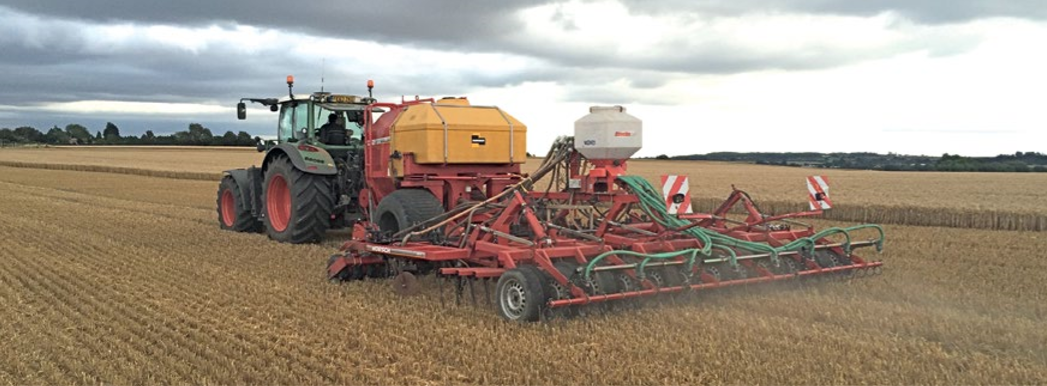
How To Start Drilling For £8K
Clive Bailye’s seed drill of choice is his 6m John Deere 750A , which has been used exclusively for 3-4 seasons. Last year, with an increased acreage, the founder and publisher of this Direct Driller magazine thought a second seed drill was necessary. Having just the one machine was a risk and in a difficult season would mean drilling was delayed. He looked around and found a good condition Horsch CO6 tine drill advertised in Germany.
Words and pictures by Mike Donovan
After delivery he rebuilt the coulters to a narrow profile so as to reduce soil disturbance. He says the tine drill is very useful driling after straw crops such as osr and also through the straw on second crop cereals.
Buying the drill from a German farmer was not particularly complicated, and provided him with a higher spec machine than Horsh sell in the UK. The seed dart tyres are much wider, and the machine is fitted with blockage monitors as well as full width front packers and also a liquid fert application system.
A sheaf of photos were taken, and Clive then asked for some of specific parts to show wear. The deal was done at under £5,000 which Clive says is the market value of these machines which are too large for small farmers to buy. Original owners like to buy new and sell when the machine is still in good condition.
Narrow tines with wear tiles
@Clive knew he wanted to make changes, substituting the Horsch tines and coulters for something far narrower, and has ended up getting his own design of tine made, which has a wear tile made from Ferobide, far harder than tungsten. The drill is on the farm primarily for osr and 2nd crop cereals drilled into chopped straw and the 25cm spacing is okay for these crops.
Comments on Clive’s on-line forum, TFF, said the drill many not be so good with beans, as the slot is a mere 12mm wide. And in barley the spacing may well be too wide as it needs to be thick. Clive points out that the seed pipe can actually be a bit wider than 12mm as it is in the shadow of the point. It would be good to have the option of using it for beans.

Above left: The cheap CO6 is being calibrated ready for its first outing

Above right: The adapted Horsch is being filled by the home built drill logistics trailer with seed and liquid starter fert.
Getting around the German instructions
The Horsch came, of course, with a control box and instructions in German. More on-line discussion revealed that English instructions were available on the Horsch website, and another explained that Horsch was sourcing some of these parts from Agton in Canada anyway. Zealman from New Zealand explained that the button marked with callipers should be held down for around 5 seconds. The menu is where you adjust the tramline sequence, valve layout and row numbers.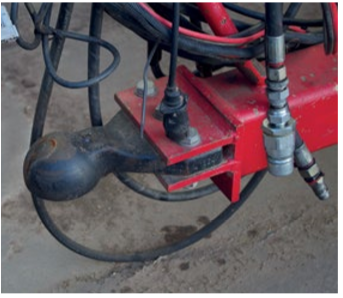
Ball hitch is a continental standard and provides a positive connection between tractor and drill

The Stocks Wizard has a rotor modified for Avadex which otherwise leaks everywhere
A Stocks Wizard is on the back of the drill and used for Avadex. Here again the knowledge of actual farmers is helpful. Alistair Nelson warned that the rotor and the surrounding shroud need to be changed, and he got good advice “from Rick at Stocks”. Clive has the same setup on the 750A and says that the Avadex leaks everywhere unless the modification is made. The drill was acquired and modified in 2016 and the results have been excellent.
The machine went through the residue without many problems and having the second drill has meant more timely planting. Clive has shown that moving into No-Till is not the expensive exercise so many farmers think it might be. The total cost, after modifications which included replacing all tines and coulters, was under £8,000.
Author Mike Donovan writes: we have featured a number of home made direct drills in @Practical Farm Ideas, and are always interested in seeing more. Please contact mike editor@farmideas.co.uk or 07778877514.
-

Defra Answers your SFI 2024 Questions
Written by Chris Fellows
After the interruption of a General Election, Defra have been able to get back to answering farmers 2024. The delay, which has been frustrating for all, has now passed and on the 26th September Defra delivered a webinar in collaboration with the Farming Advice Service (FAS) and The Farming Forum (TFF).
The webinar was lead by Farming and Countryside Programme Director, Janet Hughes, joined by policy leads working on SFI, and colleagues from the Rural Payment Agency and Catchment Sensitive Farming.
As with previous webinars, questions could be asked in advance by farmers on TFF or submitted via Slido. Given the popularity of the SFI discussion section on TFF, there were a lot of questions. If you didn’t get a chance to attend, Defra have now loaded their answers to questions onto the TFF thread (read via QR Code) and the webinar is available on demand.
If following reading the thread and watching the webinar, you still have questions, please feel free to ask your own question ono TFF and see what the collective wisdom of all the farmers on TFF can come up with in terms of answers. We know Defra monitor this section closely, it’s likely they will see your question too.
Read the SFI section on TFF here.


-
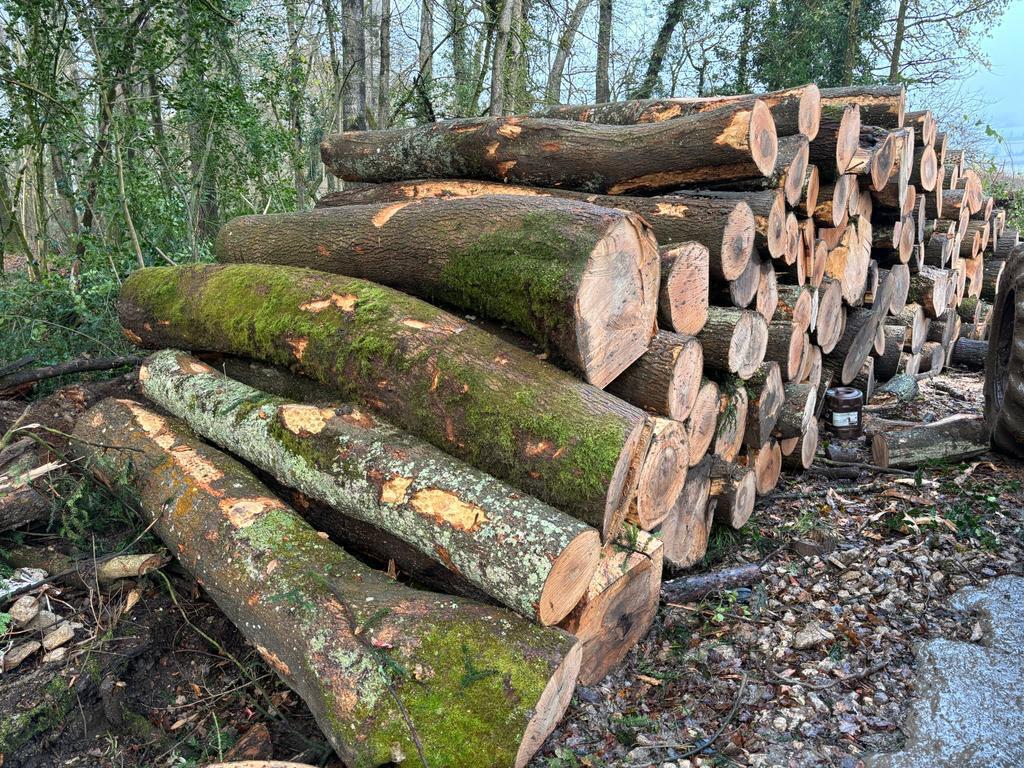
Farmer Focus – Tim Parton
September 2024
How one’s life can change between articles! You never think anything is ever going to happen to you! I can honestly say that it has been the worst year of my life so far! As somebody that has always taken health and safety seriously, you just never know what is around the corner and I urge you all to never take life for granted.
Thanks must go out to everybody that was kind enough to contribute to my Go Fund Me page. I still feel very humbled by people’s generosity, and I cannot thank you enough. Special thanks must go to Micheal Kavanagh for organising the whole thing. I must also thank Nick Woodyatt and Micheal for looking after the farm for me in my absence. Farming from pictures and telephone calls is a whole new experience when lying in a hospital bed; currently, at the time of writing, I am still in rehab, which seems endless! My time is also taken up keeping my website updated, www.timpartonfarming.com and writing my book. The devil makes work for idle hands!
It has been a difficult farming year on many levels with the amount of rainfall being high on the list of things to contend with and why it’s so important to keep soils covered. Heavy rain will cause a lot of surface compaction, which is something I see time and time again when out consulting and can be rectified so easily with a low disturbance lifter! Nothing can grow without air and I often see people having poor yields and blaming the system, when in truth it is they that are letting the system down by not being the farmer and rectifying the problem. The worst thing that happens to a farmer’s brain when they start direct drilling is that any soil movement is bad and that they are direct drilling now, so they condemn all soil movement. Quite often their soil is not ready for direct drilling and soon goes even more anaerobic, causing reduced yield and loss of income, when in truth yields should be the same or better when things are done correctly! I often hear the term roots are better than steel, which is true as long as you have got a healthy soil, but if your soil is not quite there, then a little light lifting is perfect to get the cover crop going. Where the real benefits can be achieved and where everything moves forward is when the farmer becomes the observer.
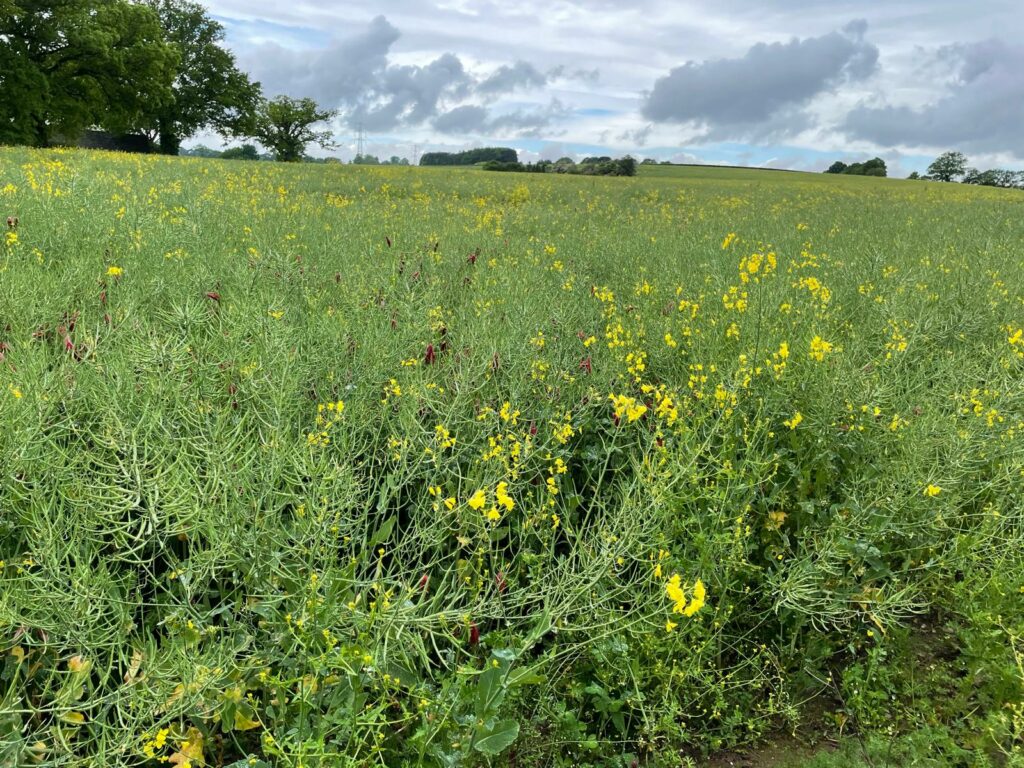
OSR (canola) came in well for the year at 3.5T/ha. The crop had looked well all year and as usual no fungicides have been used, just nutrition and biology as nature intended. Disease and pests only ever attack a plant that is in poor health and unfunctional from a photosynthesis point of view, basically the whole production system is broken!
Wood vinegar has proven to be a very useful product and one that we have used as part of the programme this last season, with good control against sclerotinia, Rhizoctonia, phytophthora, septoria and yellow rust, but I cannot stress enough that it has to be used as part of a nutrition/ biological programme. Everything is always building on each other to increase immunity and strength of the plant in order to achieve a functioning immune system, but as with all applications the right amount is critical especially at drilling which improves rooting and germination.
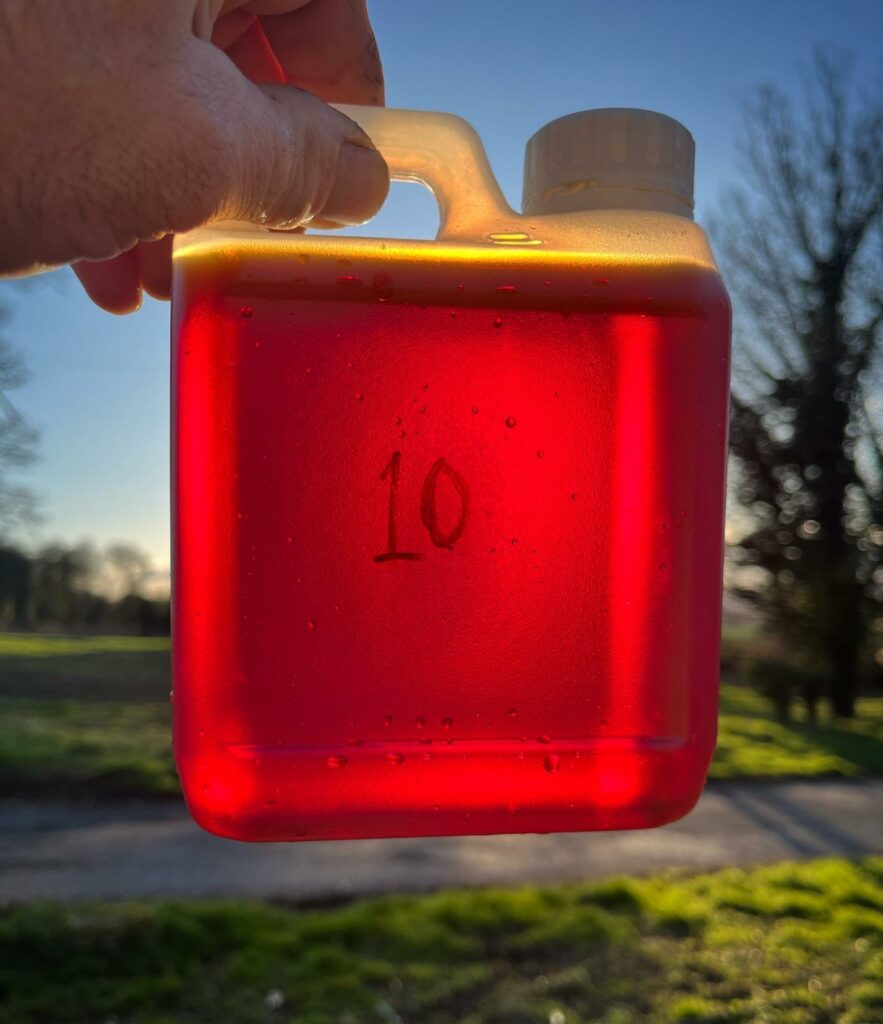
It is the first harvest that I have not been involved in since being a small boy, where I spent many an hour sat on the foot plate of the combine with my swimming goggles on to keep the dust out of my eyes, under my father’s watchful eye, sat at the helm. Farming was all I ever wanted to do from the time of walking, with many pictures to prove it. I have found it most frustrating to be lying in hospital on bed rest at the time of cutting my wheat, receiving pictures of the action and wishing that I was there. I miss the smell of harvest and the adrenalin rush! It has always given me a buzz seeing the year’s work come home.
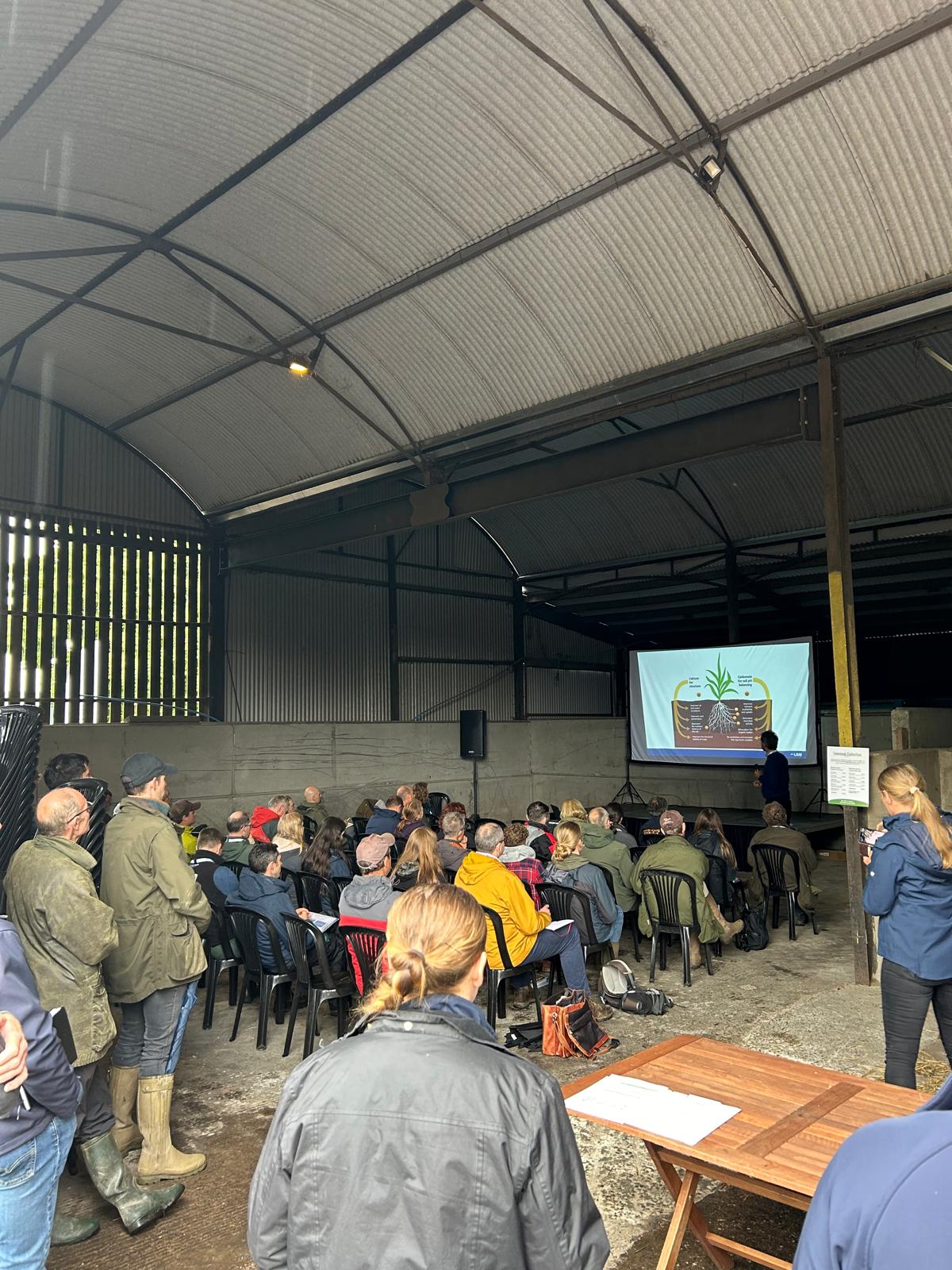

As Green Farm Collective we have been busy as ever with a fantastic conference back in May, hosted by Micheal Kavanagh, with numbers of attendees rising year on year, but also a sad day for me not being able to attend! We had a full programme of speakers, and I am told that there was a real positive vibe throughout the day. We have sold our first loads of regenerative wheat at 11.5 percent protein and on the day of movement we achieved a £88/ton premium over feed wheat, which is still pence on the end product. This is in recognition of the value of a regenerative wheat produced to our audited standards from FIA (food integrity assurance). This gives our customers the confidence to go on and sell our flour with the assurance that they are selling a genuine product for the health of the consumer. This has always been a vision of mine, to provide healthy food to the masses, otherwise it becomes a niche product for the upper middle classes, which in my mind will never have the desired effect on the planet or its inhabitants! Everyone needs to change the way they farm and consumers need educating on what they are eating and change their purchasing habits, something which we aim to facilitate within GFC. Together we begin to have a voice; as solos we go unheard! Join us and become part of the revolution within the history of the planet. Together we can make a difference!


-
Mycorrhiza manipulation: nature vs nurture
- Mycorrhiza can be added to systems physically via inoculation or encouraged from surrounding environments
- Inoculation strategies should be considered carefully given the ecosystem and climate in which they will be applied or they could act detrimentally or be wasted
- Future research is ongoing to validate inoculation tools for large-scale field use but more needs to be understood about the underlying molecular biology and genetics of mycorrhiza interaction before widespread application can be considered
Mycorrhiza and specifically ‘arbuscular mycorrhizal fungi’ (AMF) and Ectomycorrhiza (EcM) are important symbiotic fungi involved in the successful growth of the vast majority of plant species across the world. We have previously discussed their roles and strategies impacting their activities in an introductory article. The following article aims to expand on this by discussing the different strategies surrounding manipulating these species and the impacts of this on ecosystems, as mycorrhiza are well cited for their strong potential within sustainable food production.
Whilst it is agreed that there has been significant growth in the number of industries providing commercial mycorrhiza inocula for gardening, horticulture and agricultural amendment use, the effectiveness of these is subject to debate. Furthermore, additional approaches have been investigated for manipulating plant-mycorrhiza interactions which may be beneficial to consider for future strategies particularly given the outcome desires and funding support suggested in the ‘Sustainable Land Management’ (SLM) proposals.
Inoculations
As a concept, the inoculation of plants/soils with mycorrhiza species should improve the symbiotic benefits which can be achieved through interactions with pasture or crop plant species. Currently, much of the application of inocula relates to their use with starter (applied with seeds) and seed (coated on seeds) planting, as well as any transplanting of plant groups. In agriculture specifically, the most common use surrounds incorporation in cereal strategies as these are our mainstay crops. But we may be limiting their benefits by focusing solely on these systems.

Analysis of where and how mycorrhiza inocula from 68 products across Europe, America and Asia are used – taken from
Basiru et al. (2020)Whilst applying inoculations of mycorrhiza may seem like an obvious and simplistic way to achieve benefits, soil microbiome systems are highly complicated. Applying unknown mycorrhiza species can have knock-on impacts on below-ground ecosystems with unknowable short and long-term effects. In most situations, unlessthe surrounding landscape is highly degraded such that few or no ‘native’ mycorrhiza remain, utilising localsoil inoculantsare likely to be more viable, less disruptive and ultimately cheaper (particularly if they can be sourced from your own or nearby land). Essentially self-made inocula can be produced byharvesting soil inclusive of plant root structures from a natively inhabited or long-term productive piece of land. Processing this soil in such a way that root structures are broken down to ~1cm pieces allows the mixture to act as a mycorrhizal inoculate that could be added during the seeding of crops or transplantation. This process functions as mycorrhizal fungi have 3 distinct routes through which they can disperse to propagate in new areas.
These include soil-borne spores, mycelial fragments and transfer of colonised root pieces (as is the case in the inoculum described above). These provide the fungi with transfer routes via wind, water as well as animals. As such, when considering the application of mycorrhiza to crops and grasslands for their sustainable benefits it may well be more cost and labour effective to allow natural dispersal routes to do the job for you.Natural dispersal and inoculation can of course be enhanced and encouraged by providing the right environment. For example, providing a high diversity of plant species increases the likelihood of at least one compatible species being present for mycorrhizae species to form symbiotic relationships with. Utilising locally adapted plants can also help as these are more likely to have efficient locally-adapted mycorrhizal strains nearby. Furthermore, using little or no fertiliser addition will encourage initial symbiotic relationships more readily as plants will have a higher need to scavenge nutrients via interaction with fungi. Whilst this might lead to slower initial productivity, long-term it will lead to far greater nutrient use efficiencies.

Even when using commercial inoculant amendments most of the research suggests that mycorrhizae function more effectively the less fertiliser is applied, so inoculant applications shouldn’t be combined with higher fertilisation strategies. Meta-analyses of 100s of studiessuggest this and it is true of both AMF and EcM. The plant groups being used are also important as mycorrhizae have less impact when the plant group is already involved in its own N fixation such as with forbs.
The same meta-analysis suggested, that the presence of other non-mycorrhizal microbes (including bacteria and other fungi) improved mycorrhizal benefits on the plants. This suggests that land managers that wish to utilise mycorrhizal inoculations should consider their general soil health before applying mycorrhiza inocula, orthey should consider applying total microbiome inoculants alongside these (note: this would naturally occur with locally sourced soil inocula adding benefits to this option).
Problems with commercial inoculants may be the sourcing of the fungi used. Many papers suggest that native mycorrhizal strains are far more effective at adapting and forming symbiotic relationships with native crops and grasses than exotic non-regional strains. In some instances, there is even a suggestion that non-native strains actually impact the microbiome around them negatively which can make overall production drop or become unstable long term.
Other studies have directly compared soil-based native inoculations to commercially available inoculations and suggested that local soil inocula worked well as an inoculation strategy, better than commercial varieties in almost all aspects. It has also beenhighlighted that there are non-symbiosis impacts associated with some commercial inocula suggesting that some of the benefits seen with these commercial varieties may be due to the substrate containing nutrients (N, P, K etc), effectively acting as a boost of fertiliser, rather than due to the mycorrhizae actively integrating alongside the plant species.
These findings were echoed across other meta-analyses with the same general trends found. Furthermore, it was highlighted that larger effects of mycorrhizal inoculation were found in studies where soils were already highly degraded and lacking in rich microbiome diversity. Similarly, it issuggested that soil inocula outperformed commercial/experimental inocula even whencommercial inoculations contained a higher diversity of mycorrhizal strains suggesting that buying a mycorrhizal mix isn’t a quick fix to these issues.
Delivery strategies
Some interesting future considerations in development for boosting the effectiveness of soil inoculations involve looking at the delivery mechanisms of the mycorrhizal fungi to the plants in soils. Alongside issues surrounding inoculations discussed above, there is also research suggesting poor survival rates of inocula in storage, transport and in soils due to environmental and other factors. One approach that could combat this is seed coating, whichis already a technique being used commercially to protect seeds, making them easier to plant (due to manipulating weight and size) and to incorporate growth promotion via combining with nutrients and microorganisms for example.
Seed coating can also reduce the inocula application dosages needed compared to solid and liquid amendments, as they are protected from environmental losses. To take this further some interesting experimentation surrounding nano-particle inclusion in seed coating strategies has shown the ability to reduce inoculant dosages by 97% whilst maintaining growth benefits and could make resource efficiency even better in the future. Overall, benefits have been shown in reviews for seedling establishment, germination and improving yields with lower nutrient fertilisers applied, but it is still noted that a better understanding of soil microbiome interactions is needed in many situations to ensure such strategies function in situ in fields.

Summary
Mycorrhiza manipulation and considerations are likely to become increasingly important when considering future sustainable agricultural production practices. Whilst there are currently a large number of gaps in our knowledge with regards to specific interactions dependent on factors such as plant species, mycorrhiza species, abiotic factors and biotic factors. There is a wealth of research suggesting some general trends of functionality which are useful to understand. Local inoculants or allowing native nearby mycorrhizal systems to propagate naturally currently seems more viable than commercial inoculants in all but the most extreme scenarios. A summary of the considerations surrounding the use of mycorrhiza inoculation is as follows;





-

Restoring farmland biodiversity: The Allerton Project
The Allerton Project, as a research and demonstration farm, has been in operation since 1992. We are, however, a part of the wider Game and Wildlife Conservation Trust (GWCT), a membership organisation who have been conducting conservation science to enhance the British countryside for over 90 years. Today, the GWCT’s Farmland Ecology Unit carries out some of the most important research into nature friendly farming that is undertaken in this country, and is of international significance.
One of the jewels of GWCT research is the ‘Sussex Study’, the longest running monitoring project in the world that measures the impact of changes in farming on the fauna and flora of arable land. Since 1968, it has been conducted annually across 3200ha of land owned by the Duke of Norfolk on the Sussex Downs, between Arundel and Worthing. The starting point of the study was to determine the causes for the decline of the grey partridge, the iconic bird which forms the logo of the GWCT. Sadly, the British Trust for Ornithology recorded a drop in numbers of 91% between 1967 and 2010, a trend which has seen little national improvement in the past decade.
It was determined by the GWCT that the main reason for their decline was a reduction of chick-food insects in cereal crops caused by the disappearance of arable weeds such as the prickly poppy, cornflower and narrow-fruited knotgrass, given that such insects are the sole food source of recently fledged partridge chicks, which hatch in early-mid June. (In order to keep the dataset consistent, at least 100 sites (always arable fields) are monitored in the third week of June by hoovering up the invertebrates present with a ‘D-vac’). Ultimately, a lack of insect food was leading to the starvation of many hatched chicks, with the loss of arable weeds via agricultural intensification leading to the loss of both a habitat and a food source for those vital farmland invertebrates, the prime species of which are:
- Caterpillars (lepidoptera)
- Hoppers (homoptera)
- Bugs (heteroptera)
- Click beetles (elateridae)
- Sawfly larvae (symphyta)
- Leaf beetles (chrysomelidae)
- Weevils (Curculionidae)
- Ground beetles (carabidae)
The figures collected on the decline of these populations is stark; overall invertebrate abundance decreased by 37% across all taxa (a group of one or more populations of an organism or organisms) with 47% of taxa in decline (and 16% increasing). Yet beneath those headline figures, the study shows that insect predator species declined by 67% on average, while crop pests increased by an average of 26% (if aphids are excluded, which actually recorded a 90% reduction in population size). Happily, in this study at least, pollinator populations remained broadly stable.
The data of the Sussex Study indicates that the majority of the invertebrate population decline occurred in the early decades of the work, and particularly in the 1970s, before stabilising (though still on a generally downward trajectory). This reflects the rapid and generalised intensification of agricultural land use in this period, much of which was captured by the GWCT in the form of field application records and land use. In the study area, as across much of the country, there was a marked decline of broader, more traditional rotations from 1970 as the area put down to spring crops and rotational grass declined, and the area of winter cereals increased along with average field size. There was also a general increase in the intensity of pesticide usage across the decades, largely in line with national trends. Although herbicide and fungicide use are currently at historically high levels across the study area, insecticide use peaked in the late 1980s, again in the mid-2000s, but has decreased significantly to the present day.
The GWCT has developed a metric called the ‘Chick Food Index’ (CFI) to determine the health of a population of farmland invertebrates to support a range of farmland birds. Different bird species will have a different CFI, but for grey partridge the figure is 0.7 – i.e. we need to see an invertebrate population of 0.7 to enable a grey partridge colony to maintain its current size. Worryingly, in a recent GWCT survey of ten farms nationwide between 2018-2020 across hundreds of grass, arable and horticultural fields, in no situation did the CFI rise anywhere near 0.7. Perhaps even more concerningly, where the same process was repeated in a range of agri-environment margins, the same result was obtained. In short, we do seem to be facing a generalised decline in our insect populations, with all the implications that has for farmland ecosystems. This is a trend which we know is also being experienced globally, with a 1-2% reduction in invertebrate numbers being reported annually.
I would be the first to say that agriculture is not the sole cause of the decline of invertebrate biodiversity – and that even where it is largely to blame, farmers are only reacting to the pressures of a society which demands ever-cheaper food, but dislikes asking questions of it. However, with agriculture covering some 70% of the UK landscape, and the implications of the historic intensification of agricultural practices for all manner of farm wildlife being well established, it’s clear that we do have our part to play in reversing this downward trend. And here too GWCT research has something to say.
Although grey partridge numbers nationally have continued to fall since the 1960s (including in some parts of the Sussex Study area), in parts of the estate where extensive measures have been put in place to recover their populations we have seen a significant increase in numbers since the mid-2000s – alongside other species such as skylark, lapwing and linnet. Such measures include the creation of beetle banks and hedgerows to break up larger arable fields and encourage the development of invertebrate populations within them, the establishment of grass strips and unharvested, low-input conservation headlands around field edges, and the provision of supplementary feeding for farmland birds through the winter. It also includes establishment of bespoke wildflower mixes, such as the GWCT Advanced Wildflower PARTRIDGE Mix which has been extensively trialled and developed to deliver the best outcomes for farmland birds and invertebrates throughout the year. It contains more than 20 species, both annuals and perennials (and primarily native), and has the potential to last for a full decade if managed correctly. Insect abundance in this mix peaks after around six years.
Other GWCT research also points the way toward healthier invertebrate populations on farm, for example indicating higher populations of pollinators on farms which have adopted ‘regenerative’ farming practices – primarily wider, more diverse rotations and the establishment of pollen and nectar margins and legume-rich rotational options, as well as more sympathetically managed hedgerows with a greater profusion of flowers. At the Allerton Project itself, we are part of the Rothamsted moth monitoring network, and for the past thirty years we can demonstrate an increase of around 35% in our macromoth populations, while at the national scale there has been a decline of around 35% in the same time period. This we have managed at the same time as retaining our core identity as a productive, ‘conventional’ and primarily arable farm. It’s also well established that many invertebrates – such as carabid beetles, which can play an importance role as crop pest predators – live part of their lifecycle in the soil, and therefore reduced tillage can play an important part in enhancing such populations.
The new options available to support Integrated Pest Management (IPM) via the Sustainable Farm Incentive (SFI) will do much to help many farmers think more carefully about farm invertebrate populations, but it must also be recognised that insecticide and herbicide use is only one part of the picture, and that the broader scope of SFI and other potential income streams must be utilised to build up the ‘green infrastructure’ needed across a farm to start to build beneficial insect populations. Simply going ‘cold turkey’ on inputs is likely to lead to decreased yields and disillusionment. That’s why the Allerton Project has put together a practical guide for farmers – ‘A guide to insect-rich farmland habitats’ – which is available online, and we are always open to groups of visitors to come and see some of the work which we have undertaken in our living lab landscape over the past 32 years.


-
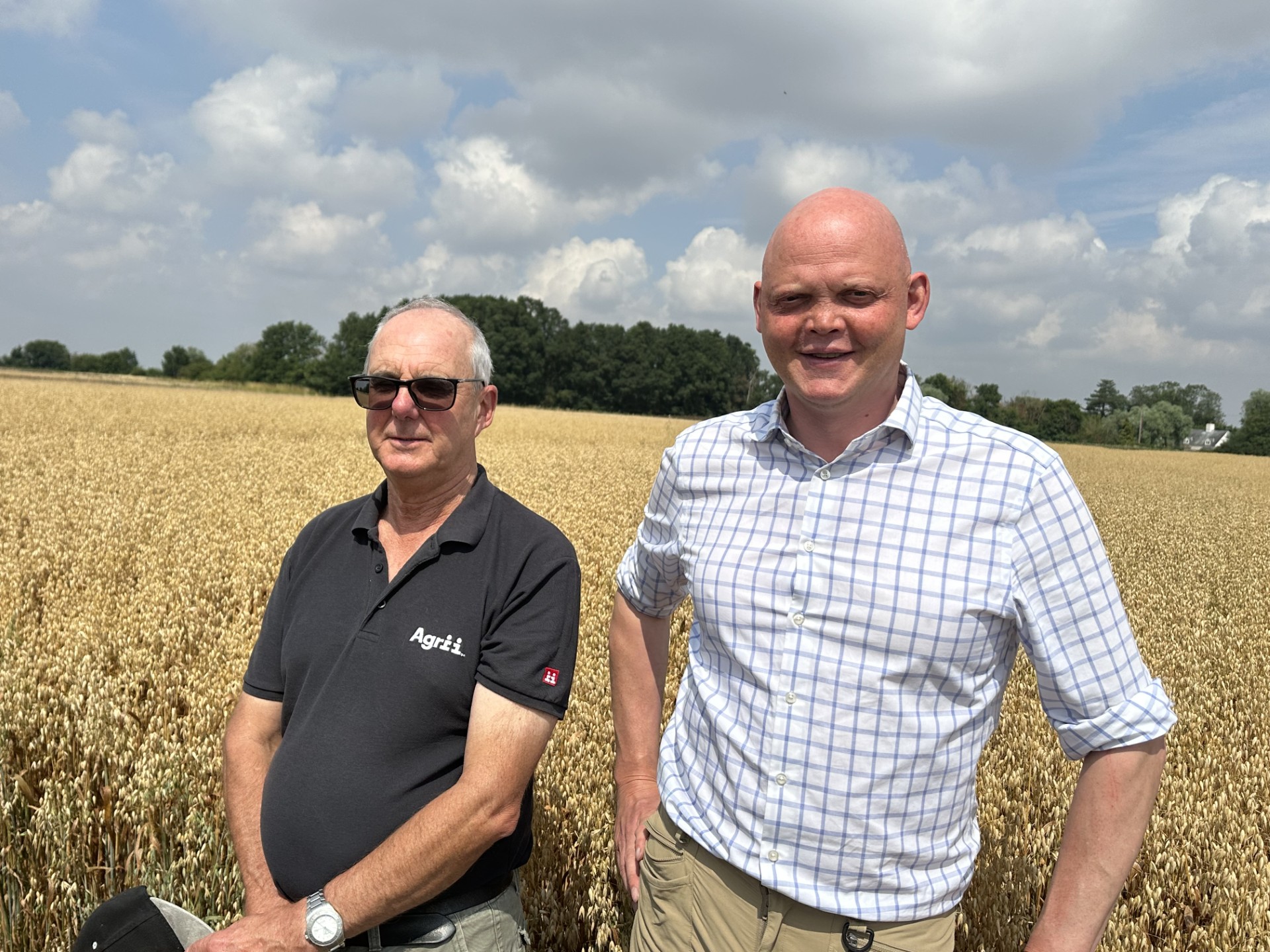
Stow Longa delivers vital insights into carbon and nitrogen efficiency
With its current trials programme now entering its tenth year, Agrii’s Stow Longa site, near Huntingdon, continues to provide new crop production insights with some of the latest being the carbon footprint implications of different cultivation methods and just how much blackgrass can reduce the efficiency of nitrogen applications.
With the need to use inputs as effectively as possible in modern crop production, the impact of cultivation choice and blackgrass control method can have a major effect not just on the profitability of a farming business, but also its carbon footprint.
“Over the years at Stow Longa, we’ve learned a huge amount about rotations, crop establishment and blackgrass control, with the sustainability agenda increasingly effecting the way we look at our cropping,” says Agrii seed technical manager John Miles.
“But one thing it is impossible to get away from is the importance of yield in the equation and this is very much the case when looking at nitrogen use efficiency (NUE) and carbon.
“While it’s often assumed reduced cultivations will result in less fuel consumed and a correspondingly lower carbon footprint than plough-based approach, making a direct drill system work effectively means this is not always the case.
“They can be much closer than many think and this was certainly the case on Stow Longa’s heavy soils when several passes of a straw rake, combined with a low-disturbance sub soiler, were factored in.
“Using information supplied by equipment manufacturers, diesel use estimates were 25litres/ha for ploughing and 17 litres/ha for direct drilling using an LD leg and straw rake, with fuel for drilling on top of this.
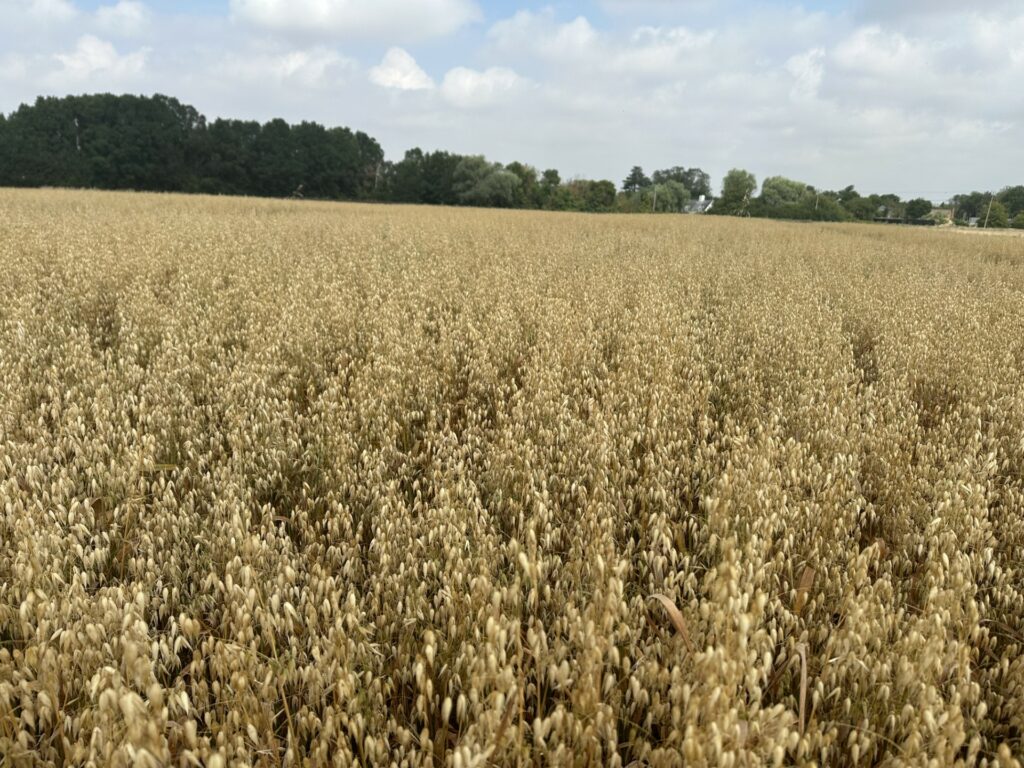
Spring oats have outyielded spring barley in sub-optimal seedbeds at Stow Longa, but not in better ones. Importance of yield
The results become more interesting when looking at yields and CO2e per tonne of production, he points out.
“We used greenhouse gas figures from ADAS Yen Zero, which pitches the ploughing option as the worst in terms of greenhouse gases/ha at around 1350 kg/ha compared to direct drilling at 372 kg/ha – which is a big difference.
“But with a spring barley yield of 9t/ha for ploughing, for example, the carbon is 155 kg/t whilst it is 176 kg/t for the direct drilling approach with its lower yield of 6.5t/ha – much closer and much more relevant when it comes to grain marketing options.
“Early results from 2024, however, suggest use of the low disturbance subsoiler, used in good conditions, with a stubble rake and a more successful cover crop, have reduced the yield difference between ploughing and direct drill approaches to around 0.4t/ha.
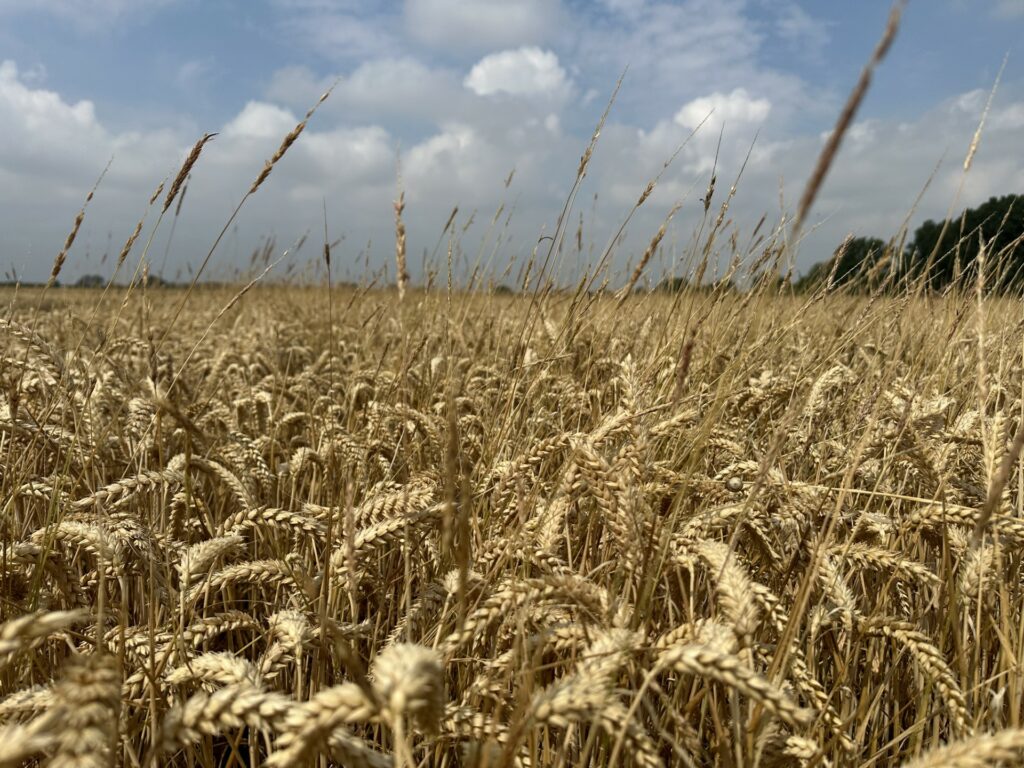
Stow Longa results suggest every 100 ears/sq m of blackgrass results in a yield loss of 1t/ha. “So, it will be interesting to see how this affects the carbon footprints – we’ve closed the yield gap but we’ve used more diesel, too.”
There are many lessons still to be learned from Stow Longa and it remains an invaluable tool in the company’s R&D armoury for the future, John Miles believes.
“With nitrogen being such a large component of both the cost and carbon footprint of crop production, Stow Longa’s findings of the effects of blackgrass on NUE, for example, are extremely compelling.
“We know every 100 ears/sq m of blackgrass results in a yield loss of 1t/ha, so it’s a double whammy to realise your costly nitrogen applications are feeding this, too.
“In spring barley crops with little blackgrass we’ve seen yields at Stow Longa of 9t/ha from about 120kg N/ha which equates to an NUE of over 90%.
“Others with higher blackgrass levels, but the same level of nitrogen application, have produced a yield of 6t/ha resulting in an NUE of little over 60%.
“So, the bottom line is whether it is optimising profitability, carbon footprint or NUE, achieving high yields is still an incredibly important objective.”


-

Farmer Focus – John Pawsey
September 2024
Alice and my pre harvest holiday was with Wild With Consent whose website promises ‘This is wild camping, but not as you know it’. I have always asked for Alice’s consent before going wild otherwise she would have me arrested. What the website actually meant that we could camp in a remote place on somebody’s farm without the landowner showering us with some animal’s excrement. It is that kind of consent.
If was also a fact-finding mission. We have just placed a pitch on our own farm on the Wild With Consent website and so we wanted to check what other farmers were offering to make sure that our Shimpling pitch was up to scratch.
The deal is that once booked you get a What Three Words reference giving you the exact pitch location, personally checked by the Company’s owner to be wild enough, and all you have to do is make sure that you leave no trace of human presence when you vacate your allotted spot.
Not being a natural camper I immediately took to the World Wide Web to find a huge fridge to cool alcoholic beverages and bacon, a mattress that would self-inflate before I had reached the top of our roof top tent’s stairs and a power input to ensure that communication with humanity could be accessed at all times. Because Alice had said that it was illegal for me to dig a hole to naturally fertilise the periphery of our remote home, I spent an inordinate amount of time researching a natural portable loo, as being of the organic persuasion it is against my principles to sit astride the chemical version. Huge success in that department. All I can tell you is that it involved a tripod, a biodegradable plastic bag and copious amounts of sawdust. It was a triumph.
Alice did say that with all the money I had spent on “stuff” it would have been cheaper to stay in a five-star hotel. “But this will be fun” I said. I can’t remember exactly what she replied but I’m pretty sure it involved a sharp implement and me tackling a piece of gymnasium equipment.
Our destination was the Lake District but also to cram in as many locations as possible over the six days we were away to fulfil the research element of the holiday.
Dreadful planning on my part meant that night one (Leicestershire) was the evening of the World Cup final. Fortuitously during my spending spree in the quest for camping comfort I had purchased a dongle with unlimited data. With the roof tent erected, awning splayed, chairs and tables positioned, iPad streaming that fated game and with views over the verdant Cottesmore Country, Alice began to warm to the situation. However, my pièce de résistance was producing some fizzy wine, chilled by the aforementioned fridge, which seemed to cheer her up no end.
I’m not going to lie, the first two nights were a little grizzly as we acclimatised to a sheet of canvas between us and the outside world, negotiating the roof top tent’s ladder at 3am in the morning to answer the call of nature without falling out of said tent like a sack of potatoes and the fact that because most of the locations were so wild that there was no phone signal. But by the third night we got into a routine and went slightly native on the whole camping thing. With all devices severed from the outside world we also discovered the art of speech and found out that even after nearly thirty years of marriage we still actually quite liked each other. Oh, and books made out of paper, you should try one, the battery life is amazing.
Following Leicestershire, we had three nights in Cumbria and on the way home a night in Yorkshire. We ended up by loving the whole experience. Wild With Consent, you have to try them and suggest a pitch on your own farm so that we can come and see you too.
You are probably wondering where all this is going. He hasn’t mentioned a direct drill yet which I fully intend to but first I do want to tell you about two things that happened in the Lake District.
Firstly, Alice and I spend a day’s walking up to Angle Tarn and experienced the most amount of weather I have ever been exposed to in my life. Being north of Suffolk I assumed that no sun cream would be necessary on my bald head during the trek, but I was wrong. I don’t care what the boffins tell you, they do have that fiery ball north of Preston so much so that I had to bathe my bald head in the tarn to cool my third-degree burns. Then in a flash the weather gods threw hail stones at us like cricket balls, we were lucky to get away with mild concussion. Quite what farmers up there know what to put on in the morning is a mystery to me. Flat cap or a hard hat? String vest or Sou’wester? Tricky. I’ll never complain about our Suffolk weather again. Also the Cumbrian landscape goes up and down a lot which meant that our under-developed East Anglian calves screamed in pain on the way up and then on the way down we discovered that we had no actual muscles around our knees. Our biggest climb in Shimpling is upstairs to bed.
The second thing I want to tell you about while lakeside is a conversation I had with the famous organic Cumbrian farming influencer, James Robinson or as we Twitter (X) fans know him @JRfromStrickley.
James and I have bumped into each other at various organic and regenerative events over the years, but I felt that I had never really sat down and chewed the cud with him, and since we were in the area it seemed rude not to meet up.
Having just been to Groundswell and then the National Organic Crops event I was curious to know what Jame’s take was on the rise of regenerative agriculture and he said a really interesting thing. In the context of organic verses regenerative farming he said, “I think that the ambition of regenerative farming is limitless”. I was sort of taken aback as to me his statement suggested complacency in the organic sector.
The main thrust of James’s point was that organic certification took us to a certain point in terms of it’s standards but once you had achieved those standards that was it. Job done. Sure, there are lots of practices in those standards that align and go further than regenerative farming principles but the ambition stops once they are met.
I began to think about my recent organic inspection. Part of the annual routine is a drive around the farm checking that I have done what I have said I have done. Does it look like we have been spraying any pesticides? Have we got sufficient physical barriers between us and our neighbours to reduce the risk of spray drift? Samples are taken of forage, grain and soil and sent off for analysis to check if we are lying. The inspection feels like a test. It should be a celebration.
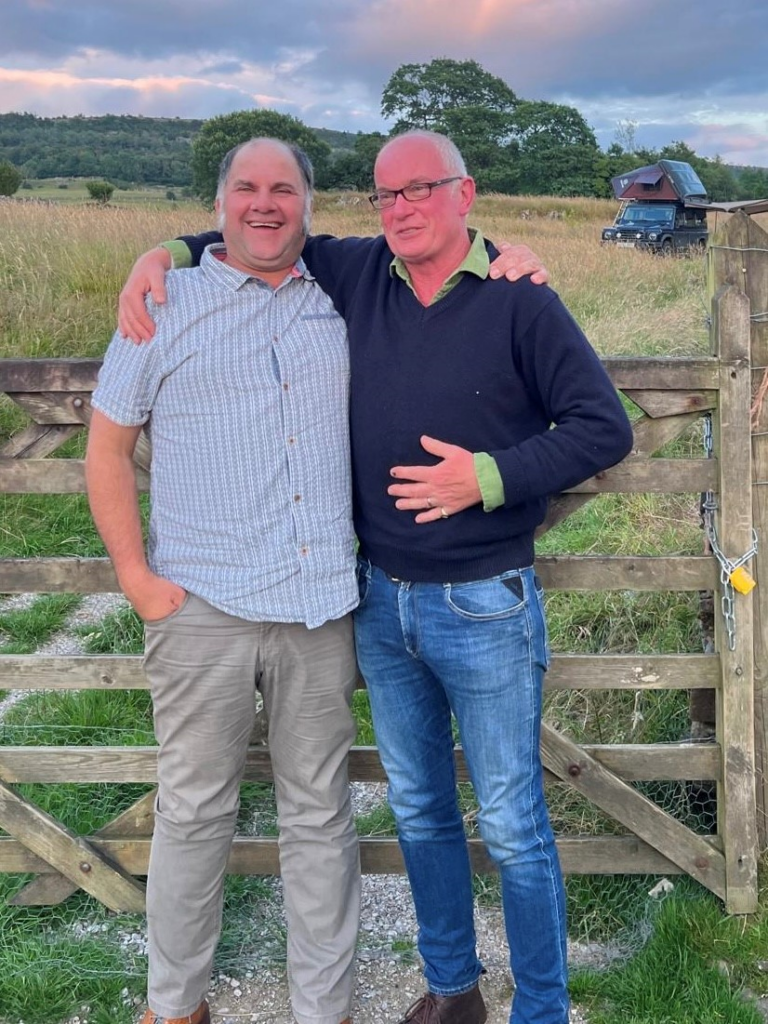
Soil is checked traces of pesticide and not soil health or any increase of organic matter. Tillage methods go unquestioned. A sustainable rotation has to be demonstrated but it’s requirement is pretty basic. Bi-cropping or any multi-species cropping is not a thing. No mention of the use of cover crops or to keep the soil covered. Other than complying with the rules there is no expectation of agroecological progression. No ambition. And it’s possibly why you do come across some organic farms that don’t look very “organic”.
Well reader, you will be happy to know we are doing all of the above at Shimpling Park Farm even though our inspection doesn’t document it and that takes me to the final point that James made. “We have to go beyond organic”. I’ve been to James’s farm and he certainly does.
I want our inspection day to be one of celebration. Smelling healthy soils rather than packaging samples for testing. Walking in our crops to witness food and nature in the same place rather than focusing on segregation. Recording innovation within our rotation rather than ticking a box to demonstrate adherence to basic agronomy.
In my previous December submission, I argued the validity of organic standards verses regenerative principles, but we do have to be honest about where just achieving the organic standard is limiting best practice.
We need our farms to feel organic rather that a farm that doesn’t use any pesticides. Equally, our farms must feel genuinely regenerative rather than just a farm with a direct drill.
There, told you I’d mention a direct drill.


-
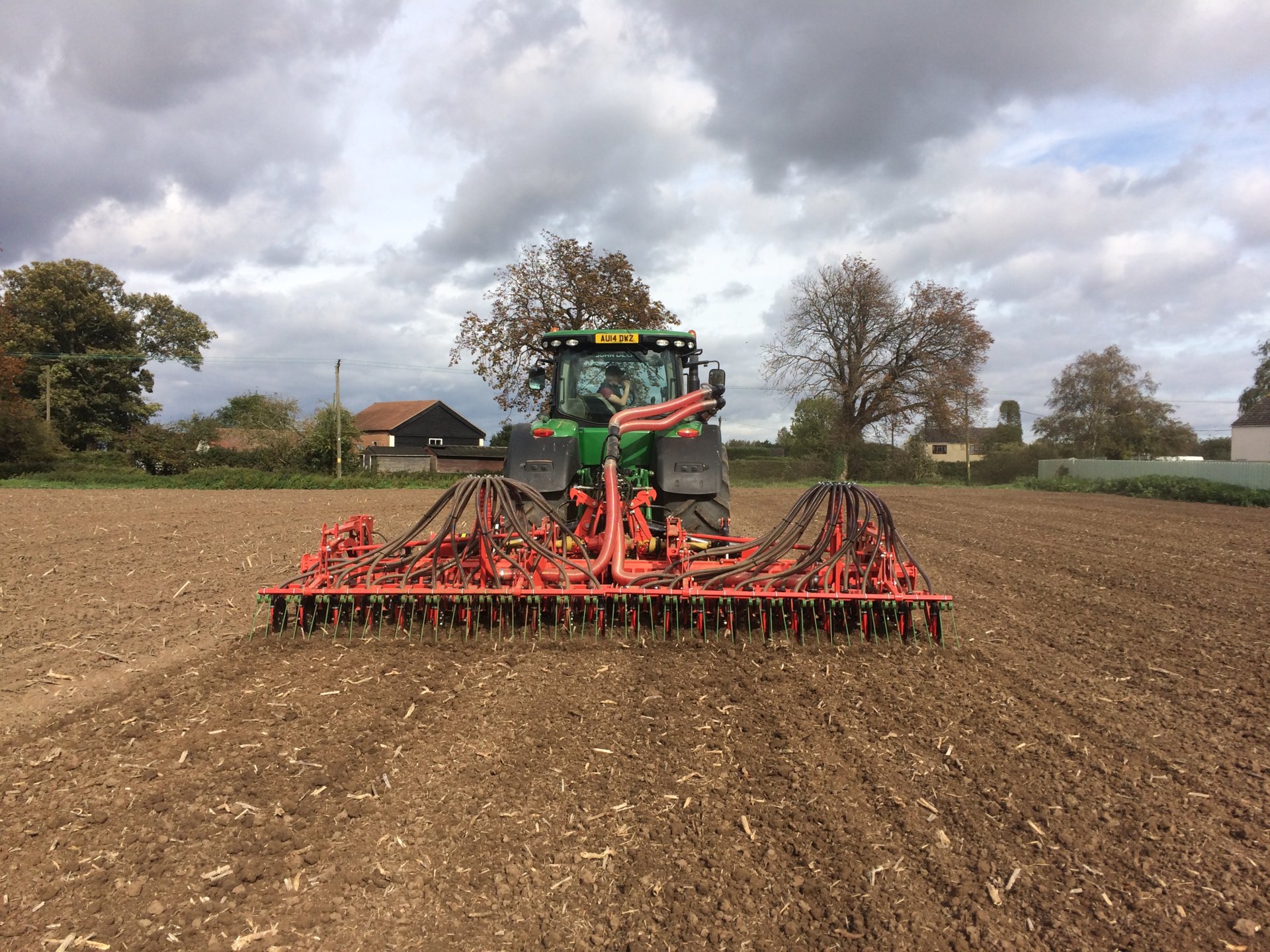
Glyphosate or tillage: which is worse for soils?
Which is the lesser of two evils – glyphosate or tillage? That’s what Rothamsted Research’s Prof Andy Neal has been trying to find out
Written By Mike Abram
Glyphosate or tillage – which will do more damage to soil health? It’s a question that has exercised both regenerative farmers and the organic sector from different sides of the same coin.
It also provoked some practical weed control concerns for zero-tillage growers looking to grow crops for Wildfarmed, particularly when a three-year agreement term for a field was being proposed.
While Wildfarmed has rowed back on that proposal, and now effectively allows the use of glyphosate to terminate cover crops, for example, before a Wildfarmed crop is sown – its terms say no pesticides can be used in the growing crop – the debate about which is least damaging led to some research involving Rothamsted Research’s Prof Andy Neal.
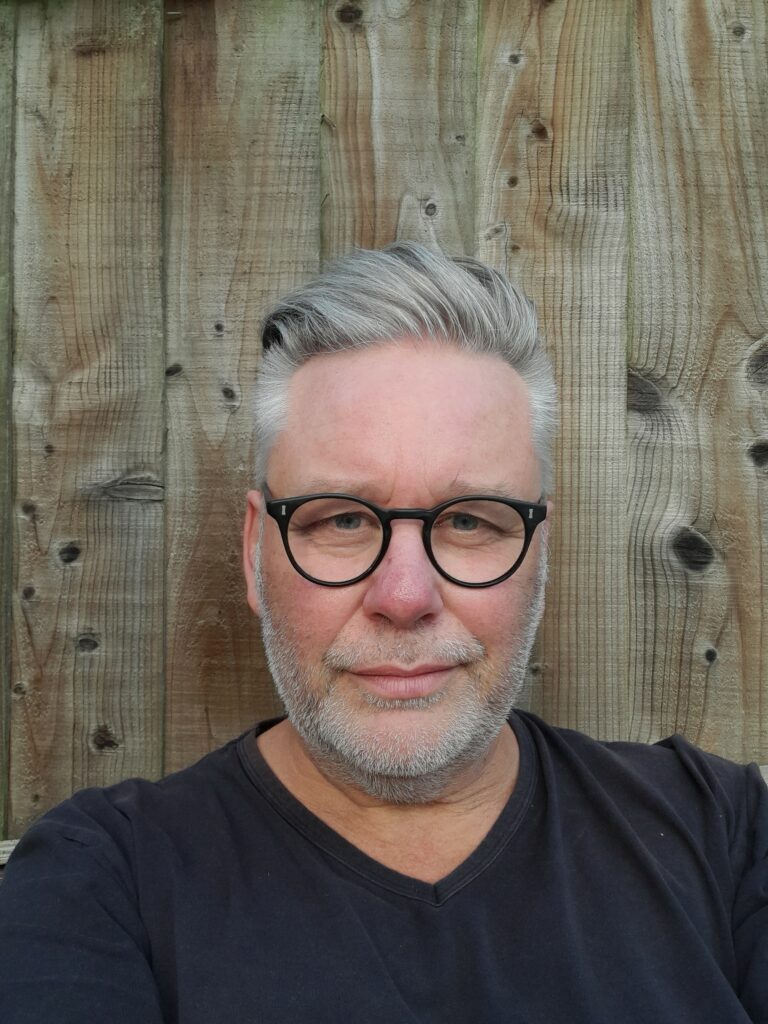
“We were particularly interested in understanding whether it is possible to use glyphosate sensibly and responsibly while still looking after soils,” he told delegates at the Green Farm Collective’s annual regenerative farming conference in May.
That research is still ongoing, with further funding being sought to deliver more insights, but through Andy’s understanding of how soils work, he’s already starting to think about what glyphosate and cultivations are likely to do to soils, as well as look to other research.
Evaluating the risks from glyphosate, he explained glyphosate was broken down microbiologically. “We know this can occur aerobically or anaerobically.
“But in the absence of oxygen it occurs much more slowly. So, when we think about applying glyphosate to soil, ideally that soil would be full of pore spaces and oxygen because under those circumstances we can guarantee it would be broken down as rapidly as possible,” he said.
That suggested there were certain circumstances growers should be considering whether their soil was in a fit state to degrade glyphosate rapidly, and whether growers should address soils in a poor state first, he said.
There were interesting impacts on pore space in the trials Andy conducted in conjunction with Green Farm Collective co-founder Tim Parton last year. These compared long term zero-till soils with soil that had been cultivated shallowly to around 5cm depth for the first time in around 14 years.
X-Ray computed tomography analysis of the two soils performed at the University of Nottingham’s Hounsfield Facility suggested, initially after one week, that cultivating soil had increased pore space, Andy said. “But within seven weeks the soil had slumped and the pore space that had been created had been lost and had a slightly smaller maximum pore size than in the zero-till soils.

“So there is definitely an effect in these no-till systems of cultivation. It directly affected the maximum size of pore space and resulted in a gradual loss of mean pore size.”
Both soils also had glyphosate applied at two different rates – 4 L/ha and 2.5 L/ha – with a compost tea and fulvic acid, and, while further funding would have been useful for more analysis, Andy was unable to detect any glyphosate residue in the soil within a month of treatment.
“Degradation of glyphosate was apparently quicker in the cultivated soil,” he added, suggesting that could have been because of greater levels of oxygen in the surface layers as a result of the cultivation.
“These are very preliminary findings, but it does suggest we can manipulate the rate at which glyphosate is degraded in the soil.”
Of greater importance was that because oxygen was required to break down glyphosate at faster rates, driving organic matter into your soil was the first thing you needed to think about doing as that created structure, pore spaces and aerobic soils, he suggested.
He also looked at research about whether glyphosate applications impacted microbial communities, but recent meta-analysis of 36 studies involving 556 measurements suggested there was no significant change in the microbial biomass because of adding glyphosate.
“What did change was the rate at which those microbial communities were respiring,” he noted. “That’s often thought about as a positive thing – you can do soil tests measuring respiration and it’s assumed greater respiration means a healthier community.
“But that’s not always true. For example, when we’re feeling unwell our respiration rate increases. It’s why we have high temperatures.
“So it would be easy to assume this is a positive influence of glyphosate, but what I think we are seeing is a measure of the stress imposed upon communities as a result of adding glyphosate. It doesn’t mean it is a lethal effect, but means the communities are working harder to break down that glyphosate or to overcome some other effect.”
A second set of studies compared soils where glyphosate had been applied regularly for a long period against organic farms in Maryland, Mississippi and Washington states in the US, with the aim of identifying any changes in microbial community as a result of applying glyphosate.
But what the studies found was that other factors, such as annual variation or how the soil was managed, had a much greater influence on the microbial communities in the different soils than the application of glyphosate.
What those experiments didn’t consider was what those microbial communities were doing, he pointed out. “That’s what we’ve been trying to understand with the Wildfarmed trials on Tim’s farm. We know microbial species change happens, but what’s important is understanding the way microbial function changes as a consequence. That’s what we’re looking to achieve in the next few years,” he said.
So what about the impact of cultivations on soil health? Evidence from Rothamsted’s North Wyke site in Devon suggested that just one year of ploughing reduced organic matter from 6% to 3% when converting fields that had been in long term pasture into an arable system.
“From the trials it suggests it takes roughly seven or eight years to recoup the carbon that was lost under a pasture, as long as no further tillage takes place,” he added.
A second series of trials he highlighted were at FarmEd in the Cotswolds, where the farm incorporates grazed herbal leys into a cereal rotation. Andy has been investigating the impact of multi-species herbal leys on soil structure and the consequences of moving from herbal leys into arable in the rotation.
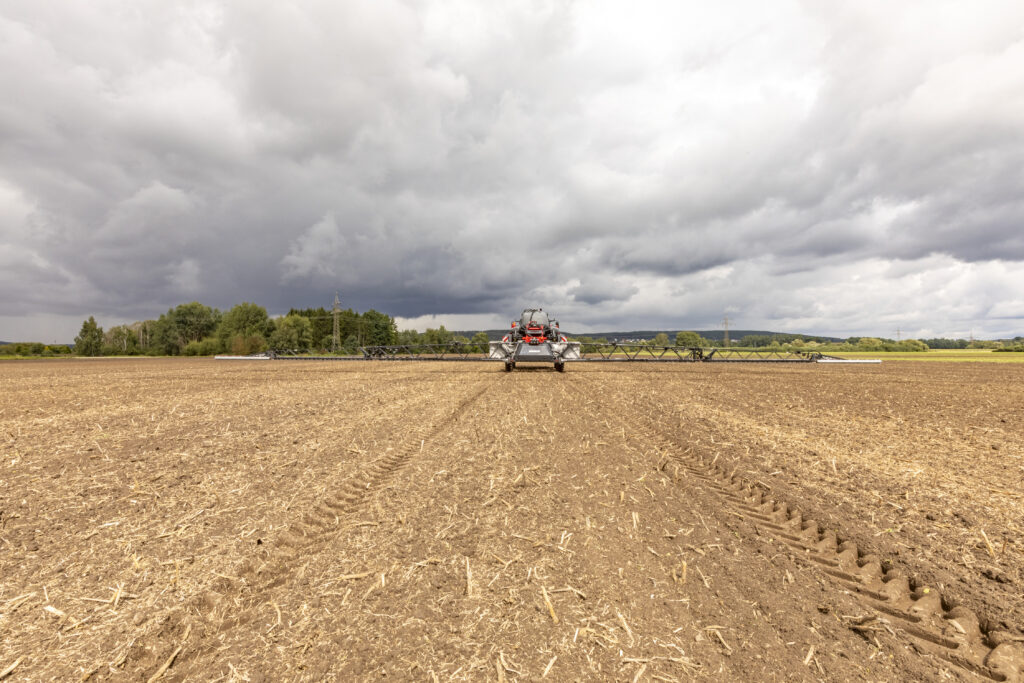
“We looked at several different treatments on the farm, including a permanent pasture. The four-year herbal ley had the largest amount of pores of any treatment – it had developed a nice structure, which would drain well and hold an awful lot of water.
“But we were shocked that after ploughing shallowly to 10cm, plus two power harrow passes, rolling and drilling reduced the amount of pore space significantly. We would predict this soil will now drain poorly because it will be difficult for water penetrate, and for it to hold onto what water does penetrate because of the lack of pore space.”
Connected pore spacing was crucial for optimal soil function, he explained. “And there is a clear connection between the amount of organic matter that goes into your soil and pore spaces.”
That connection was much stronger in soils with significant clay and / or silt content, and less so in sandy soils, but in those soils with the right texture higher organic matter equalled high porosity leading to a high flux of nutrients and oxygen through the system.
“That will give you a high nutrient use efficiency. Anaerobic space [caused by poor soil structure and lack of connected pores] causes the selection of microbes that use nitrates rather than oxygen to respire, resulting in the production of nitrous oxide, low nutrient use efficiency and high greenhouse gas emissions.”
The implication of making the connection between organic matter, connectivity between pores and soil structure was in how growers might manage how they use organic matter on farm, he suggested.
“If you want to make the biggest impact with small amounts of organic matter you might invest them in clay soils you know to be low in organic matter because that’s where you’re going to see the maximum benefit in improving water holding capacity and improving lots of other metabolic issues associated with anaerobic respiration with microbes,” he concluded.



-
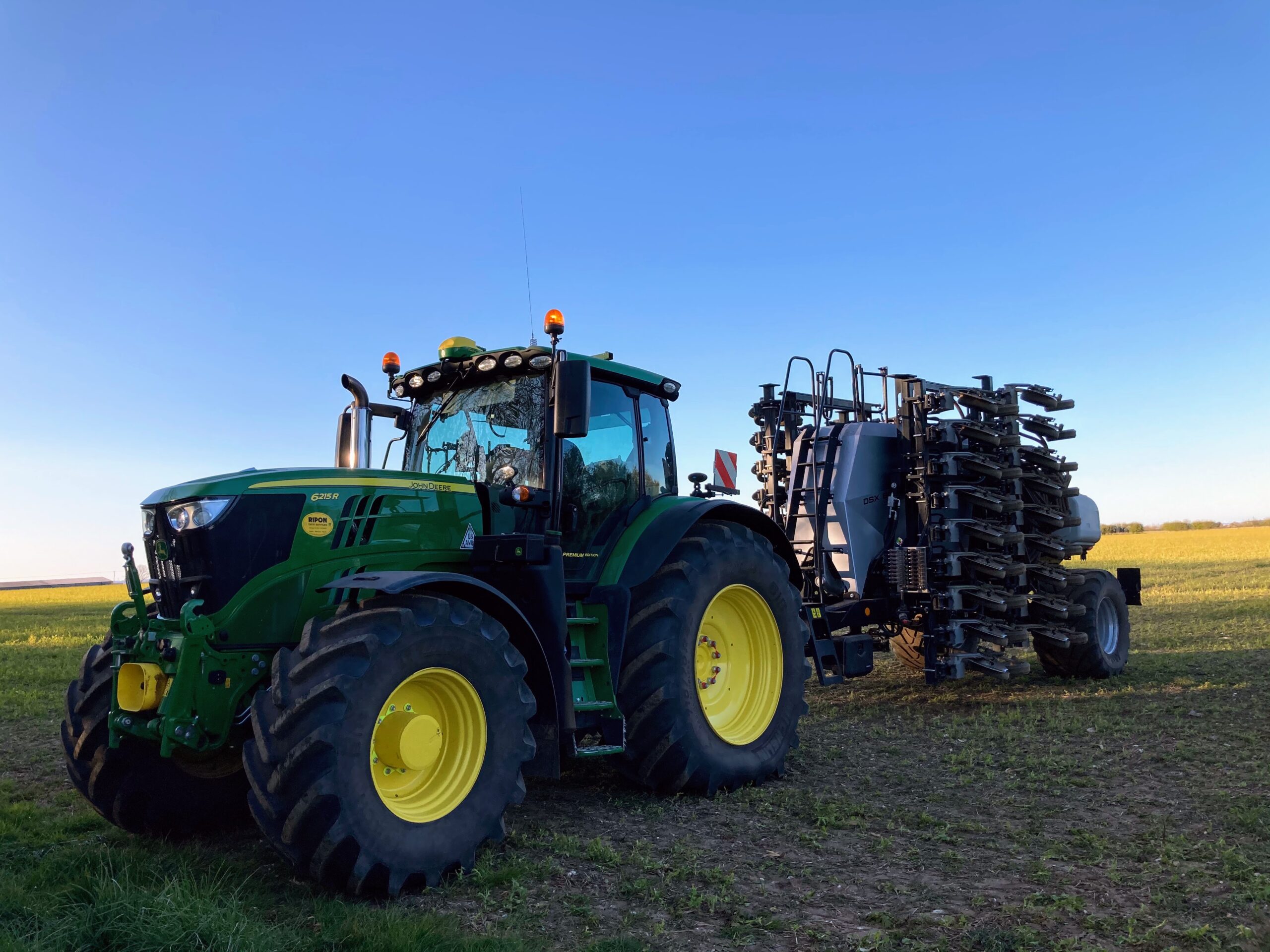
Farmer Focus – Andrew Jackson
September 2024
Another year has passed and although I am without doubt a bit older, hopefully I am a little wiser from all the errors that I have made. We have tried to devise a rotation based around predominantly first wheats, interrupted with break crops of grass seed (down for two and a half years and grazed in the winter periods), OSR and this year for the first time, spring beans and BOATS (spring oats sown alongside spring beans). Although we were confronted with a wet autumn, we have a low grass weed burden which enabled us to press on with the autumn drilling, we used our own seed, a ten-way soft wheat blend and took it straight out of the shed (rightly or wrongly). Our six metre Horizon drill, operated by my daughter Anna went well and although I would have liked to have tried to place some liquid biologicals alongside the seed, last autumn did not allow the time to be trialling.
We successfully sowed all our seed before the heavens really opened. Throughout the wet winter period, I was asked whether, because we had direct drilled and not cultivated to take out any compaction, then surely our fields must be full of puddles, the answer was ,there were no puddles apart from one or two parts of historically compacted tramlines on better bodied soils. This free draining soil, represented the results of four years drilling and levelling the fields with a Sumo DTS, followed by four years using a direct drill, no cultivations, just putting faith in the system.
Anna and to a lesser extent myself, appear in the film Six Inches of Soil. This had been three years in the making and we attended the first viewing in December in Cambridge.
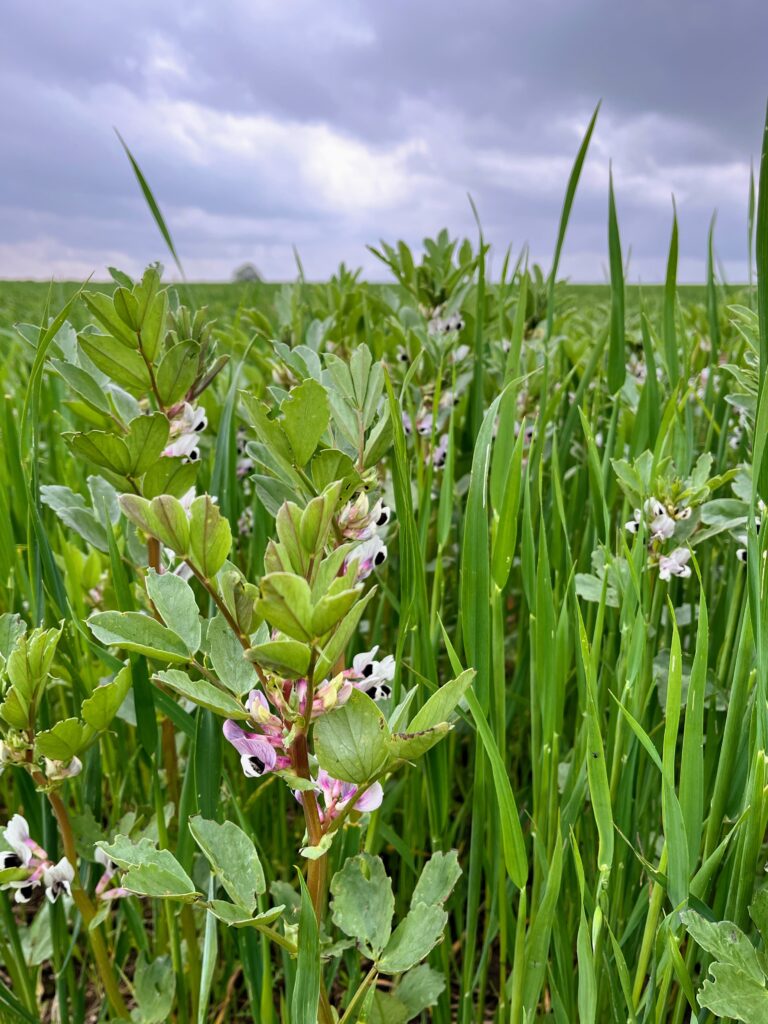
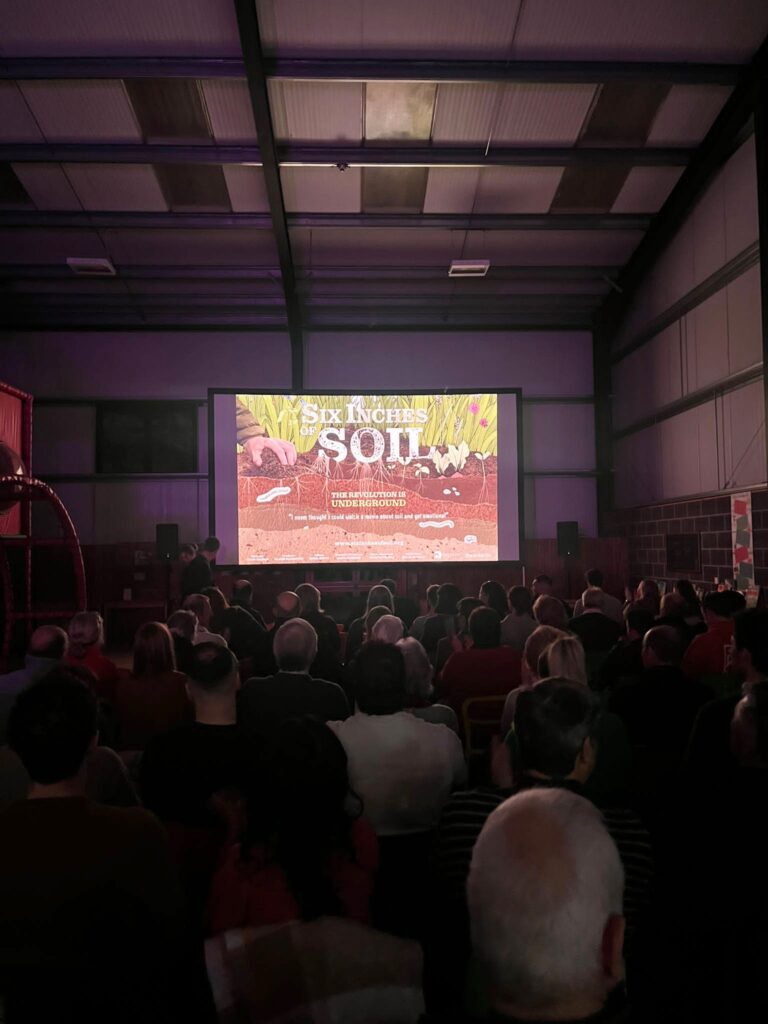
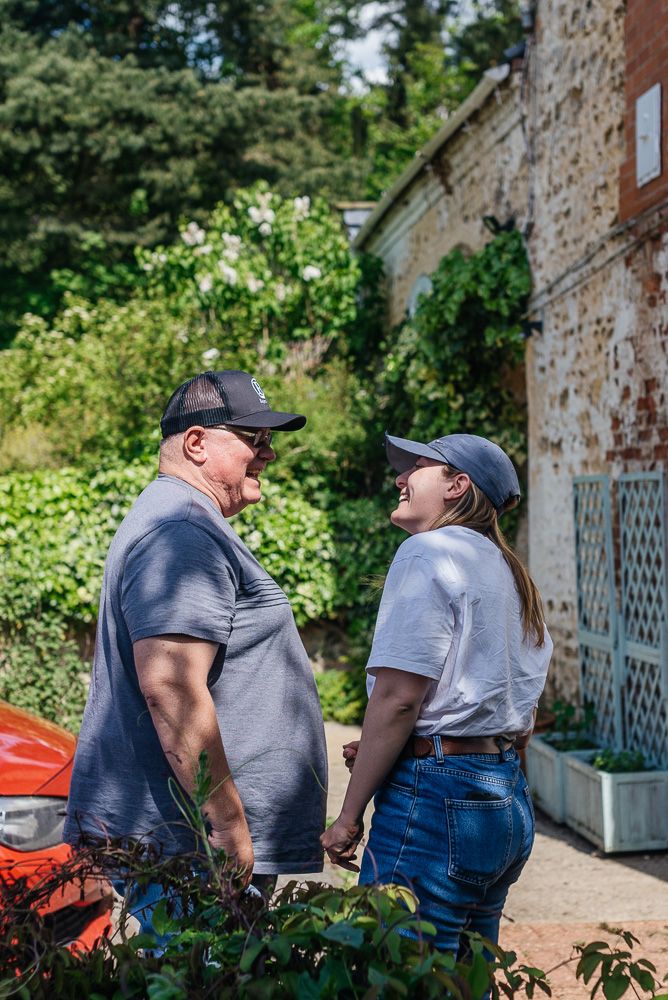
We attended the first public viewing at the Oxford Real Farming Conference. Prior to the viewing we enjoyed a beer with Tim Parton, this was shortly before his horrific accident. I am sure that you will all join me in wishing Tim a speedy recovery in his adjustment back to his farming life.
We also had a film viewing in our play barn at the Pink Pig Farm. This was for me particularly nerve racking because my farm and its system was being judged by many of my farming friends on the big screen. I sat at the back and knowing that I would be answering questions on a panel after the film, I filled myself with Dutch courage maybe excessively! Needless to say, I have not been asked to sit on a post film panel since. Anna and I have attended other viewings at York and John Pawsey’s farm in Suffolk, all the viewings were well received and followed up by a plethora of questions for the panel.
We finally completed the foliar nitrogen plant. Within the plant we have a twenty-five thousand litre tank which can be filled with rainwater to the required level and then urea and sulphur are added to a specified recipe, the contents of the tank are agitated for twelve to twenty-four hours, depending on the ambient temperature, then the finished product can be pumped into one of three twenty thousand litre storage tanks.
I have an eighty thousand litre rainwater tank sited outside the building to capture rainwater and since the recipe specifies soft water, I was particularly concerned that the collection from the gutters would not supply enough. I need not have worried, after that wet winter, I have even had to fill one of my fertiliser storage tanks with the precious, soft rainwater. I should add that we had to bund the whole building and simultaneously we relocated our chemical store to enable the whole mixing and storage operation to take place under cover. We would like to thank Anglian Water for a grant which contributed to the cost.
On the day of foliar fertiliser application, we then add in biologicals such as Fish hydrolysate, molasses and Hutchinson’s Humagro, all is applied at one hundred litres per hectare which means that we can cover some ground quickly. No scorch was apparent; however, we did endeavour to apply early in the mornings. The theory of applying foliar nitrogen as opposed to soil applied nitrogen is that it is up to four times more efficient, therefore allowing for a reduction in application rates accompanied by financial savings of home mixing and using less product. Amendments, such as magnesium and manganese can be added when sap tests dictate. The wheats crops were also treated with Sycon as a fungicide replacement, eventually the disease pressure was so high that we had to apply a normal fungicide in the latter growth stages.
The spring beans had always been planned and were grown on contract for seed for Limagrain, for many farmers spring beans were sown because of the wet autumn and winter. We also tried BOATS, apart from one trace element application, they received no fertiliser, herbicide, or fungicide products and may be suitable for a premium market outlet. Following a three-year break of two years of grass and one year of OSR or Beans, we were able to grow a crop of Basic Typhoon seed for Limagrain, but we requested no seed dressing, this action also allowed us to spread our risk of growing 100% home saved seed.

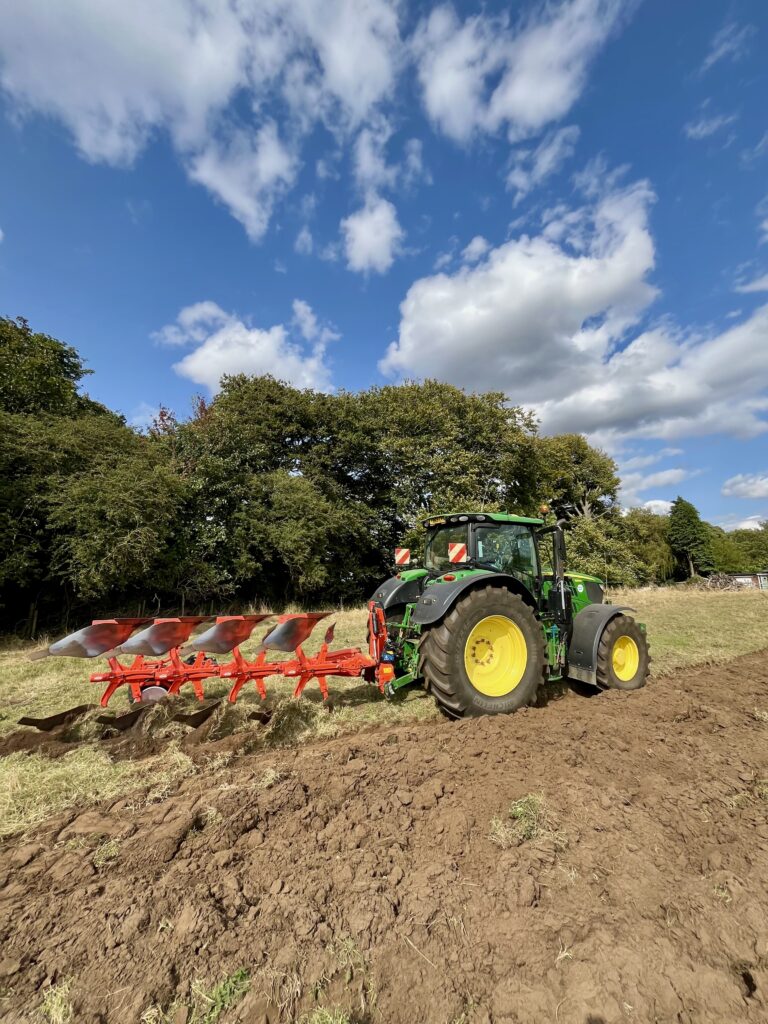
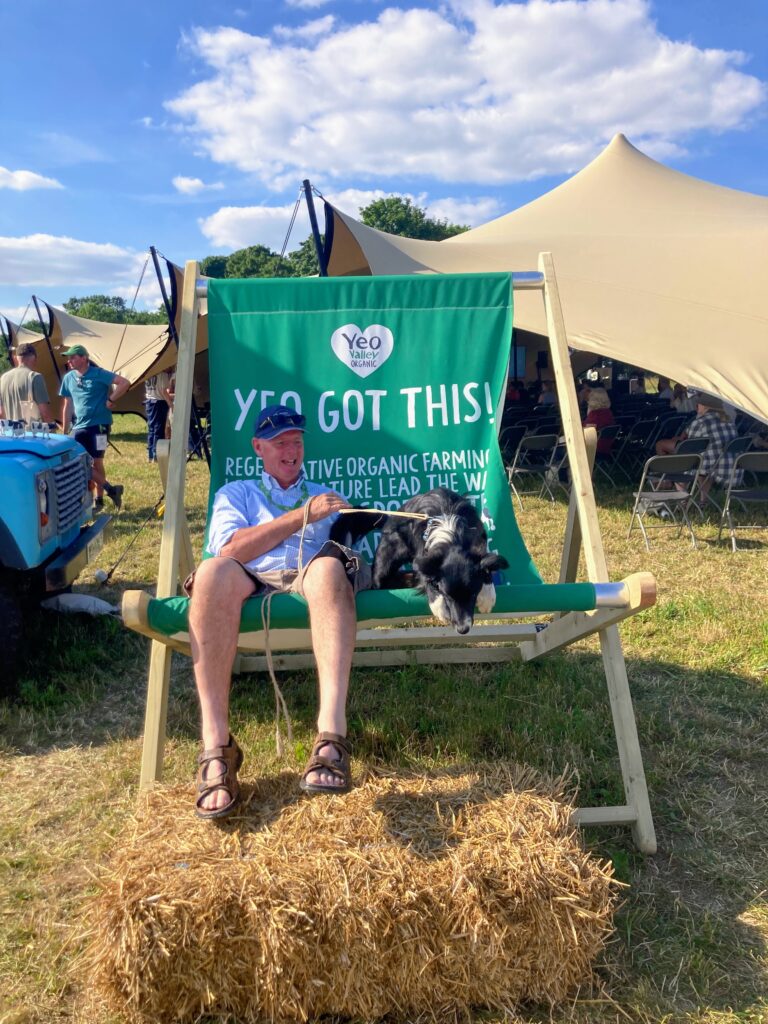
I attended Groundswell with the aim of investigating three topics: adding value to my grain, robotic camera guided hoes and Exlana sheep. I came away having decided that I would try Wildfarmed wheat, if its happening on Clarkson’s farm ,then it probably should happen on mine. Although the SFI pay reasonable rewards for interrow hoeing and there are grants to buy the hoe, two things are holding me back, firstly if I could achieve an understory of clover or indeed lucerne, then it may not be easy or desirable to inter row hoe and secondly, I cannot believe the price of the hoes. Have they pumped up the price on the back of the government incentives? Every year our sheep enterprise is confronted with fly strike, shearing costs and bags of wool with very low value. At Groundswell I visited the Exlana stand and concluded that going forward we should run wool shedding sheep , such as Exlanas, I just must convince my daughter.
By completing two Carbon Calculators, I have come out just about carbon neutral and consequently I have been approached to become a Climate demonstration farm, I attended a webinar in relation to this which was presenting thoughts and theories from lecturers from a selection of European Universities. What they said could have been straight out of a presentation from thirty years ago. It’s so concerning that the educational institutions do not appear to have moved with the times.
More encouraging was an excellent conference at Downing College Cambridge, it was organised by a group of trusts, being predominantly driven by members of the Sainsbury family, who are themselves farming regeneratively. The conference had the aim of creating more collaboration between the scientists (educational institutes), the farmers and the city institutions who might fund research on our behalf. Once again, the scientific community only like to measure one or two variables in a single trial. I stood up and explained the multitude of changes which have taken place on my farm in a relatively short period of time, I fear that I am acting on hope and blind faith, using and adapting research from other countries around the world, in the absence of any meaningful research in the UK. One very positive presentation came from Ruth Wade who, in conjunction with a cluster of Yorkshire farmers is carrying out some more relative trials work at Leeds University, albeit she is about to run out of funding.
After years of growing Birds Eye peas in a six-year rotation, our farm has become pea sick with foot rot, regrettably the system was not as sustainable as we thought, or was it the decades of ploughing?. We now rent land for peas and this year, due to the weather conditions and the fact that I refused to plough, (instead I had Sumo trio ’ed the field, leaving some surface trash), I was asked to direct drill the peas, this went reasonably well considering that direct drills do not really like cultivated soils. However, my field was hit by every pigeon in the territory and given that margins are quite tight on rented land, after forty years of being a Birds Eye pea grower, I have given notice to quit growing peas. I also had poor OSR yields, part of this might have been seasonal, however I do believe that OSR is quite a weak rooter, and I have struggled to get outstanding OSR crops from direct drilling, so out of the window goes the OSR also.
For years I have operated Gatekeeper, and I guess that I have learnt to live with its clunkiness, Anna will not work with Gatekeeper, she said that it is back in the ark, so we are changing to the Hutchinson crop recording package Omnia, and she will be in the driving seat for that product.
We have tried various actions with our direct drilling to establish an herbal ley into existing grassland, all have failed, so this year we have had to hire/borrow a plough and two of my children were taught the acquired skill of how to plough. The herbal ley seed was then sown into the blacked over soil and we eagerly await emergence.
I have been in the SFI pilot which is coming to an end soon and so I have been reviewing the options of the 2024 SFI Scheme. It may come as no surprise that being a regenerative farmer, I will be able to tick so many more boxes than my conventional neighbours. It seems likely that the Wildfarmed area may be eligible for the low input cereal option, on those grounds BOATS could also qualify, therefore enabling BOATS to become a viable break crop, which may replace OSR in the rotation.
Our wedding barn diversification has gone well for two summer seasons, which is just as well because both of my daughters have announced their engagements this summer. Carl and Anna announced their engagement in May, on the weekend of the engagement, it had been suggested by Claire Mackenzie that Anna might want to go to London to promote the Six Inches of Soil book at a book signing. The event would take place alongside Gabe Brown, who would be in the UK, not only to promote his book, but on other business. I explained to Claire that I had prior knowledge of Anna’s forthcoming engagement, and that Anna would not be available to go to London. A plan was then hatched (not by me), to drive Gabe straight from Heathrow to Scunthorpe, with the intention of giving Anna a second surprise for that weekend. This cunning plan was implemented and we hosted Gabe and his colleagues to a brief farm walk and a Barbeque, on which turned out to be, one of the most idyllic of May days that you could possibly imagine, Gabe might have been a bit jet lagged, but wow, who would have told me back in 2016, when I read Dirt to Soil, that I would be entertaining its author in my garden, eight years later?


-
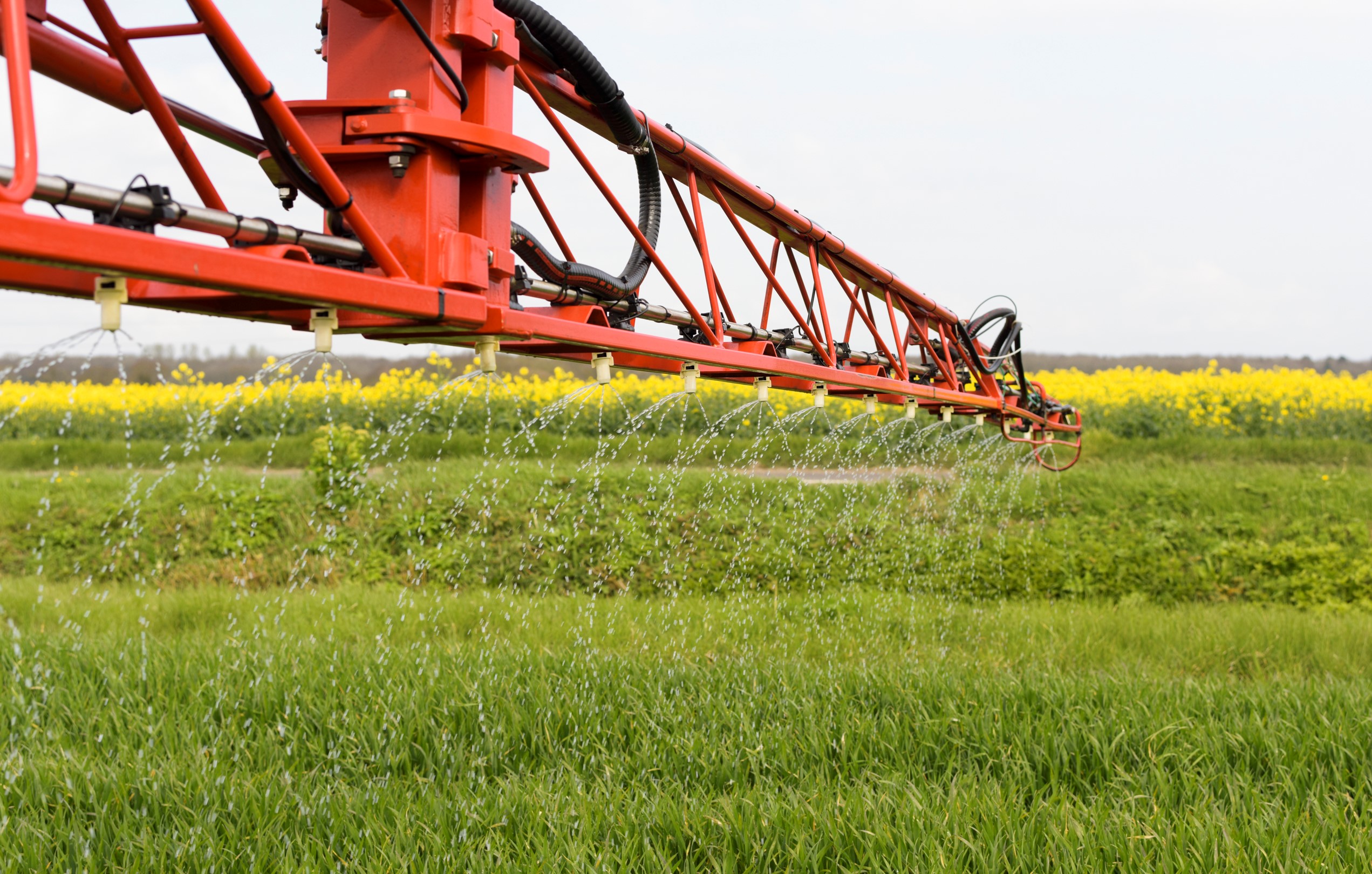
Getting emissions down in a measured way
Written by Rob Nightingale from Frontier
“Yield is king!” This was a tag line in farming throughout my career as a farm manager and agronomist. Interestingly, now as a technical sustainability specialist, it’s a phrase finding resurgence again.
At times in our history it has probably been more pertinent than others, for example during the second World War when the UK was cut off from imports and the onus on domestic production and supply was significant. Since then, however, conversations about yield have typically centred around profitability.
Being profitable has often meant producing as much yield as possible from a piece of land, ideally with minimal investment to ensure the best returns. However, in the last 30 years, UK wheat yields have plateaued and rather than reaching for the highest, the focus shifted to aiming for the optimum.
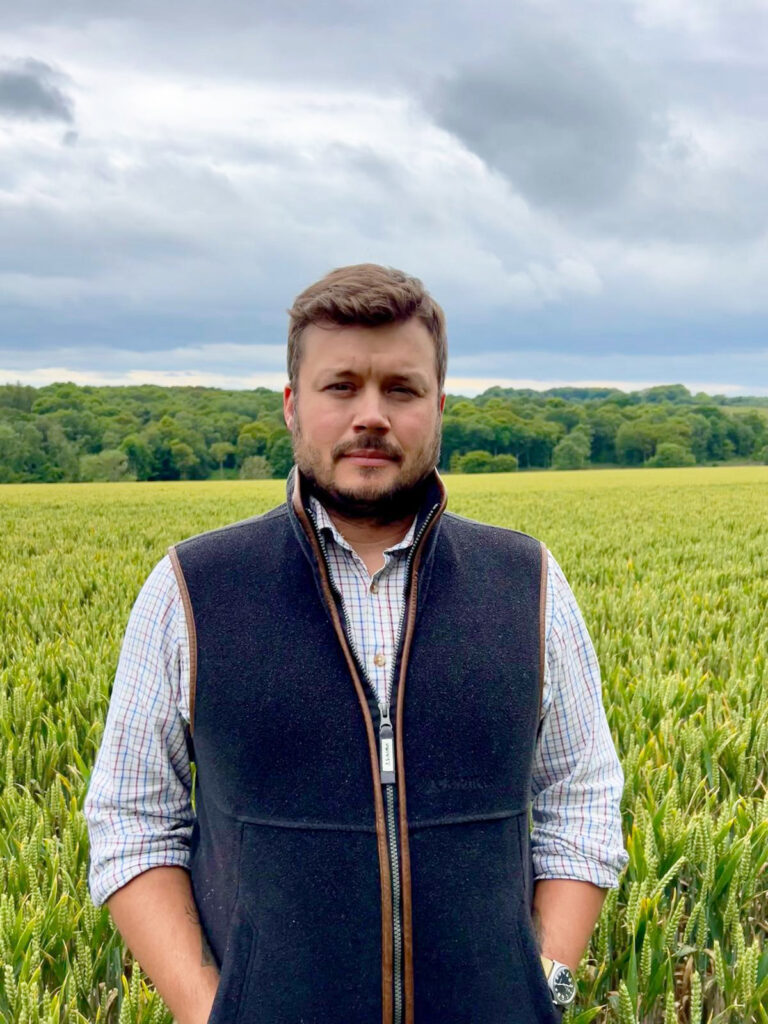
Rob Nightingale This was the case when I started as a farm manager and continued as an agronomist – matching inputs to outputs and keeping the cost of production per tonne in mind. Since moving to my technical sustainability role, yield is indeed still king, but the narrative around what that looks like in today’s agricultural landscape has shifted again.
But, why? To put it simply, in the UK we have some of the best yielding land in the world. The global winter wheat average for the last five years was 3.53t/ha, whereas the UK average for the same period was 8.05t/ha. If we consider that comparatively, you could say that every hectare in the UK yields 2.2 times more than the global standard.
Of course, this doesn’t mean we should farm the entirety of the UK. We have incredible flora and fauna here and, importantly, we rely on that biodiversity to sustain and enhance the farmed environment we depend on. Instead, where crops are being grown, the priority now is to optimise those areas to deliver the highest yield with the lowest environmental impact, ensuring sustainable, resilient farming systems that delivers for the long term.
With the benefit of hindsight (it is 20:20 after all), the ‘optimum yield’ can seem clear, but basing the experience of one season on the next is never a guarantee. Instead, it’s about ongoing monitoring to understand what the yield potential truly is, using those insights to better understand what the picture could look like next time.
Reviewing crop input strategies is an important part of this and we’re continually investigating solutions that support growers to adopt approaches based on applying the right amount in the right place; matching crop need.
If we look at nitrogen requirements in wheat for example, calculating optimum applications might seem a relatively straightforward exercise on paper. A crop of wheat’s offtake is the amount of nitrogen removed from the field, otherwise expressed as yield (dry matter) x grain nitrogen (%). For example:
8t/ha yield x 11% grain protein = 6800kg/ha x 1.93% nitrogen = 131kg grain nitrogen offtake.
Once we have this figure we then need to account for the nitrogen taken up by the crop to produce roots, stems and leaves that doesn’t get transferred into the grain by harvest.
The proportion of nitrogen in grain is typically around 68%, so we divide the grain nitrogen offtake by 68% to get the total nitrogen uptake. For example:
131kg grain nitrogen offtake ÷ 68% = 193kg/ha total nitrogen uptake.
If we think back to the five-year UK average of just over 8t/ha at 11% protein, based on the above calculations we therefore need the crop to take up 193kgN/ha from all sources. Simple, right? Not quite. How we get enough nitrogen there in the first place is key.
To maintain or even improve the yields we see in the UK, it’s important to create conditions where adequate nitrogen can be taken up by the plant to support grain production. The challenge our industry has is how to achieve these optimum levels.

Today, agriculture relies on mineral fertilisers as its predominant nitrogen source; with nitrogen produced by the Haber-Bosch process estimated to support food production for nearly half the world’s population.
However, with a growing focus on the sustainability credentials and carbon footprint of food production, exploration into ‘greener’ fertilisers is growing. Of course, moving away from the ‘norm’ isn’t a process that can happen overnight without there being wider impacts on crop production.
It’s therefore important to look at how to make the most of current practices too. For example, setting rotations up to get the maximum from soil nitrogen supply for those crops with a higher nitrogen demand. This could be along the lines of using grain legumes i.e. incorporating peas and beans, or even approaches such as undersowing with clover to help retain and increase nutrients for future crops.
Measuring the amount of available nitrogen in the soil provides a better understanding of how much additional nitrogen is needed to supply the crop too. Assessing biomass through precision services such as SOYL provides insight into nutrient levels across the farm and individual fields, supporting more targeted, variable applications with nitrogen doses subsequently adjusted higher or lower to suit demand.
At the end of the season, the results from in-field grain analysis and harvest sampling provide the equivalent of a ‘report card’, detailing how well a crop’s needs were met and therefore what worked and what needs reviewing. This data combined with the amount of applied nitrogen can help calculate a nitrogen use efficiency (NUE) score – a great measure for understanding how and where inputs may need adapting.
This calculation can provide a lot of insight into where nitrogen has been used and the yield potential of a field. For example, feed wheat’s optimum yield is seen when grain protein is at 10.8% protein. Using that as a benchmark, it can help in identifying whether nitrogen has been over or under-applied, if there is an issue with crop uptake or if the yield is lower than the potential of the field in question. If we look again at the UK vs. global average, any ‘lost’ yield potential is therefore a waste.
In my current role looking at the sustainability of farming systems, I spend a lot of time discussing production data and how to interpret the insights gathered during the process of growing a crop. This includes fertiliser product use, tillage type and yield principally, but reporting can be broadened to encompass much more, such as grain quality for example.
By collating this information, powerful data sets can be constructed and the insights gathered can support all parties of a supply chain, from farmer to grain processer, to continually advance the future of food production and make the right moves towards a more sustainable future. I always stress too that it isn’t the data in and of itself that is ‘valuable’, it’s the story it tells, the understandings it can generate at scale and the time and effort taken to do that.
Truly, I believe that UK farming is some of the best in the world, and it is intrinsic to supporting future improvements to our environment. There are a lot of positives to share about our industry and the ever-evolving science, innovation and forward-thinking approaches so many adopt and explore. Recording more of this better equips us to share this work even more widely, including to those buying the products derived from this work.
Yield is king when we’re talking about sustainability. Getting more from less in the right ways drives all of us to be more efficient. This is not just a discussion around land sparing vs. land sharing, it’s about striking the right balance between food production and the environment, doing the right things in the right places and for the right reasons. The story of how and why we do it is one we can all help to capture – not only can we all learn from it, but we can share that knowledge (and pride) with so many others too.


-
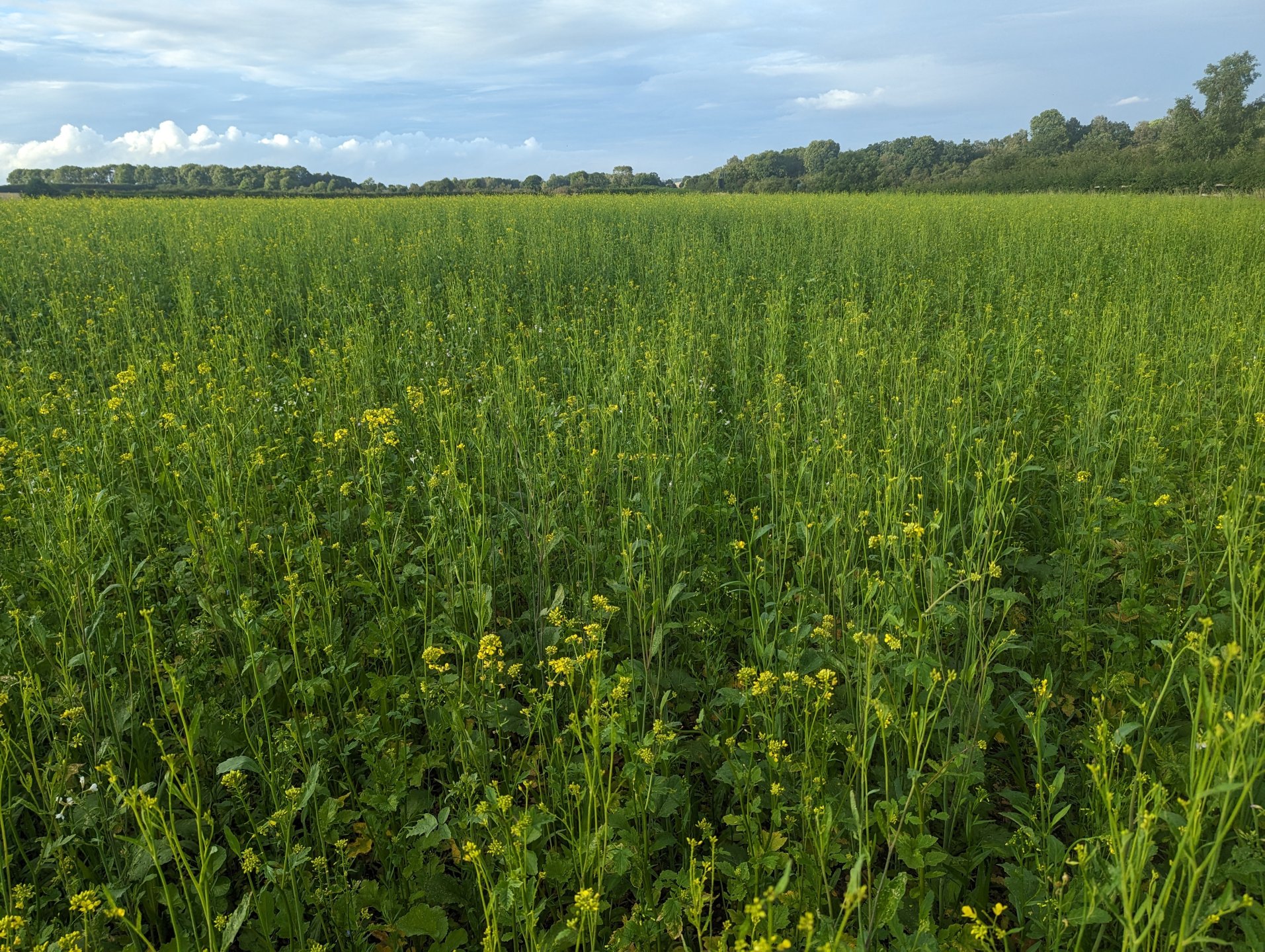
The Time is Now: Why It’s the Perfect Moment to Get Behind Regenerative Agriculture
Written by Angus Chalmers, Managing Director of RDP Comms
The World Economic Forum defines regenerative agriculture as ‘a way of farming that focuses on soil health.’ This is its key premise, using nature’s recipe, soil, to achieve productivity goals rather than relying on ever more complex manmade interventions. The last agricultural revolution was transformational for the wellbeing of the world’s population, but now we understand more about the impact of conventional farming, there is a growing realisation that we need to work more closely with mother nature’s natural processes.
Regenerative agriculture allows us to do this. As a more holistic approach to farming, it encompasses the whole eco system, enables us to work with and enhance what nature can deliver, and has the potential to provide a balanced and more efficient way of producing food. However, let us not forget that data, knowledge, and precision agriculture will be just as important in a regen world as it has always been. We will just be doing it as part of a more sustainable food system.
Industry events we have attended so far this year have demonstrated just how much momentum there is behind the regenerative movement. At Groundswell, Cereals, and a visit to an AHDB monitor farm, there has been a focus on different regenerative techniques and approaches. This illustrated just how broad a church regenerative agriculture is and therein lies its beauty. The reason it’s become such a strong movement is that it does not try to force farmers to follow a blueprint. It is inclusive, farmers can enter at multiple levels, starting simply by making a few minor changes or adopting wholescale system change. Ironically many farmers already practice some form of regenerative agriculture, but just do not recognise it as such.
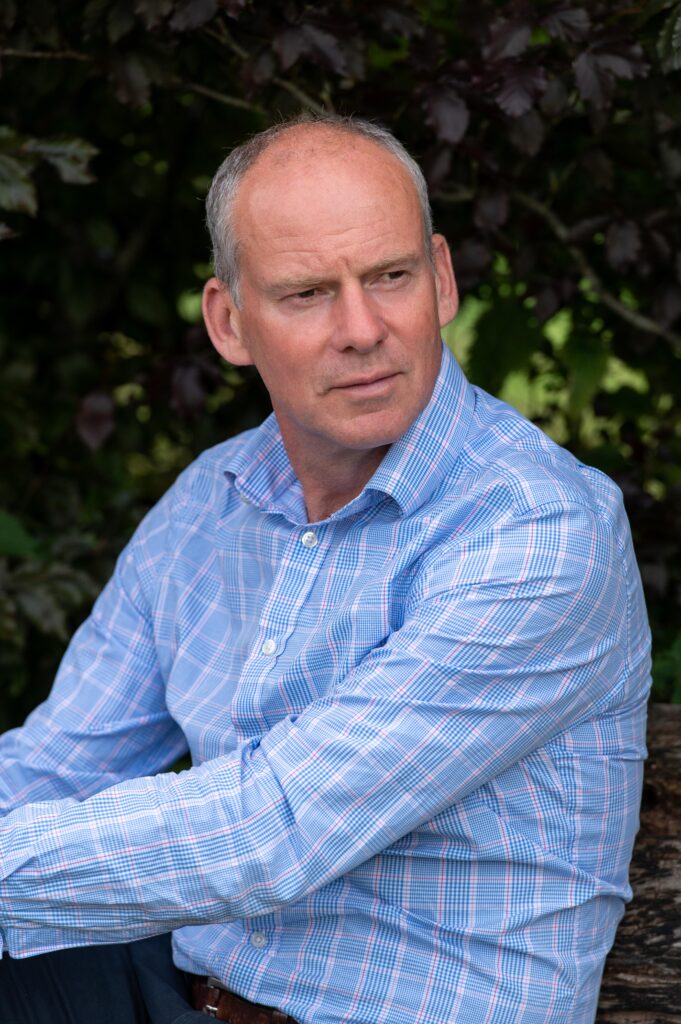
The strong message of the regenerative ‘brand’
If we consider the regenerative ‘brand’ as a representation of UK agriculture, we need to be careful about how it is developed. How can we nurture the brand to cut through misinformation, particularly given that it is not perfect science and consumer understanding is lacking?
Recent research from EIT Food (European Institute for Innovation and Technology) looked at consumer perceptions of regenerative agriculture. It found that consumers do not think much about the different agricultural methods used to produce their food, but they are concerned about chemical use and food quality. They also perceive that food grown in a regenerative system is healthier, nutritious, and tastes better mainly because fewer chemicals and pesticides are used in production. There is also a wider recognition that regenerative agriculture is aligned to a sustainable food future in a greater way than conventional farming.
For both consumers and farmers, the regenerative agriculture brand has a strong message. It delivers nutritious food, and whether tastier or not is subjective, but it enhances soil health. Ultimately this delivers healthier crops requiring less intervention to help them grow and ward off pests and disease as they are extracting much of what they need from the soil. Mother nature’s recipe, when healthy and in good heart is more effective and has the potential to deliver greater returns to farmers.
A wider opportunity for society
The time is right for us as agriculturalists to back the regenerative movement, but in my mind the far bigger prize is the opportunity this represents for UK agriculture to engage with the rest of society and rally behind a brand which is already seen as positive. Rather than occupying different camps, demonising conventional farming for being too industrial, or organic farming for being expensive and low output, we need to embrace the regenerative movement, in all its guises. Encourage its uptake and development and invest in its future.
We need to recognise that this brand has the opportunity to penetrate right through to the consumer. Let us ask ourselves the question; how do we grow this positive position? What we must not do is confuse and divide, ‘my regenerative method is better than yours.’ Our great industry tends to shoot itself in the foot when our eyes are too firmly faced inwards, let us look outwards at our industry’s reputation in the eyes of the end consumer, we have a remarkable story to tell. By all means, if a certain approach provides a unique selling point, then make the most of it, enhance your brand and marketing approach but let us not damage the industry’s wider reputation.
In this age of instant communication and social media, it does not take long to spread messaging that is wildly incorrect, and that people take as gospel. There is no right way to adopt regenerative agriculture, we still have so much to learn, so we must not be too possessive, but be embracing for the good of UK agriculture.
I am under no illusion, however that there is a challenge in developing the regenerative brand, as it currently possesses so many definitions. A tighter definition would reduce the chances of damaging misinterpretation and enable faster growth and wider acceptance. However, the existence of this wide definition is exactly the reason regenerative agriculture has demonstrated such dramatic momentum. Is there is a place for an umbrella brand that remains a broad church, with more nuanced and focussed approaches developing their unique positions in support of the wider movement?
The regenerative movement is gaining momentum, in all its many guises, and combined with innovative technology and precision agriculture will increase the chance we have of delivering the food we need whilst enhancing soil health, biodiversity and nature reconstruction. Regenerative agriculture might not be perfect, but it speaks to many of the challenges we are facing and above all provides cut through to our most important judge, the consumer, so let us build on this opportunity.


-

Beyond the barrel: the unique process behind the added fulvic acid in L-CBF BOOST
By David Maxwell, sales director, QLF Agronomy
The welcome addition of a family-owned distillery at the site where QLF Agronomy products are manufactured not only gave us a healthy supply of rum, but we have also been able to ‘boost’ our BOOST with added fulvic acid as a byproduct from the distilling process.
Distinct Distillers is co-located with the Landowner, Quality Liquid Feeds and QLF Agronomy manufacturing site. It currently produces several white and dark rums using the same raw material that goes into our QLF Agronomy products – molasses.
The fermentation of molasses creates a lot of nutrients alongside the alcohol, and the distillation kills off any live yeast. What’s left at the end of the process is a distillate that goes to the other side of our manufacturing site for us to utilise in our QLF Agronomy products. This distillate has a high concentration of fulvic acid, which is ideal for adding to our L-CBF BOOST, TL17, TL30 and Amino 15 products.
It’s a win-win. The distillery has a willing customer for what would otherwise be waste, and farmers using QLF Agronomy products benefit from additional fulvic acid for their crops. This is on top of the existing fulvic acid in our molasses-based fertilisers.
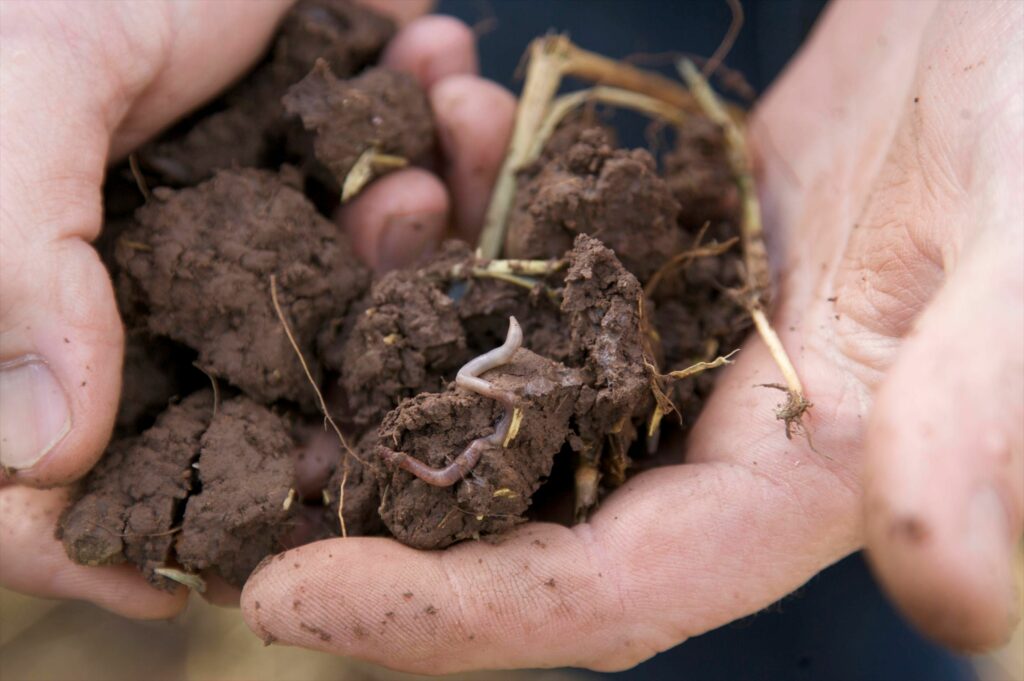
With a 1,000L IBC of straight fulvic acid costing around £3,000, what we include from the distillery byproduct adds considerable value to a farmer.
Fulvic acid is a natural organic substance that improves soil health in many ways. Its importance to plant health comes from its open carbon structure and low molecular weight. It is an excellent chelating agent, meaning it can bind to nutrients and make them more available to the plant.
Fulvic acid enhances nutrient uptake by increasing the permeability of plant cell membranes. This results in improved nutrient absorption and utilisation by plants.
Alongside nutrient uptake, the other benefit of including fulvic acid with nitrogen is how it aids the conversion of urea into amino acids by providing a carbon source.
If a farmer applies foliar urea, it will also help uptake into the plant by neutralising the charge on the leaf surface. This stops urea, a positively charged cation, from binding to the surface and not being absorbed.
The molasses that form the basis of our products has similar benefits to plant health, but fulvic acid works in a complementary way.
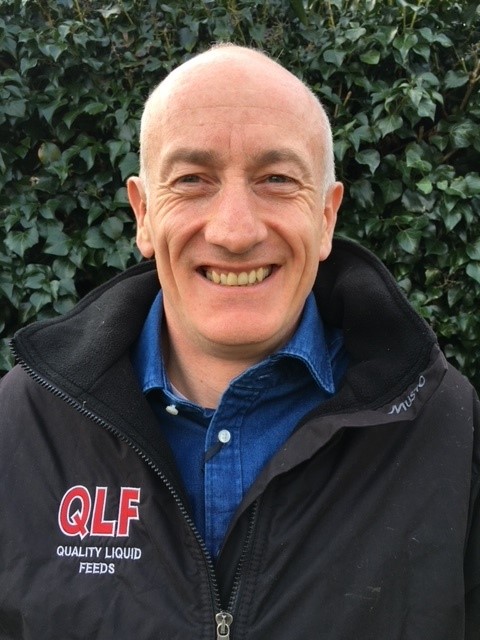
Fulvic acid’s sister compound is humic acid, which is also becoming an increasingly popular input. It tends to go on the soil rather than the leaf. However, there’s evidence on grassland that humic acid is a more effective foliar feed than fulvic acid.
We don’t get any humic acid from the distillate. L-CBF BOOST already contains humates, the solid form of humic acid. This makes it an exceptionally rounded foliar feed.
Distinct Distillers is about to increase production, giving us access to even more fulvic acid. We are considering if we can use this to introduce a range of specific foliar fertilisers with higher concentrations of fulvic acid. For the moment, farmers can benefit from the flexibility that a product like L-CBF BOOST gives them when they apply it to the soil or leaf.
QLF Agronomy issues a guide to carbon fertilisers
A new technical guide aimed at helping growers understand the benefits of incorporating carbon-based fertiliser in their nutrition programmes has been created by QLF agronomy.
With so much focus in the last 50 years on nitrogen and the nitrogen cycle, the importance of carbon and the carbon cycle has been neglected. The guide explains how maintaining a healthy carbon-to-nitrogen balance helps soil microbes thrive, improves nutrient use efficiency and increases yields.
Contained within is trial data, recommendations for L-CBF BOOST, grower case studies and frequently asked questions. Farmers and advisors who download and read it are entitled to 2 BASIS and 2 NRoSO points.
Distinct Distillers: the drinks company improving soil health
Following a successful career in the drinks industry, Distinct Distillers founder Hannah Boon decided to set out on her own. She set up Distinct Distillers as a separate business from her family’s Landowner Group but linked through the same infrastructure.
They produce dark and light rums and plan to begin producing whiskey soon. The spirits are cask-conditioned underground using an old World War Two aviation fuel bunker. This provides a consistent temperature and humidity, which are ideal conditions for conditioning spirits.
The firm also has a licence to sell its excess ethanol for industrial purposes. They have another on-site customer with the Landowner business, which can use it for its screenwash.
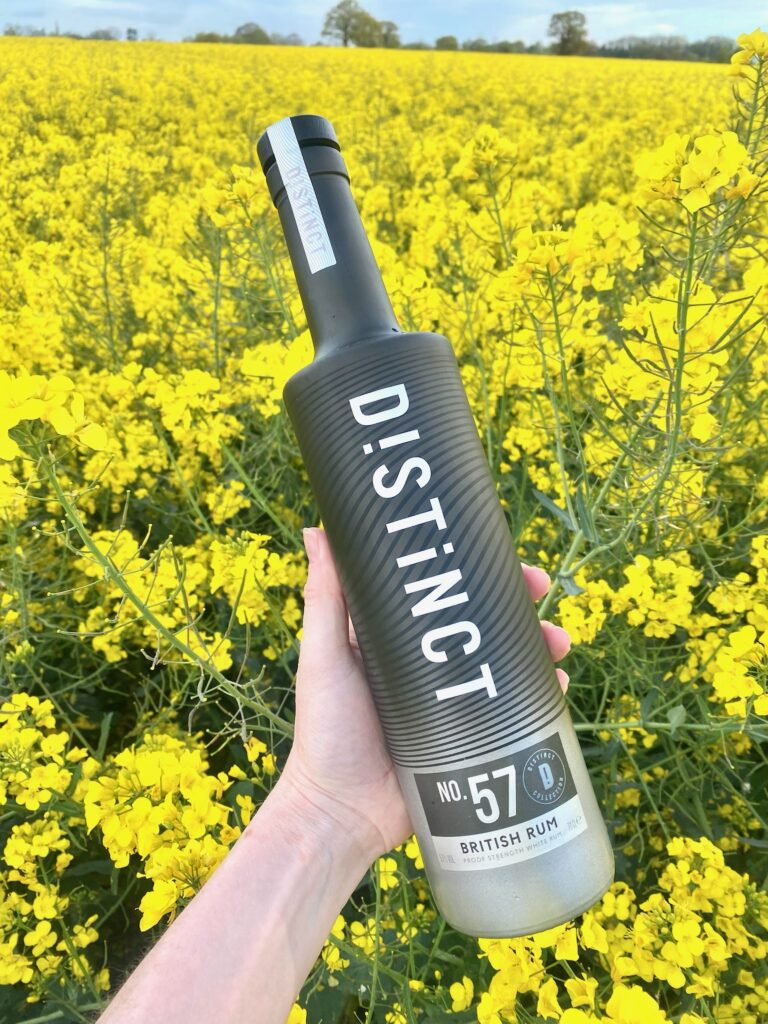
10% off the Distinct Distiller online shop
Direct Driller readers can get a 10% discount on a bottle of Distinct Distiller rum by using the code DIRECTDRILLER10 at the checkout on the Distinct Distiller website.
https://www.distinctdistillers.co.uk/collections


-
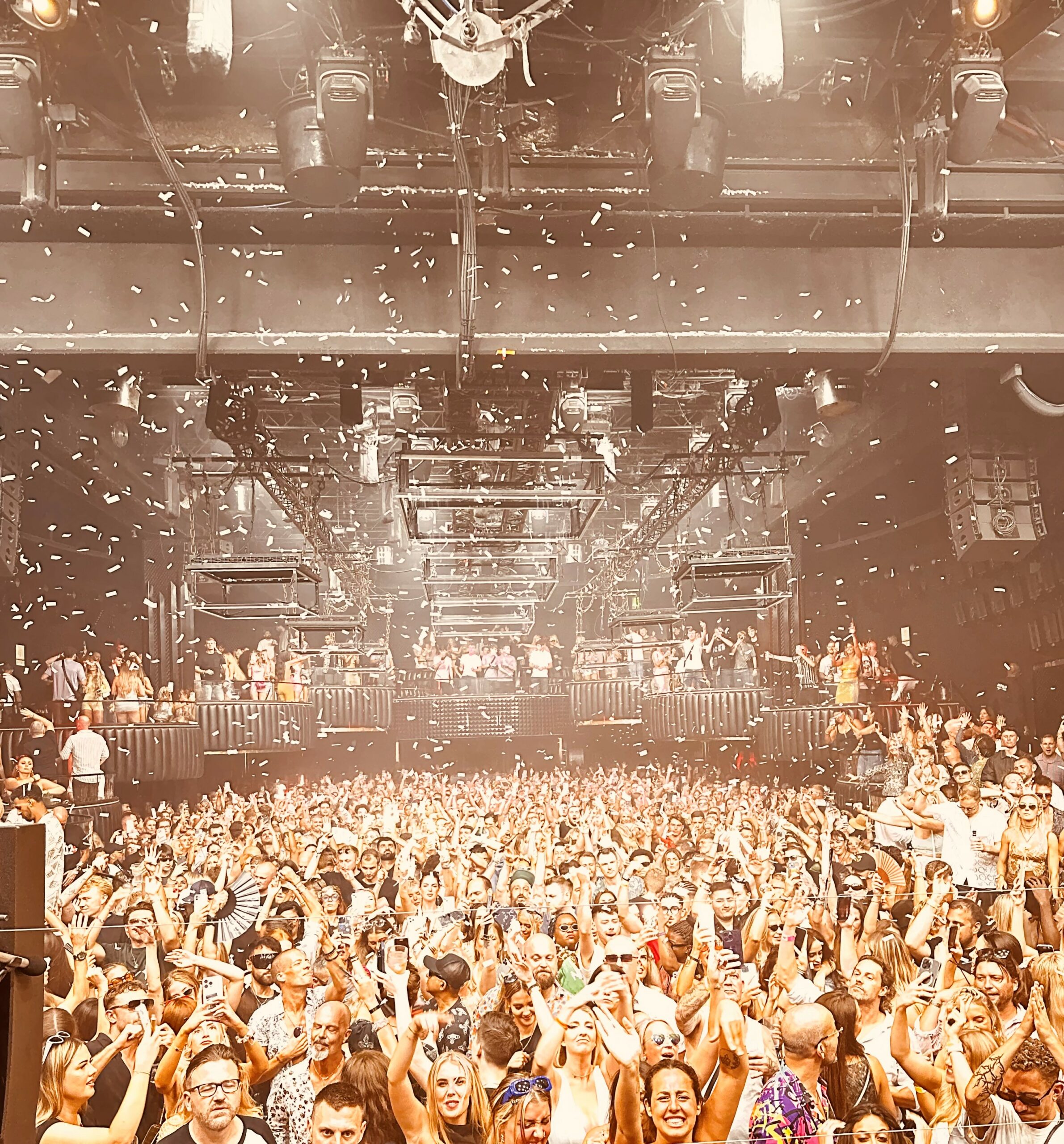
Farmer Focus – Andy Cato
September 2024
The deluge of the last few days, following the wettest winter since 1836 and the drought of the previous year, make it abundantly clear that we’re now farming in a fundamentally different water cycle. Improving the capacity of our soils to infiltrate and percolate heavy rainfall is going to be critical for a resilient food supply. In his book, The Last Drop, Tim Smedley describes how the Tribunal de de la Vega de Valencia has met every week in the same spot for the past 1,100 years and is recognized as the oldest court on earth. The irrigation system it oversees is one of the many remarkable stories he tells of water optimisation. Iran’s ancient underground ‘qanat’ water network, for example, would stretch 9x around the equator. He describes how in recent decades these localised systems have been replaced by centralised mega projects: vast concrete dams and canals. These slowly emptying water-infrastructure dinosaurs come with some staggering statistics. Lake Mead, the reservoir formed by the Hoover Dam, loses more water through evaporation every year than the total water usage of Las Vegas.
As with water, so in agriculture, when local and nuanced gave way to centralised inputs, varieties and techniques, the initial miracle came with long term consequences that today are urgent and inescapable. One of the challenges we face at Wildfarmed is that the construction of the Hoover Dam or a huge food processing plant, fits much more easily into today’s investment criteria than introducing permeable urban surfaces to help with aquifer recharge or building infrastructure for local food networks. At the heart of this are the “externalities” that aren’t on the spreadsheet; the massive waste of the Hoover Dam whilst the Colorado river no longer reaches the sea, or the myriad statistics describing nature, water and soil decline, with which we’re all too familiar.
In such a world, where a dead tree is worth more than a living tree, a huge amount of Wildfarmed work goes into trying to create a world where farmers are paid not just for the weight of produce, but for its quality and the quality of the ecosystems in which it was grown. It’s a tribute to the tenacity of the team here that from data capture to financial support, we’re making tangible progress; finalising water company payments for our growers, for example, or Trinity Ag Tech analysis that found biodiversity in WF fields to be 100% higher than adjacent conventional production. Last week, hundreds of test tubes of insects went to Bristol University to be analysed for their quantity and diversity of life, data which is all part of building a picture that can bring value onto farmer’s spreadsheets that goes beyond tonnage of grain.
German government money kick-started a process that reduced the price of solar energy 90% in 10 years. Similarly, we need public money to open markets which reward farming that simultaneously delivers on nature and food security. I’ll leave it to those properly qualified to debate where farmed land should give way to rewilding on the one hand, or the pros and cons of “sustainable intensification” on the other. Between these two ends of the spectrum, there are huge tracts of UK farmland where farming that is properly rewarded to combine both food production and nature recovery, is the only way I can see to achieve 2030 legally binding species recovery targets* without either compromising food security or relying on food produced to catastrophic environmental standards from elsewhere around the world. But doing so depends on fair farmer outcomes, and that depends on value being attributed not just to how much food was produced, but how it was produced.
An invitation to speak at an FFCC gathering at the Labour Conference on Monday came long after a DJ set in Ibiza had been agreed for the night before. It made for a surreal 24 hours. The scenes at 5am and 5pm were quite different.

But there was a link. A sign held up in the front row of the Ibizan crowd said “Clarksons! Nature farming ❤️”. Another simply said “Wildfarmed”. A landmark of the last few months has been surpassing 100k Wildfarmed Social Media followers, engaging with the stories of our farmers, bakers, chefs and retailers. In the conference room at the Leonardo Hotel, alongside James Rebanks and Sophie Gregory, I had ten minutes to make my case. The nub of it was that there are lots of good things in today’s SFI, and DEFRA are certainly listening; the changes to AB14 about which I’d been nagging anyone who’d listen for several year did eventually come through, allowing cereal blends, companions and drilling after rape and beans (this is option is now known as AHW10).
But since 1987, when the UK pioneered one of the world’s first Agri-environment schemes, we have sought to increase biodiversity by taking farmland out of production. This shadow of nature and food being a mutually exclusive choice hangs over the SFI, and AHW10 was always an imperfect and temporary solution. A transformational SFI option would be one that gives proper value to nature rich food production, recognising its potential to match or exceed the biodiversity present in today’s well paid, non-productive environmental options. Some of the insect samples sent off to Bristol for analysis showed greater insect abundance in food producing Wildfarmed fields than in £763/Ha beetle banks. Equally transformational would be making certified nature-rich arable a BNG eligible landscape. Food, Nature and Biodiversity Net Gain (FNBNG) would be a global first, bringing BNG outcomes into food-producing landscapes and unlocking private money for farmers who are delivering on both nature recovery and food security in the same place at the same time.
Key to both is measuring outcomes. When the Wildfarmed Standards were drawn up, only 3 years ago, the world of outcomes monitoring was a very different, sparsely populated place. Since then, progress has been rapid and points to a near future where we might replace defining farming practices and define required outcomes instead. An example are polyphenols (anti-oxidants) as indicators of nutritional integrity and therefore functioning soil biology. Back in 1948 William Albrecht correlated the health of US sailors to the health of the soils in their native regions. 80 years later, talk of nutrient density is increasingly common. But a perfectly grown carrot in fully functional soil will have different nutrient levels depending on the geological history of the area. Antioxidants might therefore be a useful indicator of nutritional quality whatever the soil type. We’ve been measuring batches of WF grain for polyphenols over the past few years and found increases of 40% to 100% relative to nearby conventional fields. It will be interesting to see how this data builds up and it’s a shame that such important work is so expensive. Given the epidemic of diet related disease bringing the NHS to its knees, some public money here would be well spent.
From Acoustic measurements of soils as an indicator of overall system health to satellite analysis of Nitrogen leaching, so many partnerships with Wildfarmed growers are underway to push outcome measuring forward. This includes a pilot with Regenified to gather data across 10 of our farms. On one of them, the Leckford Estate, the Waitrose & Partners HQ with a long history of pioneering farming, I waded into a field of towering wheat and beans to watch Doug Peterson, technical head of the Regenified program, deploy an infiltration measuring machine that costs the same as a family car. This is in stark contrast to the 6” pipe, hammer and ½ litre bottle of water which are my usual tools of the trade.
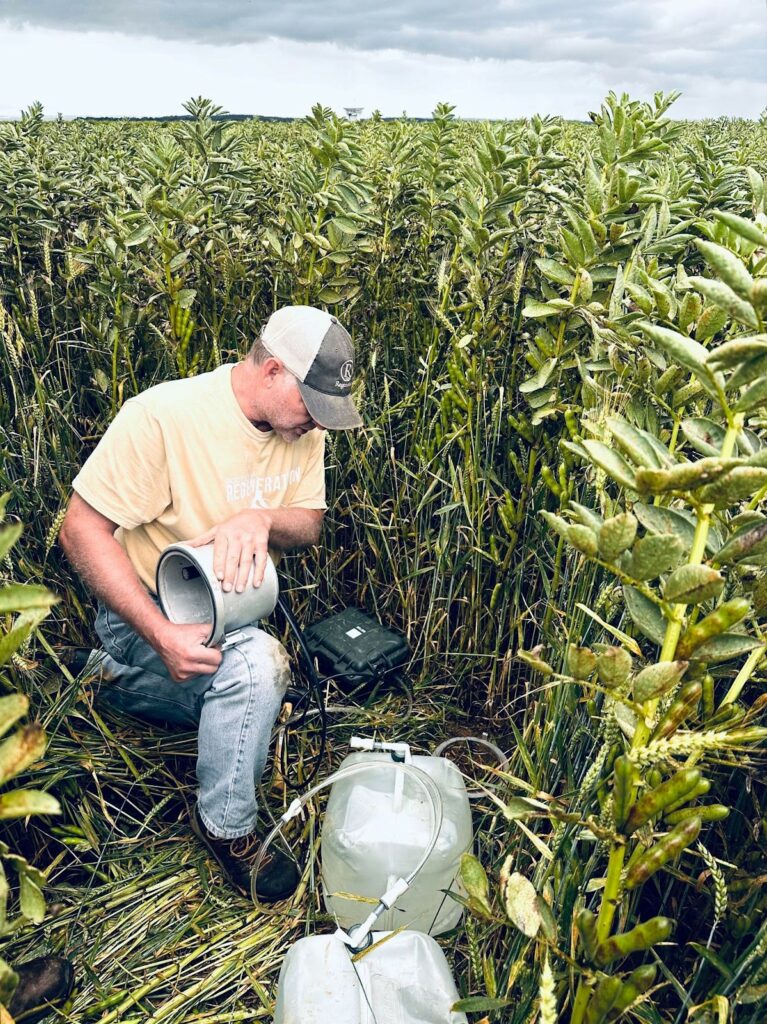
Infiltration is not only a critical measure of farm resilience in a time of downpours followed by drought but is also itself emerging as a powerful overall indicator of soil health. In a recent highly recommended John Kempf episode with Keith Berns from Green Cover seeds, they discuss the increases in infiltration rates that flow from diverse cover crops, and the increases in water use efficiency of diverse plant communities. Infiltration means porosity, and porosity means carbon and life. In our work with Andy Neal at Rothamsted, porosity, measured using topographical profiling of the soil, is his favoured measure of health.
But amidst all this innovative technology, let’s not forget the creature that is to the soil what the Harpy Eagle is to the forest – the worm. This summer, Jeremy Clarkson put his Wildfarmed fields into a summer long cover crop. Kaleb’s tine drill put the mix in a bit deep, and he’s since fixed himself up with a broadcaster over the drill tines so that next time he can create some tilth whilst tickling the seed into the surface. But despite losing some of the smaller seeded species to these depth issues, the worm count a month ago was amazing. The two samples below show a shovel of soil from the field over the hedge where peas had been harvested, and a shovel from the cover crop field a week after it had been flailed. (Worms under and in the soil samples were put on top to be counted). The next challenge will be getting these fields back into Oats and Beans. There are many areas where the soil goes from Cotswold brash to Cotswold crazy paving.
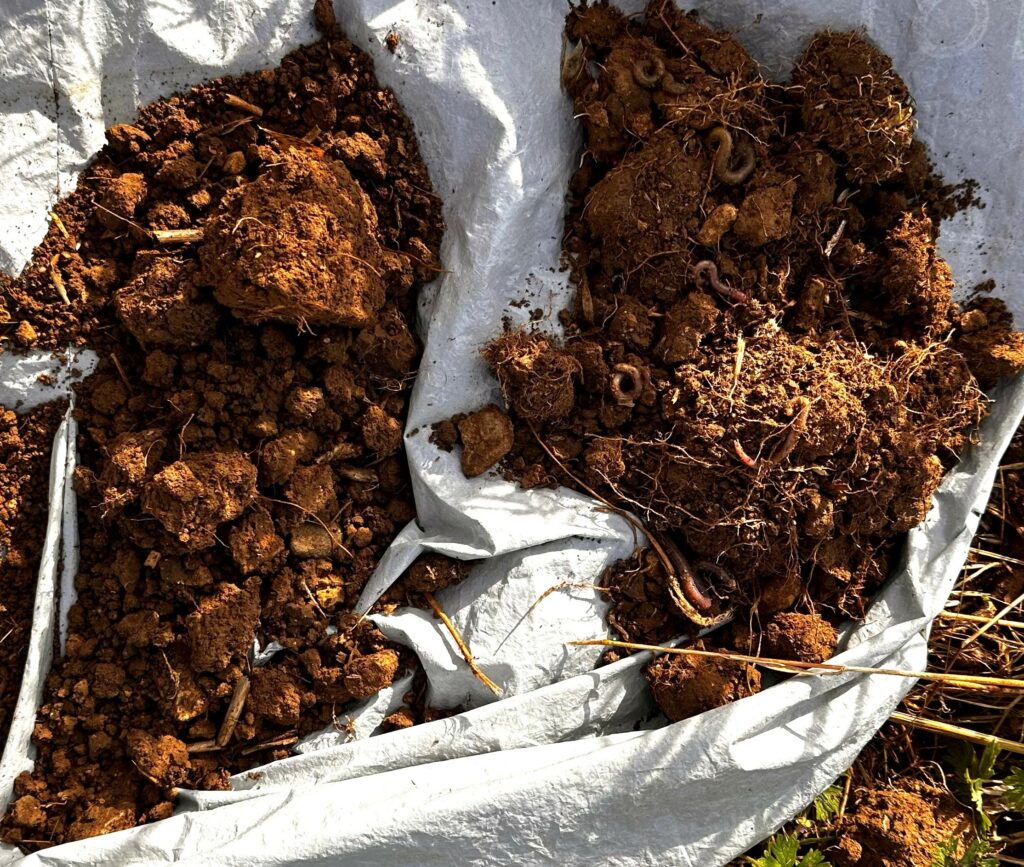
The big event at the battle of Shrewsbury, as the story unfolded on a recent Rest Is History podcast, was the future Henry V getting an arrow in the eye. The big event for me was hearing how his army advanced through a fields of peas that were full of snakes. I was left wondering where all the snakes have gone and reevaluating the widespread introduction of legumes into English farming which I’d always thought came in the 18th century with Townshend’s Four Course Rotation: Wheat-Turnips-Barley-Clover. I hadn’t realised that legumes had been so widely grown since the Middle Ages, and not just peas but beans and vetches too. It seems to have been the increased Nitrogen fixation of clovers together with replacing fallowing for weed control with hoe-able turnips, that really changed Townshend’s levels of productivity.
But as farmers up and down the country discovered last winter, having soil available nitrogen at the beginning of a cropping cycle is one thing. It being used by the following crop is another and is not straightforward or linear even before we throw in record amounts of rain. It became clear this spring that the amounts of available Nitrogen predicted by soil tests were not becoming a reality, either because of over-winter leaching, or because months of waterlogged conditions meant that the required soil biology wasn’t there. As a result, protein levels were down across the board. For some Wildfarmed growers, already using split N doses and SAP to make a little Nitrogen go a long way, our nutrition-based-on-need approach came up short; the need couldn’t be met. This was one of the key takeaways from the annual process of gathering data and experiences of all our farmers. Combined with the latest learnings from partners such as AEA and Regenified, we’re constantly looking for the best way to facilitate a scalable transition towards farming that meets Wildfarmed customers guarantees: farmer community support, fair farmer outcomes, nature-rich fields, pesticide free grain, avoidance of water pollution, better carbon efficiency.
Avoiding attachment to long held ideas in the face of new evidence is far easier said than done. One of many examples was when, in grass-based Surrey pastures, my first attempt at inter-row-mower pasture cropped UK wheat went into reverse in the spring. Simultaneously I had come across the work of Dr Christine Jones and realised that pasture cropping successes in France hadn’t been because the inter-rows were perennial, but because they were forb based and diverse. Staring at the yellowing, non-symbiotic relationship between annual grasses – wheat – and perennial grasses in those Surrey fields was humbling given I’d thought about pretty much nothing else other than blade tip speed and the million other practical problems that had needed solving throughout the evolution of various mower prototypes over the preceding years. And yet based on the new information, given plant family diversity was the key, and that we were trying to make implementation as easy as possible, surely step one should be the use of poly or bi-crops and cover crops, all doable with existing equipment, rather than try and build a world’s worth of mowers?
Helpful in these moments is to be reminded of the dizzying speed of ecosystem change relative to the trees still alive today that were seedlings when Mammoths walked the earth. Last week, an article detailing further catastrophic butterfly decline and another citing increased pesticide residues in food, were both followed by 5 inches of rain in 24 hours. We’re assailed on all sides by evidence for the urgency of a transition. As such, evidence-based decisions, and avoiding dogma, are, I think, critical if we’re to build field to plate collaborations at the size and scale required to turn things around.
For this year’s annual review around nitrogen, the course correction was more straightforward. The data showed that the amount of N expected from soils that didn’t materialise averaged 40kg. Simply hoping this doesn’t happen again is clearly not an option; without good farmer outcomes, there is nothing to talk about. Instead, we changed the soil-applied nitrogen allowance for our winter sown cereals, from 80kg to 120kg, delivered as always in the split doses of no more than 40kg that are crucial for water quality. Interestingly, studies in Agronomy , Field Crops Research r and Science Direct, all coalesced around 120kg in split doses as the sweet spot between N use efficiency and yield. Given Wildfarmed growers don’t have recourse to pesticides, caution around N use is inevitable given that excess is a sure-fire precursor to disease, or increased weed burdens.
Radical differences in rainfall from one season to the next also affect the management of companion crops; there appeared to be a correlation this year between wetter areas of fields and beans getting ahead of the wheat. It also, of course, has an impact on weeds. This year we’ll be running a series of trials to see how we can best manage both issues in the context of our customer guarantees. Inescapable in these low input systems are all the basics of good husbandry; a rotation that has setup the crop for success followed by good establishment at the higher end of recommended plant populations.
In his book La Vie, John Lewis-Stempel describes a year of small-scale agriculture in a village in the Charente. He measures the output of his vegetable garden and finds the calories produced per sq m to be three times higher than the large-scale farming he had practised in the UK. We encounter this question of scale all the time. On large arable holdings, having enough time to farm differently on a portion of that land can be challenging. And yet pinning a different future on land redistribution feels like rearranging titanic deck chairs. Meeting the world as it is means constantly trying to refine the management of nature rich arable so that there is enough time to focus on the most important thing of all. As Wildfarmed grower Duncan Fairburn put it last week “farming with your eyes”.
This summer saw the arrival of Wildfarmed loaves on the shelves of Waitrose. The first time I saw them in situ, I stood in silence for a while, marvelling at all that had happened to make those loaves become a reality. Building a farming community field by field, the research, agronomy and support team that surrounds that, paying farmers fairer prices whilst trying to remain affordable, bringing everyone across the supply chain together in fields across the country to explain what we’re doing and why, the post-harvest grain separation, storage solutions and milling partners that allow us to keep our grain segregated and traceable from field to plate, persuading plant bakeries operating on wafer thin margins to abandon the Chorleywood process, do an overnight fermentation, leave out the additives, or persuading packaging companies to accept what for them are totally inconsequential print runs. On and on it goes, and then to bring all this together and get a commitment from the different strata of the Waitrose supermarket team to make the first change on the bread isle for 125 years. It’s so incredibly complicated and I take my hat off to the Wildfarmed team for having pulled it off, despite doing so in a market that places no value, yet, on the wider societal benefits of any of this.
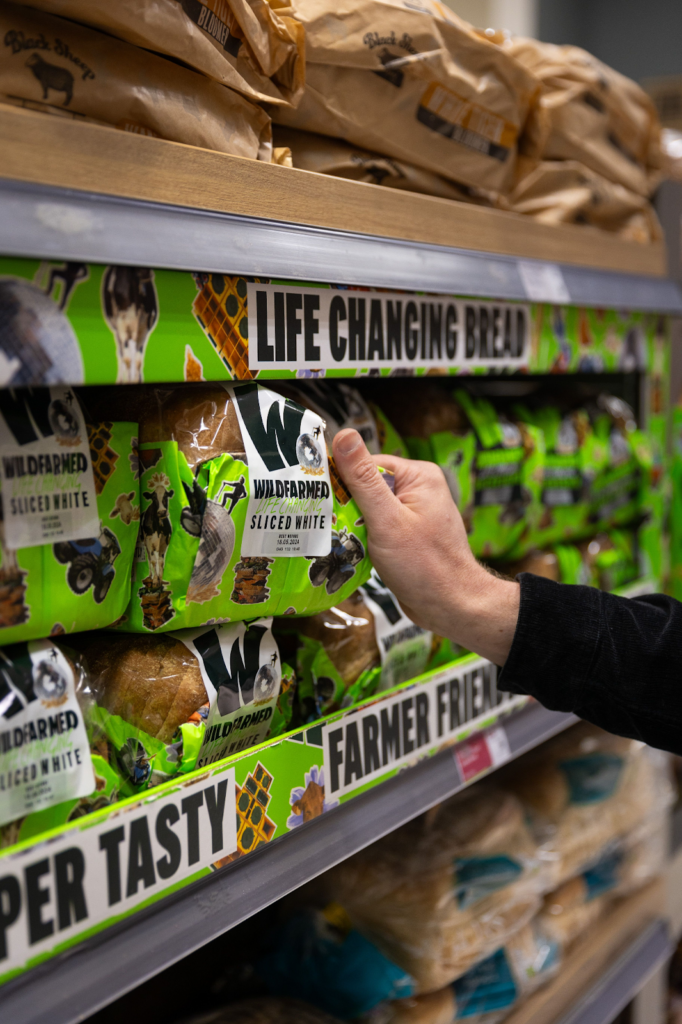
Last night, our growers had a post-harvest celebration in the beautiful, wooden dining room at Farm Ed. Farmers are the most resourceful people in the world, and, properly supported, can deliver whatever food and landscapes society asks of them. The last few years have made it clear to me that we can have a future in which farmers are getting fair returns not just for the quality of their food, but for the quality of the ecosystems in which it’s grown. We could have fields that are still full of healthy crops despite the wild changes in rainfall patterns because the soil can infiltrate and percolate water. We could have the brightest young minds coming into food and farming because it’s cool and aspirational. We could have NHS waiting lists coming down because we’re talking about food as medicine. We could have reports in the paper about species diversity going up and up every year. We can do all these things. It’s simply a question of whether, as a society, we choose to do so. As Jane Goodall put it, her diminutive figure on a grey, early morning Glastonbury stage this summer still inspiring new generations to action, “What you do makes a difference – decide what difference you want to make.”
*2019 Environment Act




-
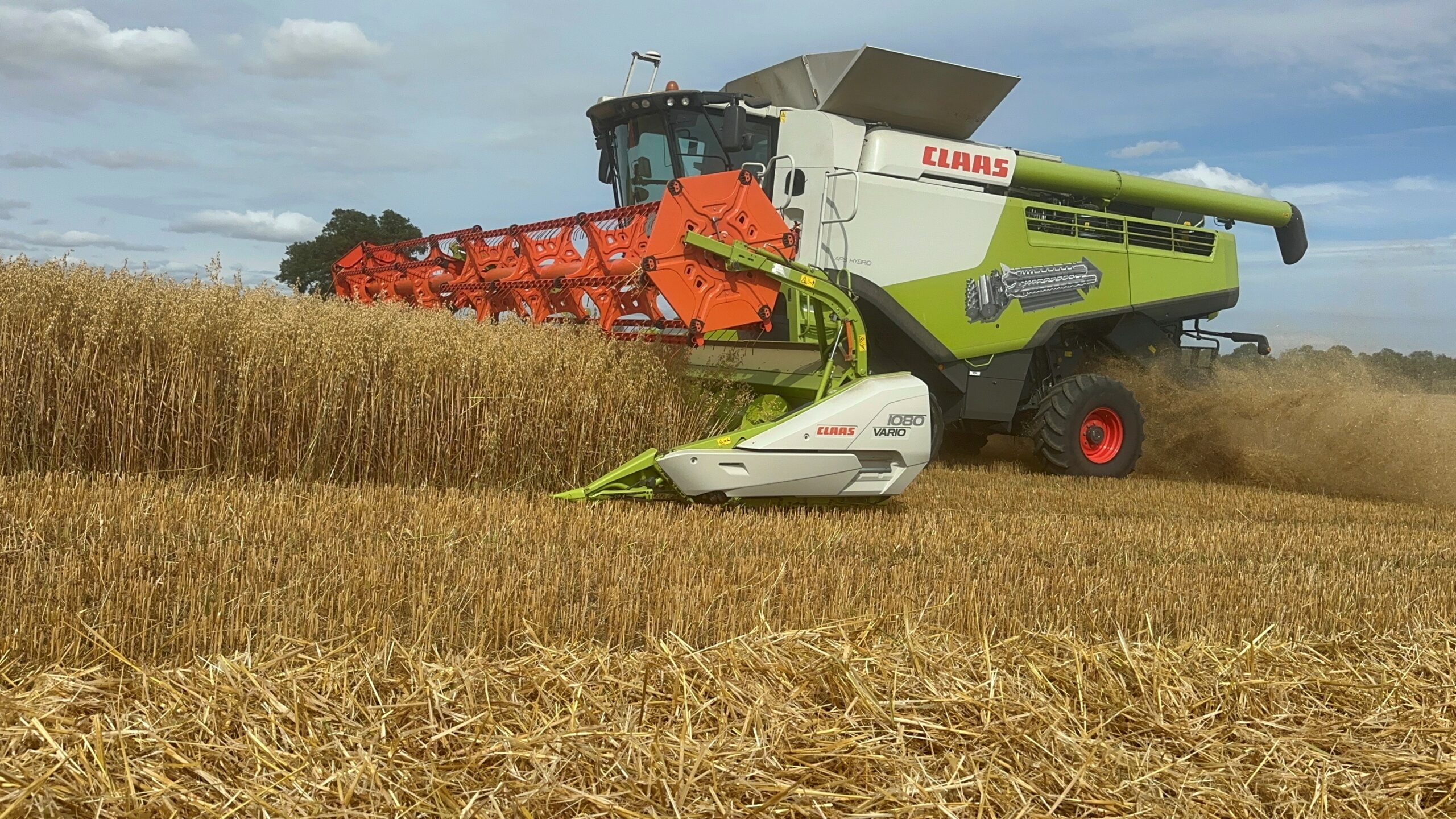
Timing is everything
Reflecting on last season’s challenges and the lessons learned Jeff Claydon, Suffolk arable farmer and inventor of the Claydon Opti-Till® direct seeding system, outlines some of the changes he will be making for the 2025 harvest.
August 2024
The title of my last article ‘The Good, the Bad and the Ugly’ (Issue 28 – July 2024) summarised the appearance of crops on our own and many other farms at that time. Unfortunately, that continued to be the case right through to harvest. As expected, those established on well-drained soils worked under the right conditions performed well, while those muddled into heavy land in poor conditions were downright ugly. But, as one of our contract customers said, ‘at least we were lucky to have a harvest.’
If last season taught us anything it is that farming successfully depends on working with, not fighting, the weather. Last autumn we pushed our luck a little too far based on idealistic thoughts of drilling later than normal. At the time, many were talking about how this approach would help to control grassweeds and as we prepare fields for drilling using only the Claydon Straw Harrow, an extremely fast, low-cost operation, we decided to give it a go. What could possibly go wrong? What indeed!
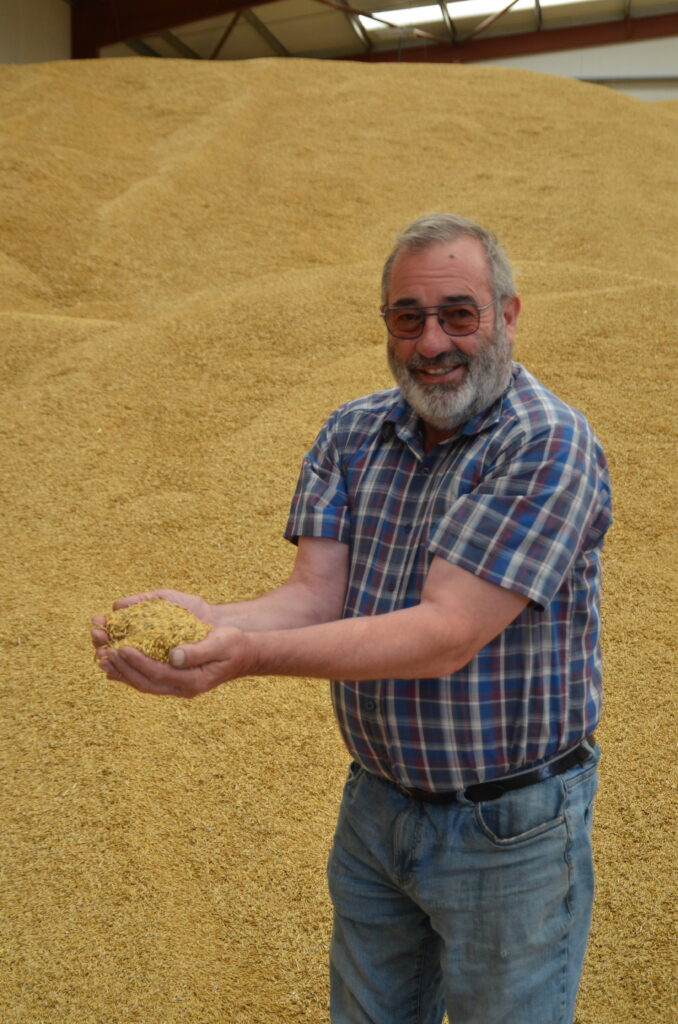
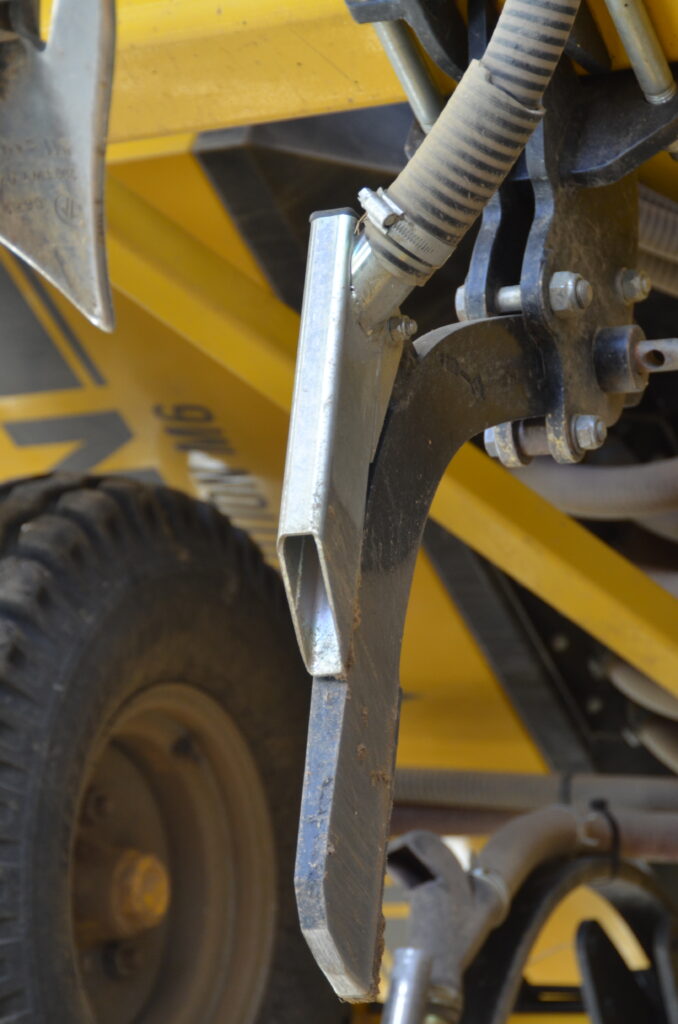
Failing to heed the advice which my grandfather gave me when I started in this industry, we overlooked the fact that you cannot farm based entirely on what date is showing on the calendar. We left it until 15 October before starting to drill winter wheat and on 11/12th October we had a deluge of 60mm of rain. Within three days of drilling, a further 90mm of rain fell. During the remainder of the month we had an average of 1cm per day after drilling!
Suddenly all the lights went from ‘green’ to ‘red’ and ultimately we paid a heavy price for going that route. Last season’s crops were amongst the most variable that I have ever seen on this farm in more than 50 years. There were multiple reasons why, including the fact that some crops were established in poor conditions, in places drainage was sub-standard, while slug and grassweed pressures, normally well contained, were exacerbated by the wet weather.
Looking through reports from Claydon customers last week I noted that some who drilled wheat on free-draining soils in the first week of October harvested over 11t/ha. Others, who mauled seed into cold, wet heavy clay soils at the end of the month achieved less than half that. Given the wet conditions our oilseed rape and wheat were never likely to make the ‘good’ category, but spring oats did make par relative to the long-term average.
Just before harvest we replaced our 12m Claas Lexion 600 with a 10.8m Claas Lexion 760 Terra Trac. Despite its narrower header the output is an almost identical 4ha/hr due to the combine’s latest technologies which increase throughput and forward speed.
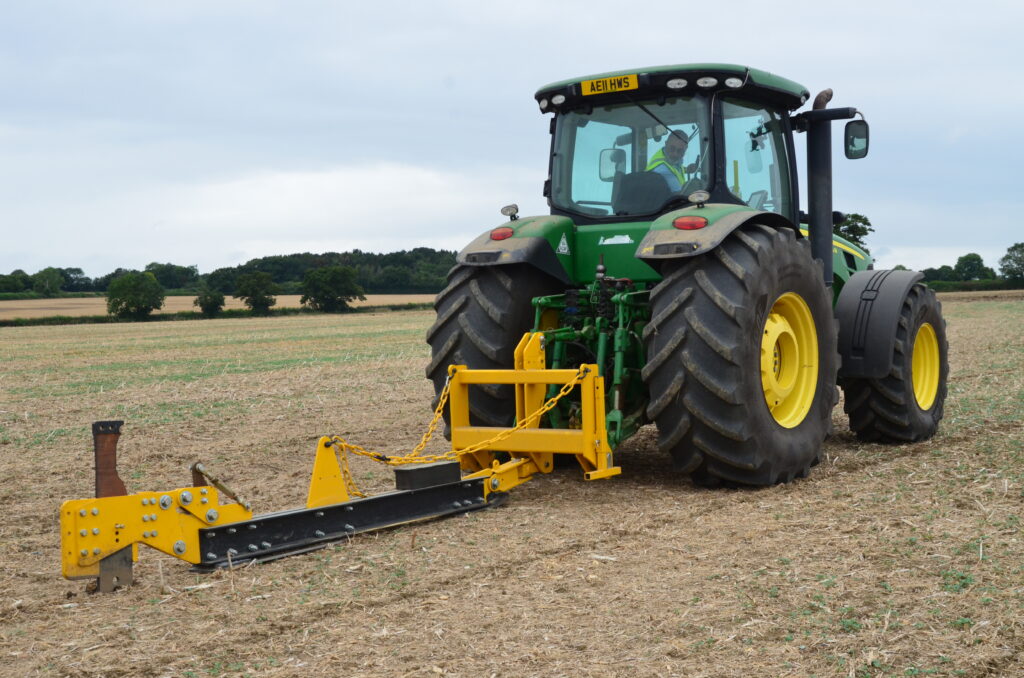
The new Claydon Mole Drainer was used extensively this year until the soils became too dry. We also part-exchanged the 2011 340hp John Deere 8345R which had been our main tractor for several years as it no longer had a real place in the fleet following the arrival of a 415hp Fendt 942 last season. Too big for jobs such as pulling our 15m Claydon Straw Harrowing and trailer work, the 8345R has been replaced by a 240hp Fendt 724 which is much more versatile and fuel efficient.
ADDED COMPLEXITY
Adding complexity to an already difficult season, ergot (Claviceps purpurea) resulted from the very wet weather. We recorded a smattering of it, 8-15 per sample, not a high level given the season and what was seen elsewhere, but the UK sets something of a gold standard, specifying zero ergot per sample for grain going into the human food chain and an EU-standard 0.001% tolerance for feed grains. Unfortunately, growers carry the additional risk of significant price deductions or the cost of rejected loads caused by a problem not of their making. Is that fair?
Reflecting on an exceedingly difficult season many of us would admit that, with the benefit of hindsight, we would have done some things differently. So where do we go from here? That may depend on whether you see the glass as being half full or half empty. On the Claydon farm we did not achieve the yields we wanted but moaning won’t do any good, so instead I am writing off last season as being ‘just one of those years.’ It was much the same in 2012, but in 2015, having done nothing different, we recorded 13t/ha.
We have decided to change our cropping plan for 2024/25. After struggling to grow oilseed rape in recent years, primarily due to the impact of cabbage stem flea beetle following the ban on neonicotinoid seed treatments, combined with lacklustre yields and prices which don’t warrant the high level of risk this crop entails, we have decided to stop growing it. Instead, we will extend the wheat area to two-thirds of our farm and the remainder will go into spring oats, giving a good opportunity to control grassweeds using a combination of chemical and mechanical methods.

The 6m Evolution drill and new Evolution Front Hopper being used to establish a cover crop, powered by the 415hp Fendt 942 Vario. STAYING POSITIVE
On a positive note, the Farming Equipment Technology Fund (FETF) 2024 grants are very welcome. These provide a maximum grant value of up to £8400 or 50% of the purchase price of Straw Harrows and £40,800 or up to 60% of the purchase price of drills which deliver fertiliser with the seed.
However, whilst well intentioned, the grant system is not without its issues. Announced at the end of February, FETF grants were to be available in three tranches throughout the year. As of today (31 August) the first is only just being finalised and the second has yet to open. Whilst some have received grants others are still part of the backlog. This situation is frustrating for farmers waiting to order the equipment they need, as well as for the machinery manufacturers and dealers who supply them.
Another grant scheme, the Sustainable Farming Incentive (SFI), also seems to have its problems. Potentially it provides significant benefits, with no-till farming attracting an annual grant of £73/ha for three years, companion cropping £55/ha, an overwintered cover crop £129/ha, and a spring/summer cover crop worth £163/ha.
On the Claydon farm we find the short-term cover crop scheme quite exciting. What’s not so exciting is the stipulated eight-week growing period. Even if we established short-term cover crops immediately after wheat was harvested during the third week of August the risks of late drilling potentially negate any financial benefits. Conversely, overwintered stubble can only be sprayed off in February, just before the spring crops go in, but how often is heavy land drilled at that time?
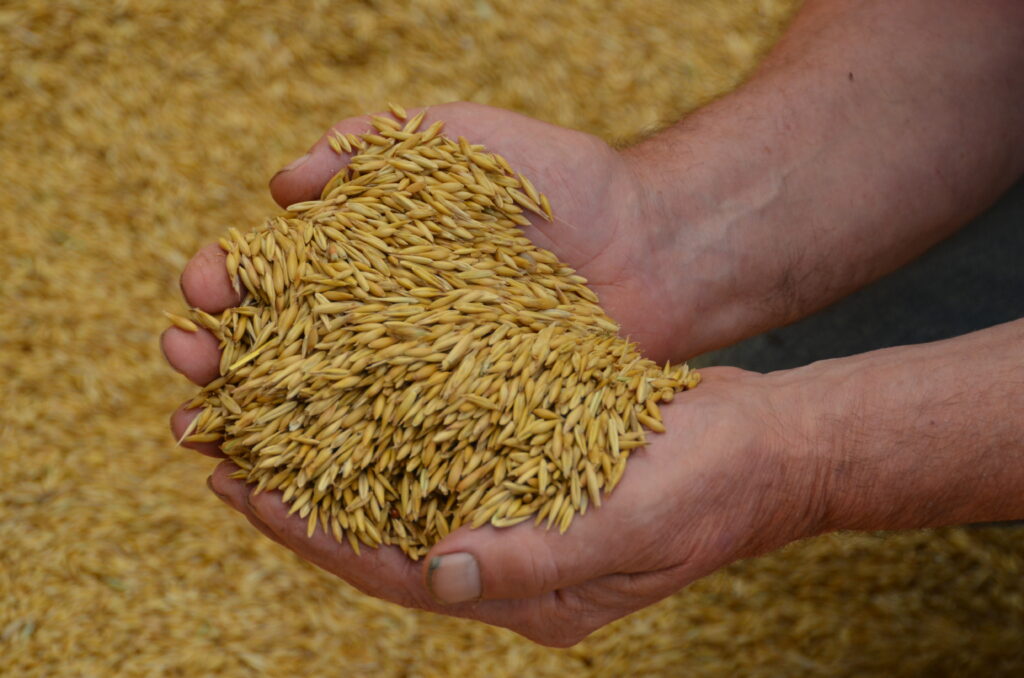
A sample of the Elsoms Lion spring oats. SOIL MANAGEMENT IS KEY
Correct timing is the secret to farming our heavy Hanslope series Grade 2 land successfully, but unfortunately last autumn we didn’t follow our own advice. With later drilling in mind we went onto wet soils in October to establish autumn-sown crops and that was a big, costly mistake.
This season we are being much more careful, keeping a close eye on the weather and drilling only when soil conditions are right. Hopefully, we will drill earlier than last season which highlighted that it’s not so much what you do but when you do it.
In the last few weeks we’ve gone from a situation where the drains were still flowing shortly before harvest to the soil cracking like crazy paving – an indication that it is drying and shrinking naturally. The question that many will be asking is whether to be patient and let Mother Nature do the job or intervene using mechanical means, despite the considerable time and expense involved.
After such a wet season when crops struggled to dry the ground sufficiently many will feel that they must subsoil to ‘repair’ the apparent damage. If you feel that might benefit your farm it could be the right thing to do, but my experience is that subsoiling brings nothing to the table and causes more problems than it solves. Aside from the small area which was subsoiled as part of our trials programme to provide a reference point this is not something we advocate. The combination of good field drainage, mole drains formed under the right conditions and the leading tine on all Claydon drills is more than adequate.
Following a very wet season in which many fields suffered prolonged waterlogging it is important to take effective action to improve any areas of inadequate drainage and eliminate excess water. This spring we invested £30,000 on new plastic drains to correct sub-standard drainage in areas highlighted by the extreme wet weather.
That has worked well and since then we have been busy with our Claydon Mole Drainer, which is very user friendly, simple to set up, easy to use and allows small adjustments to be made as the bullet wears to keep it operating at optimum efficiency. One-third of the farm was mole drained last autumn and another third this year, some in the spring and some immediately after harvesting oilseed rape, all in excellent soil conditions. Mole drains can last up to 20 years so doing the job well will pay handsome dividends.
At 5% to 7%, organic soil matter levels on the Claydon farm are well above average and digging down revealed root channels from last season’s crops, so clearly it is restructuring naturally. Over the August Bank Holiday 13mm of rain fell and 48 hours later the top 5cm of soil was in beautiful condition yet below that it was as hard as a rock. The hard, dry conditions meant that we had to stop mole draining during the second week of August. We plan to finish the other third of the farm in the spring through the standing crops.
In recent years we’ve become particularly good at minimising blackgrass in the autumn, but now it’s spring-germinating blackgrass that’s the issue. We are controlling it very effectively using a combination of chemicals and our 6m Claydon TerraBlade inter-row hoe, so hopefully persistence will pay off.
THE SFI OPTION
Having expressed interest in the SFI for the Claydon Farm but with no response from Defra, after harvesting oilseed rape at the end of July we drilled a short-term cover crop which looks good. We modified our 6m Claydon Evolution drill so that the fertiliser injector sits behind the front tines allowing the beans to be placed 75mm – 100mm deep directly into moist soil and they germinated very well.
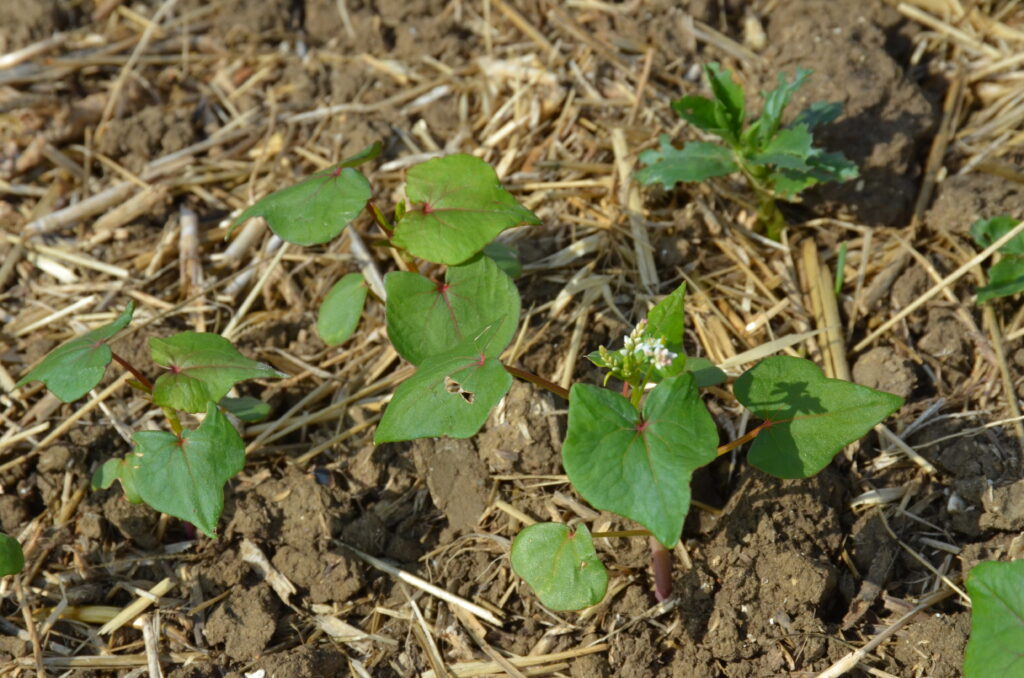
Buckwheat makes up 63 per cent of the cover crop mix. The other small seeds which make up the short-term cover crop we drilled behind wheat (Hutchinsons’ Maxi Catch Crop – Buckwheat (Polygonaceae Fagopyrum), Zoltan spring linseed, Ascot white mustard and Tabor Egyptian clover) are currently sitting in dry soil and have yet to emerge. It will be interesting to see if the cover crops encourage a flush of blackgrass when removed later in the autumn, something we can do as they are not under SFI. The plan is to follow with winter wheat and spring oats.
Even King Canute would have been challenged to deal with the tide of water which hit us last autumn. Farming is not an industry where you can be prescriptive when it comes to timings, so it is essential to adapt to the conditions which Mother Nature presents. This appears to be lost on some of the policymakers who make the rules which farmers must follow, and they seem to have little understanding of what happens in the real world!
Last season tested everyone farming at a practical level, so we must be open-minded and work out how to get the best results from our investment going forward rather than doing things the way we have always done. On the Claydon Farm we aim to start drilling during the last week of September or first week of October because even placing seed into dry soil when rain is forecast is better than waiting for rain and sowing into wet soil. As it is relatively easy to grow another good crop following a good crop our main goal this season will be to ensure that everything falls into that category rather than the bad or ugly.




-
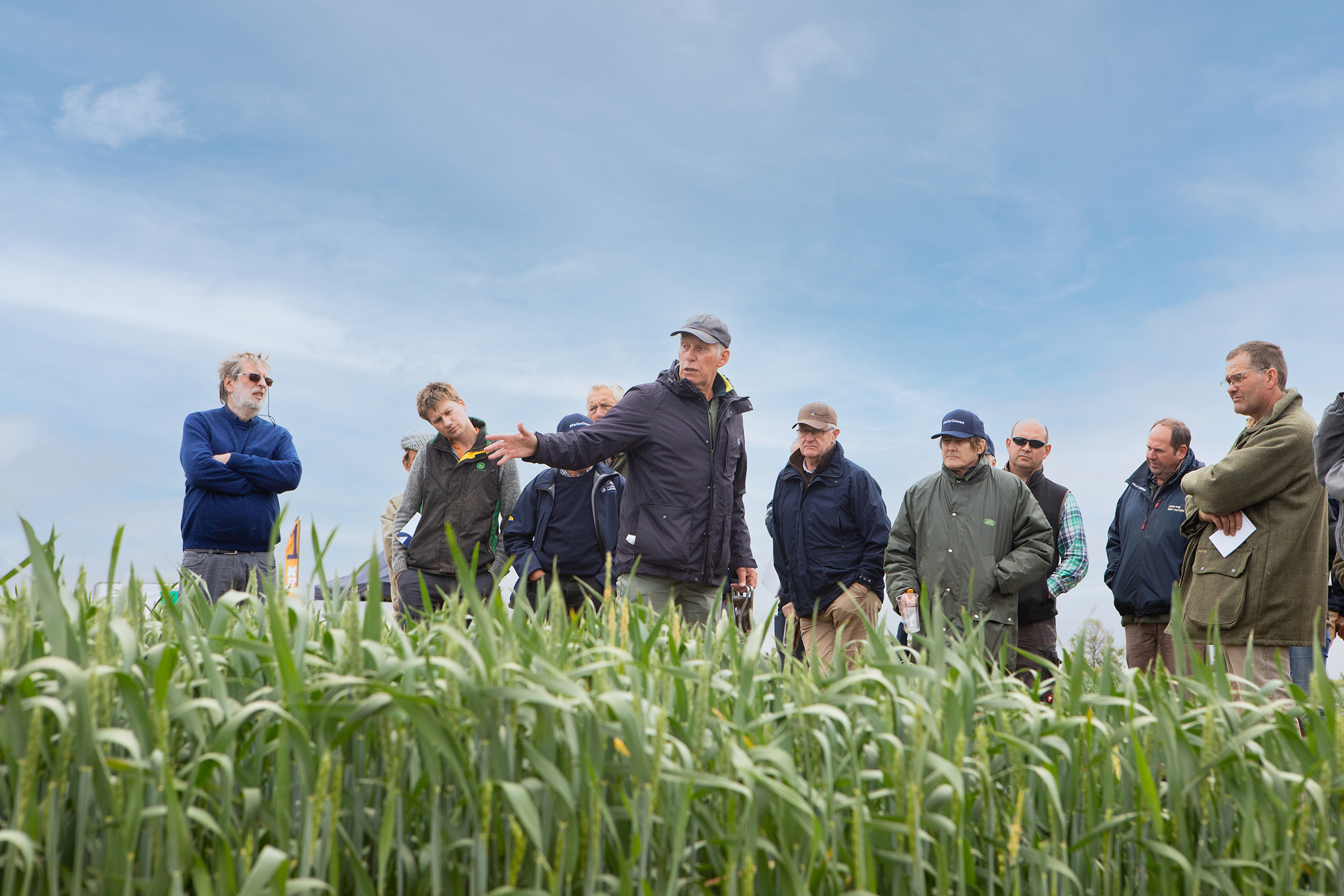
Early sown winter wheat returns to heavy land blackgrass site
High yielding, profitable early-sown winter wheat crops are once again a regular feature on the heavy land rotations at Lamport AgX, Agrovista’s flagship trials site in Northamptonshire, despite a huge background population of blackgrass.
Speaking at a recent open day, Niall Atkinson, consultant and Lamport AgX trials co-ordinator, said: “Historically, if wheats weren’t drilled by mid October you risked not getting them in at all. But going earlier was asking for trouble – blackgrass populations exceeded 2000 plants/sq m on this site before it was established in 2013.
“Lamport AgX is all about solving this conundrum. We’ve learnt how to do that, using sequences of autumn cover crops and spring break crops such as oats, beans or barley to reduce blackgrass pressure, minimising soil movement when establishing cash crops, and improving soil health to help create a favourable environment for wheat.”
The Lamport concept, backed up by an appropriate herbicide programme, has proved itself over several very different seasons. In 2023 first winter wheats averaged just under 10.5t/ha following a range of different crops, with some plots exceeding 12t/ha, with almost no blackgrass.
“After a run of autumn cover crop/spring breaks, we are now successfully alternating winter wheat with a cover/spring break,” Niall said.
“But you need to choose your fields carefully and stick to the guidelines or risk going backwards. You also need to be reactive – if something goes wrong and blackgrass starts taking hold, you may need to delay your first wheat and grow a further cover crop/spring crop break.”
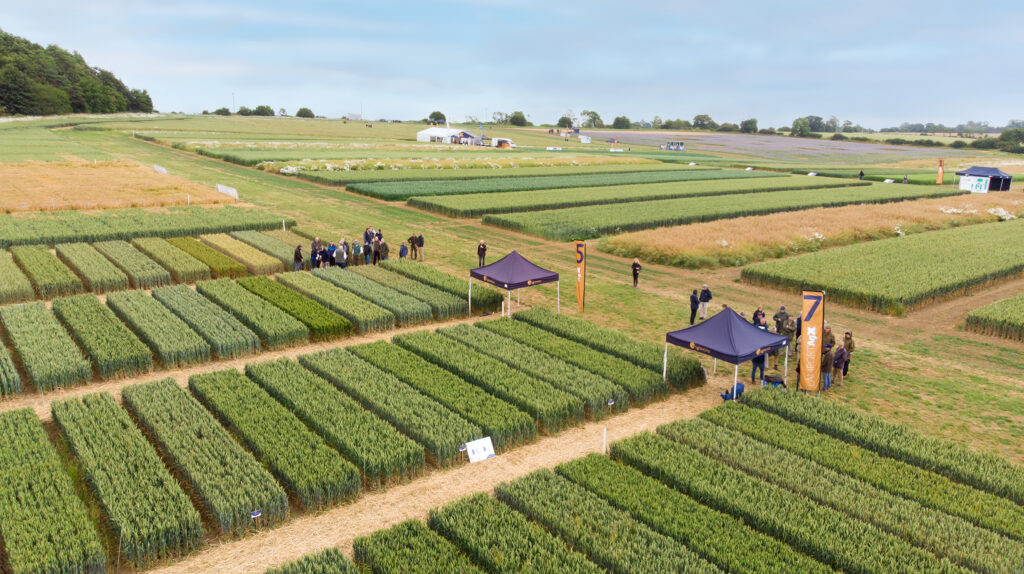
Integrating SFI into farming systems
Much of the work carried out at Lamport can attract valuable SFI payments. Over-winter cover crops, the mainstay of operations to control blackgrass and improve soil health are currently worth £129/ha, but that’s just the start. Several other options that now attract payments under the scheme are under scrutiny.
Whole field SFI actions are proving difficult to integrate into rotations at Lamport due to the enormous blackgrass challenge.
Winter bird food (AHL2) and legume fallow (CNUM3), look tempting on paper, paying £853 and £593/ha/year respectively. But both plots, which were drilled in April, have been destroyed.
Hamish Wardrop, Agrovista’s rural consultancy national manager, said: “The winter bird food established OK but there was a mass of grass weeds as well, and the pressure was too high to continue with it on this site.
“The legume fallow also established reasonably well, but it suffered badly with slugs, flea beetle and weevil. And we also have grassweed pressure.
“These actions can be a good choice in some situations, but you have to go in with your eyes open. We can’t lose sight of what we are trying to achieve in bringing back first wheats into the rotation.”
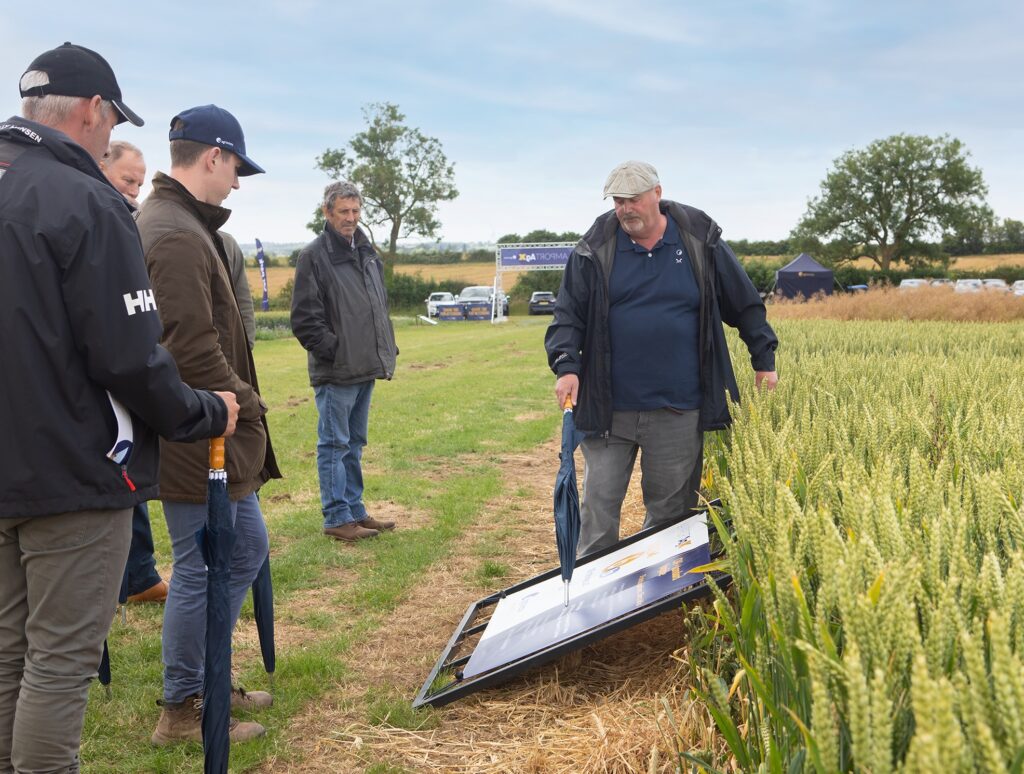
Low input cereals
A low-input cereal action (AHW10) aims to create an open-structured cereal crop that encourages wildflower species to grow within it, providing habitat and summer foraging for birds, pollinators and other wildlife.
It pays £354/ha/year under SFI, whilst a further £129/ha is available for a preceding over-winter cover crop.
Technical manager Mark Hemmant said: “Herbicides are restricted and you have to sow the cash crop at a reduced seed rate – we chose spring oats and went at two-thirds rate, or 270 seeds/sq m.
“We have to select carefully where to grow this action at Lamport, but we have achieved the aims; while is a little bit of blackgrass coming through, if you are well on top of grassweeds and have a good rotation, it could be useful.”
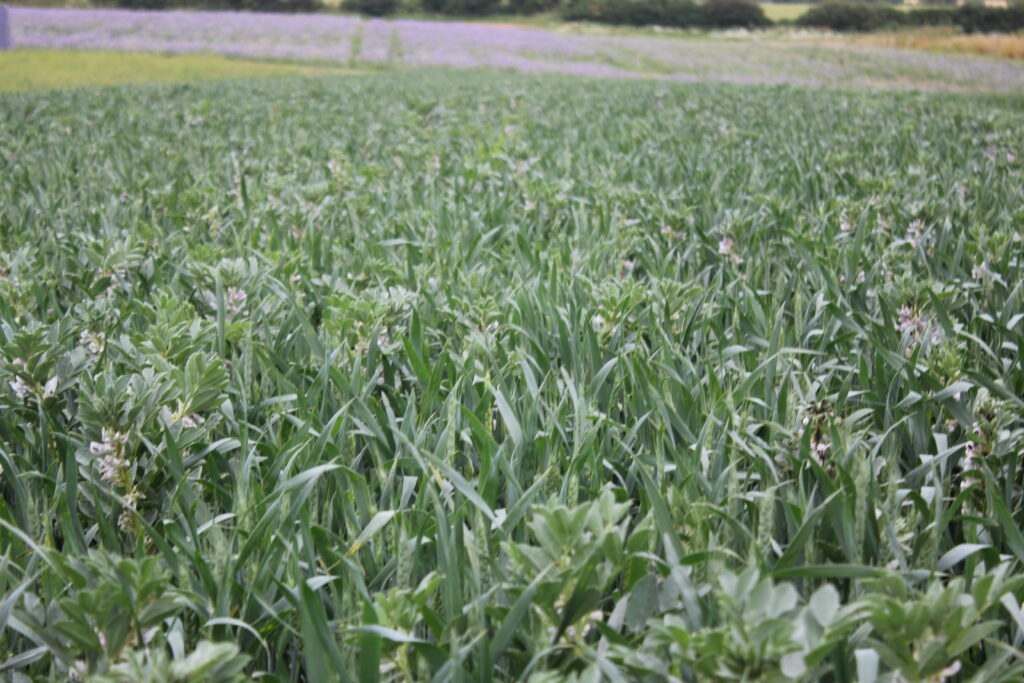
Spring wheat and beans
The benefits of adding beans to a spring wheat crop at 10 seeds/sq m are also being assessed. That would attract a £55/ha companion crop payment under SFI for a seed cost of about £15/ha, and could help mitigate take-all.
“The net benefit of what you spend on bean seed compared what you get back looks good, provided there are no adverse effects on blackgrass control or yield,” said Mark.
The beans were destroyed around flag leaf timing as some inputs are not approved for that crop, but the crops appear to have thrived.
“We know at Lamport that black oats in the cover crop aren’t enough to prevent take-all in a wheat-dominated rotation in an autumn like 2023,” he explained. “But if we introduce wheat plus beans in the spring, might the undoubted soil benefits that beans bring change things?”
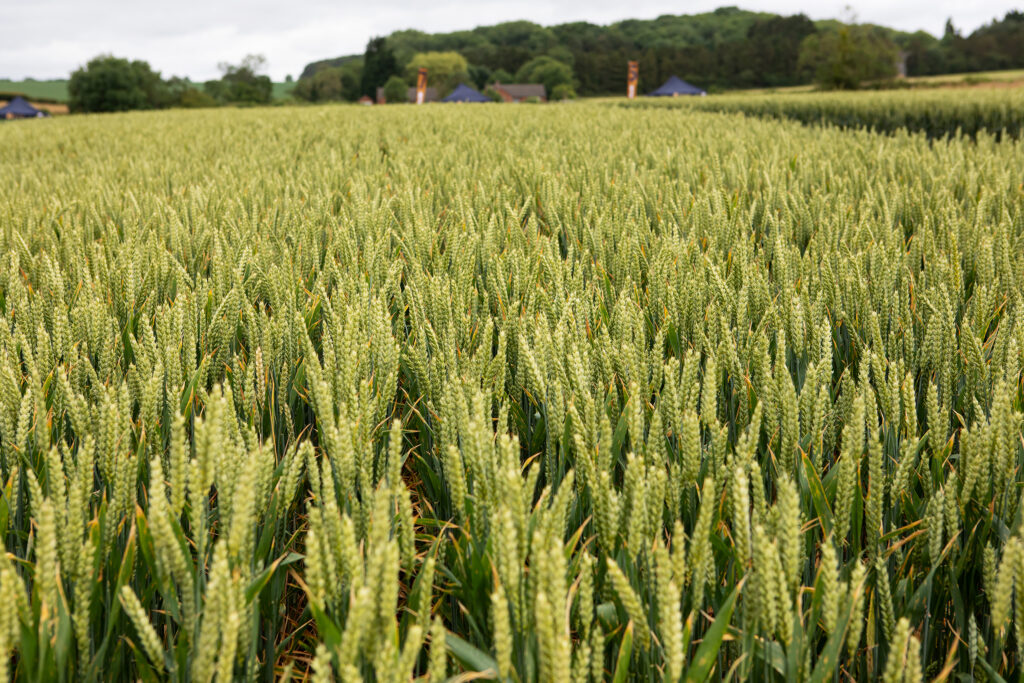
Does direct drilling affect herbicide choice?
On any farm with a grassweed problem, selecting the best herbicide programme is vital to reinforce the effect of cultural control measures to achieve optimum control.
However, there is little information available on whether different cultivation strategies, particularly direct drilling, affect herbicide efficacy.
In previous years Mark has generally found cinmethylin (as in Luxinum Plus) and aclonifen (as in Proclus) to have similar activity on blackgrass. However, cinmethylin is claimed to have an impact on seed on the surface, so a trial to assess whether it might be a better pre-emergence option was set up at Lamport in 2022/23 and continued this season.
The trial compared blackgrass levels and wheat yields across several cultivation strategies, ranging from direct drilling to deep loosening. These were treated with five pre-emergence regimes – untreated, aclonifen/DFF/flufenacet, and cinmethylin/pendimethalin/picolinafen, both +/- triallate (as in Avadex).
“In two very different years we did not see any significant benefit of cinmethylin over aclonifen-based herbicide options pre-em, even where direct drilling,” Mark said.
“Although not statistically significant, the aclonifen-based herbicide appeared to work better in the dry conditions of autumn 2023 and exhibited better crop safety in the wet autumn of 2024, the latter particularly with establishment systems where less soil was moved and or where shallower drilling took place.
“In addition, consistent benefits of moving less soil in grassweed levels and of including Avadex were seen in both seasons.”
In other trials, best control of blackgrass has consistently come from using both actives in sequence – aclonifen pre-emergence followed by cinmethylin early post-emergence.
“The results from the Lamport trials confirm that this approach, and that the addition of Avadex pre-emergence is appropriate whatever the cultivation method,” said Mark. “And it reiterated the fact that moving less soil reduces grassweed pressure.
“The take-home message is that no herbicide programme is good enough on its own,” he added. “Heavy infestations of blackgrass also require appropriate cultural controls to achieve the desired result.”
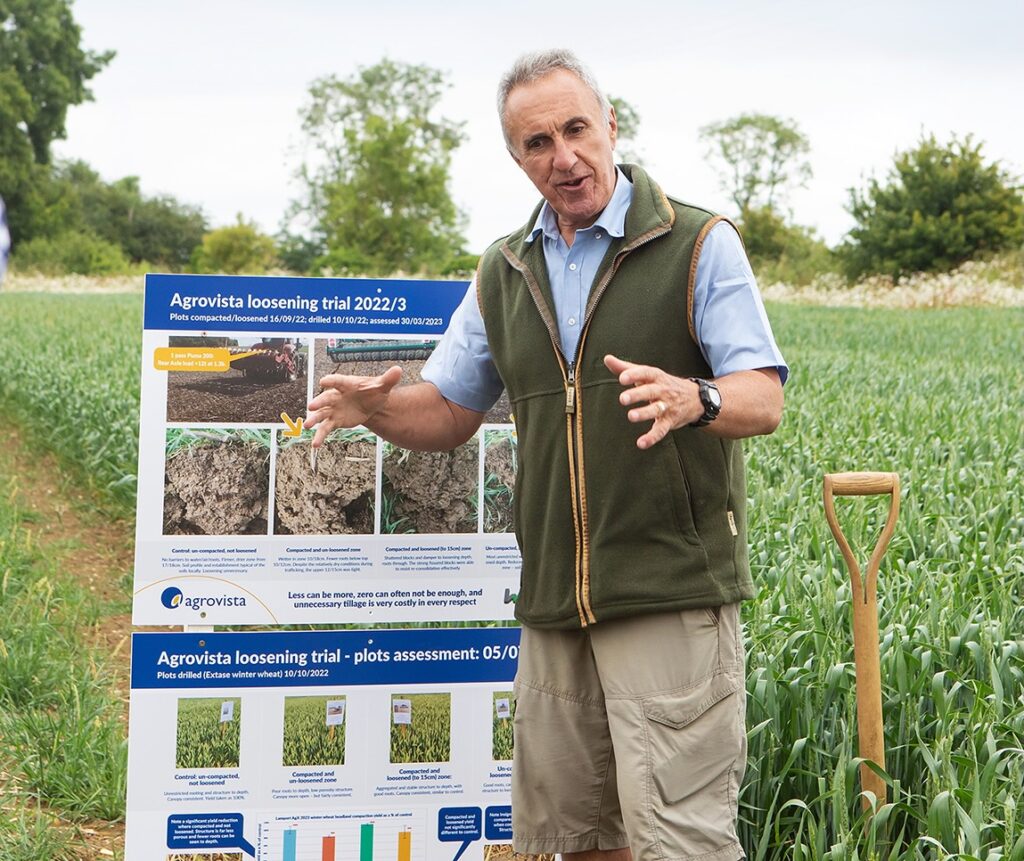
Low-pressure tyres on test
The effectiveness of new low-pressure tyre technology in reducing soil compaction was put to the test at Lamport this season.
The trial used a John Deere 6155R tractor with a mounted 3m Weaving direct drill running on Michelin AxioBib 2 VF tyres or and Galileo AgriCup tyres.
The AgriCup is a low-inflation design that, according to the manufacturer, combines the benefits of pneumatic tyres and rubber tracks, producing a 17% larger footprint than a standard tractor tyre.
Tyres were tested on winter wheat and peas drilled after an over-winter cover crop established on soil previously loosened to 15cm.
Independent cultivations consultant Philip Wright said: “The VF tyres were run at 18psi, which is clearly quite extreme, and 11psi, as low as we dare go with the loaded mounted drill. The AgriCups were inflated to 6psi.”
The untrafficked area between the wheelings unsurprisingly looked the best. Of the trafficked areas, the VF at 11psi left the best soil structure and the best crop rooting and canopy for both peas and wheat.
The AgriCup was marginally behind, causing some surface compaction and intermediate rooting but a good canopy. The 18psi VF tyre created the highest surface compaction and poorest rooting.
Earlier work elsewhere carried out by Philip has shown cereal yield losses rising to 30% on heavy soils in areas trafficked by a tractor fitted with VF tyres inflated to 14psi towing a 3m direct drill.
Whilst not pre-judging the Lamport results, he said: “The AgriCup tyre has quite a robust construction, so in damper conditions we could see a slightly greater imprint.
“The biggest markets currently are for skid-steer loaders and irrigation gantry systems, but they could be useful on a crop establishment system that uses quite heavy rear-mounted kit,” he added.
All plots will be taken to yield.
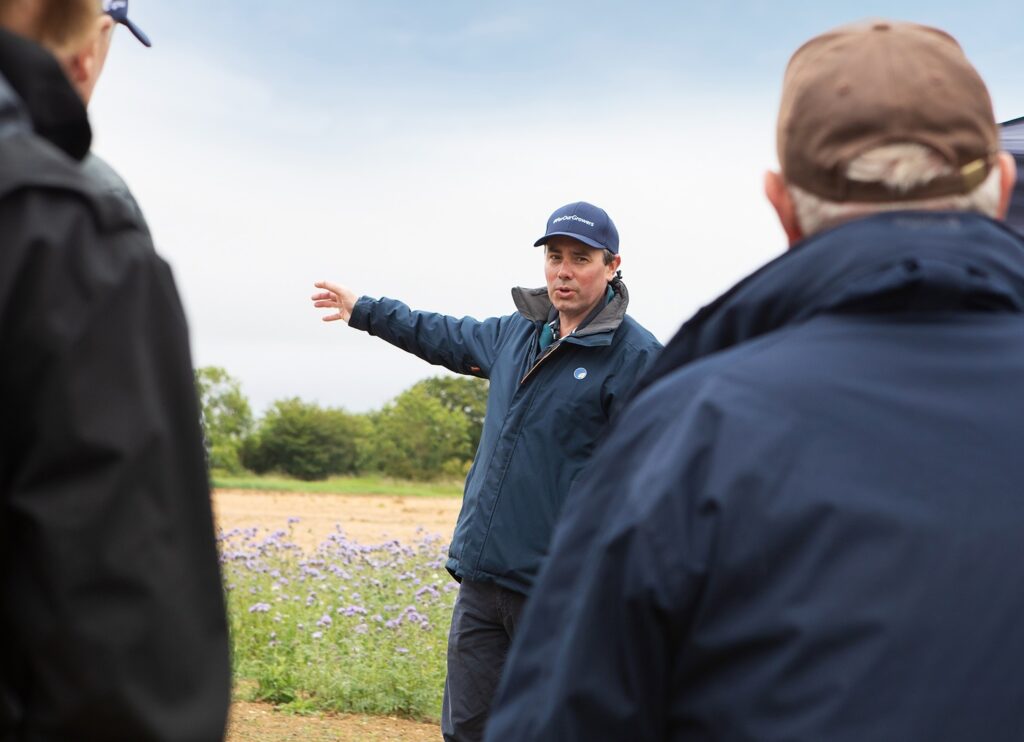
Avoid unnecessary soil loosening
The importance of avoiding unnecessary subsoiling operations was clearly illustrated in results released at the Lamport AgX open day from trials carried out in 2022/23 on Lamport AgX’s difficult silty clay loam.
Loosening an uncompacted plot with a low-disturbance subsoiler to 15cm before direct-drilling winter wheat created an open structure between the subsoiler legs and resulted in good root growth.
However, soil disturbed by the legs was left more fragile and slumped to depth, stifling root growth and creating an inconsistent wheat canopy across the plot.
Yield on this plot dropped to 86% compared with an adjacent uncompacted and unloosened plot, nearly as bad as a compacted plot.
“Less can be more, so check soils carefully,” said Philip. “If they don’t need loosening – they are better left alone.”






-
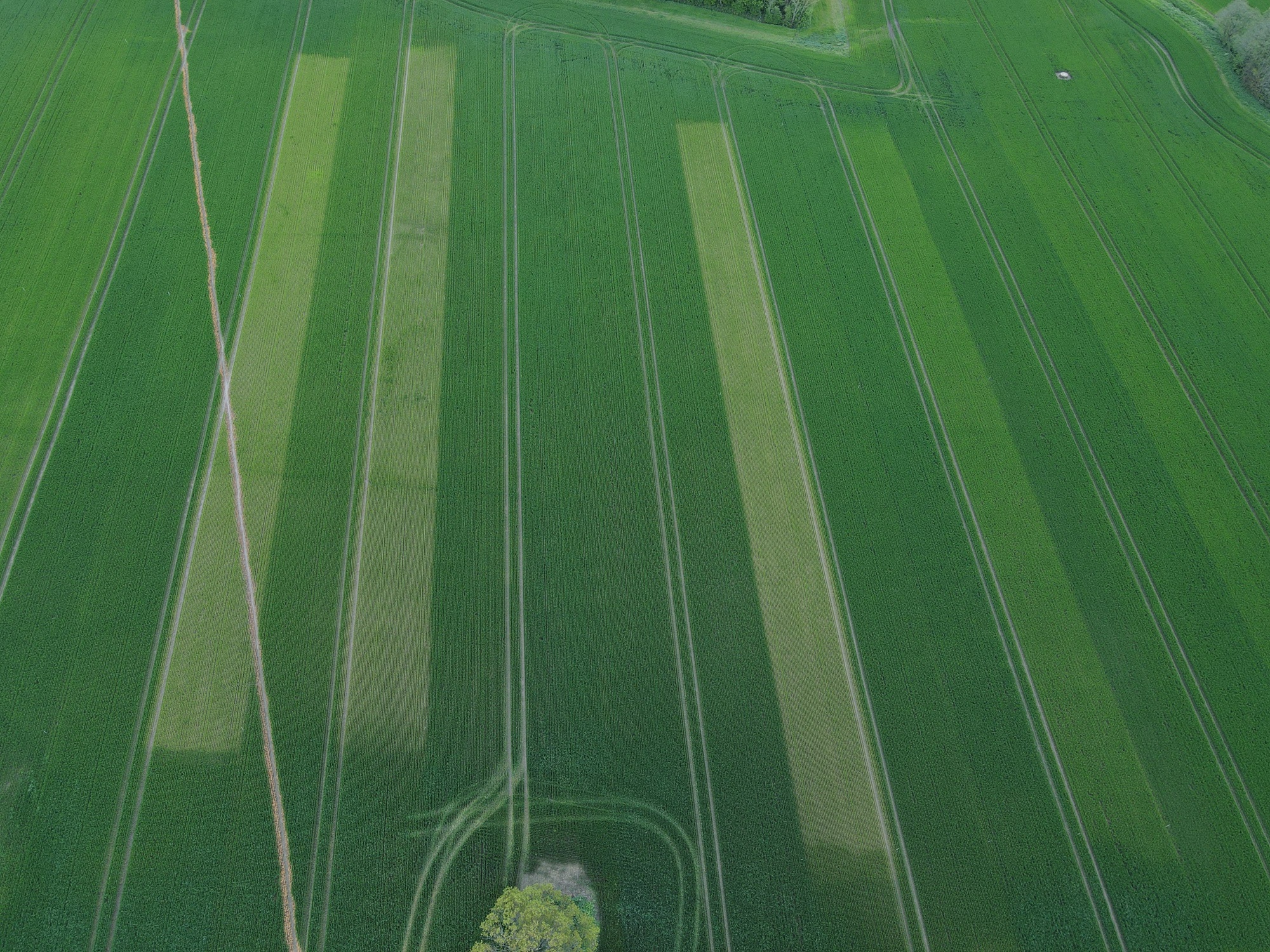
Farmer Focus – Andy Howard
Innovation: Fun but potentially painful
I was recently nominated for the BBC’s food and Farming Awards under the “Farming for the Future” category. Awards are not really in my comfort zone and I thought hard about whether I wanted to accept the nomination. What convinced me to accept the nomination was the fact that the BBC are impartial, with no commercial input/bias in the awards. At the time of writing the judges haven’t yet visited. Their imminent visit has made me reflect on what we have trialled over the years, it’s not until I stopped to think, that I’ve realised how much we have done. I guess some would argue that I’m addicted to on-farm trials and they may be right. I’m a firm believer that you need to trial new ideas on your own farm to see if they work for you. Going to trial plots around the country can be interesting but can also be irrelevant to your own situation.
With this in mind I thought I’d use this article to talk about what we’ve trialled this year, the results and what we plan to do next season.
We have had 2 big replicated trials on the farm this year. The first is trialling the impact of Compost Extract on wheat yields and nitrogen need, with Kent Wildlife trust and Reading University as partners. Plots were with and without extract and 4 different nitrogen rates from 0 to 240kg/N/ha. Initially in the autumn I was very excited about this trial. The plots with compost extract applied with the seed had much larger root systems. This difference disappeared as the season progressed and in the spring I could not visually see any difference between with and without extract plots. So it was a surprise that in terms of wheat yields the extract plots gave an average of 0.4t/ha yield increase. This though was not statistically significant as you need a 95% confidence and it came up just short at 93%. We are doing the same trial again next season and it’s being expanded to two farms. With a few tweaks we hope for a more positive result next year.
Our 2nd replicated trial on farm is part of a Project called N2 Vision+, it’s partially funded by Innovate UK and is in conjunction with Manchester Met University, Royal Holloway University and Autodiscovery Ltd. The idea is to be able measure nutrient content of plants by using visual digital instruments and then apply the nutrients needed regularly using foliar fertiliser from a robotic platform. We have already proved that using deep learning we can detect nutrition using digital imagery. This year we trialled trying to replace all wheat nitrogen demand through foliar fertiliser and comparing to solid fertiliser. Unfortunately border control got in the way of this trial. The application equipment needed for the trial came from France, it got stopped at the border for weeks and mired in paperwork ( a Brexit benefit?). This meant we started foliar applications too late and they never caught up. I do believe we can get more out of foliar fertilisers but it involves going through the crop multiple times which isn’t practical for a crop sprayer but hopefully is for a robotic platform. The numbers are still being analysed at the moment.
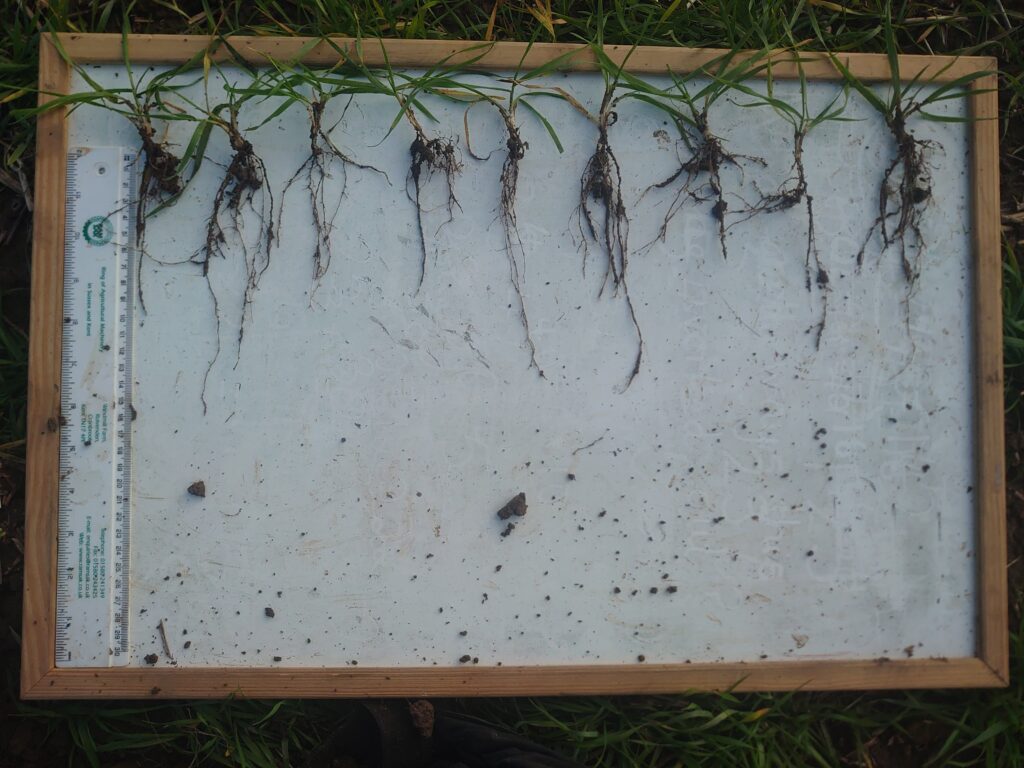
We also had a number of simpler (less scientific) tramline trials. The first was comparing different companion species for planting with wheat. I had done the trial 4 years ago and so had a good idea of what wouldn’t work. This year we trialled: beans, vetch and peas and a combination of all 3. Beans were the best but we are going to plant a mixture of all 3 to spread our risk. Also I am going to trial broadcasting linseed before drilling to give extra biomass going into the winter. The seed for this trial was kindly donated by Kings Crops.
Bean foliar disease as we know can be devastating in terms of yield if you get treatment wrong. So after hearing of Ben Taylor Davies’ experience of using Scyon, a biostimulant, last season I decided to trial the product here this season. The Scyon plots had 3 applications of biostimulant and the plots next door had no Scyon, but had fungicide applications as needed. During the season (which was wet and ideal for Chocolate Spot) we couldn’t see any difference. The combine also showed no difference. This gives me confidence to expand it’s usage next year and try on other crops.
A trial we repeated this year was with Protozoa tea. Last year we saw a moderate yield benefit in wheat but a huge yield increase in Herbage seed.
This year we saw the same again, the interesting observation from this year was that where we applied the tea last year as well as this year there was an even bigger yield benefit. The benefits seem to compound. The usage of Protozoa tea here seems very beneficial.
Not an official trial but confirms a previous trial done, was with the use of wheat variety blends. We had two fields next to each other. One a crop of Crusoe and the other a 5 way blend of varieties including Crusoe. The crop of Crusoe got Brown rust very early and took us by surprise, the rust was impossible to eradicate and ended up reducing the crops leaf area. In the end the wheat blend yielded 2t/ha more and we spent £100/ha less on fungicide. It’s a simple technique that seems to work for us.
This coming season I am not certain of all the things I will be trialling. One trial that is already in the ground is a seed rate trial in Overwinter Cover Crops. There’s a French researcher who reckons we don’t plant enough seeds in cover crops, so we’ve doubled the seed rate in an area. The idea that over a number of years using “intensive” cover crops you can start to reduce artificial fertiliser. We’ll see!
In summary, I would encourage everyone to do on-farm trials but be prepared for failure! Also, don’t take one years results as gospel. Every year is different and results will change.
Most importantly don’t take my word or anybody else’s word either. Try it yourself, on your farm. Good luck!


-

Have you ever had a lightbulb go off in your head? A true ‘Aha’ moment?
Daniel Iddon of Woodland Grow came to the realisation that the soils we use to grow plants often simply aren’t purpose ready even though there may be crops growing at the moment: you can do EVERYTHING right, but still not get the bumper crops due!
Written by Erin Wiedmer, Director, Woodland Grow Ltd
“How does that make sense?”, you might well ask, “Isn’t soil, soil?”….. I would answer with a resounding NO!
Soils are part of a continuum – there are soils which are highly bacterial which are found at one end of the spectrum, and soils which are highly fungal found at the other. There is a natural process of evolution from bare rock materials, to deserts, to fields, and finally to forest floors that bounce back when they are walked on. Each of these soils will have different sand/silt/clay profiles which will develop from weathering, but the really interesting part is what happens in the soil organic matter, where most of the life is found. We are starting to understand that it’s this biological part that drives the chemistry and physics as opposed to the reverse.
The living component is where the nutrient cycling starts, and acts as the basis for the entire soil food web starting with plant. We all know that plants produce sugars by photosynthesis, but we are less aware of how the plants get nutrients beyond the sugars – the NPKs, sulphur, boron, calcium etc. Bacteria produce enzymes which break down rocks and mineral particles found in soils to extract the particular nutrient they are after. They are extremely effective at this – although they just produce one enzyme at a time so must focus on a single nutrient. (Look at the efficiency with which bacteria can extracting the calcium from teeth – even causing cavities given enough time!) Fungi on the other hand, make many enzymes and are capable of breaking down many chemical bonds simultaneously – but they aren’t quite as efficient so they take chemical molecules and they rebuild them into super complex shapes to make it harder for the bacteria to access them. They act like mini-refrigerators holding onto mineral crystal deposits for future use. Often, they will grow mycelium which are like underground networks, to rope together soil particles and keep them close at hand to ensure their mineral source and water are available when needed. These fungal networks are often invisible to the bare eye, but some can be seen as white threads when there are enough of them, if you look in the right places.
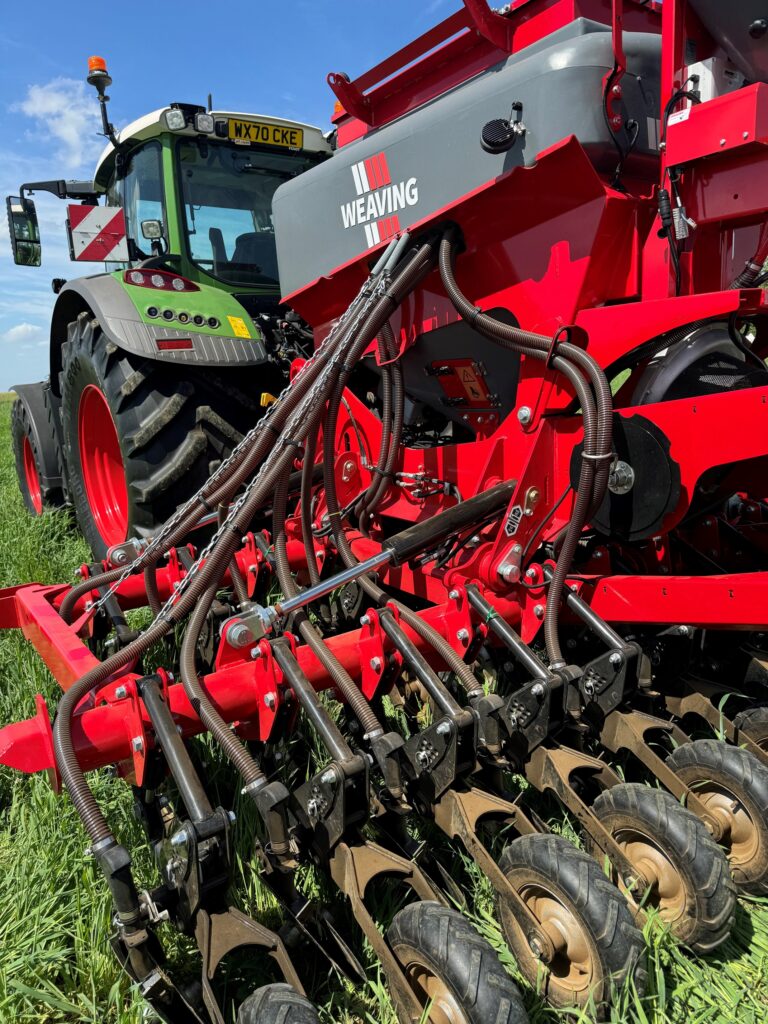
These bacteria and fungi are some of the densest sources of available N,P,K and micronutrients to exist in nature and they are the basis for the entire food web. The predators of these organisms make up the next level of the food chain, being protozoa and good nematodes (not the root feeders!) that eat enormous amounts of bacteria and sometimes fungi, and then excrete the excess minerals, which then are available for other organisms, such as plants, to ingest. This cycle repeats itself, as the nematodes and protozoa are eaten by mites and microarthropods, and larger nematodes and then worms, larger macroarthropods, lizards, birds, etc. etc. As each trophic level consumes the level below, the concentration of nutrients becomes toxic, and the excesses are excreted, to repeat the cycle as it becomes food for other organisms. The organisms at levels must be present in the right numbers to form a pyramid shape to support the system. For example, a protozoa can eat between 10,000 to 16,000 bacteria per day but without the proper balance in numbers, the system will collapse. It is the constant interplay between growth and predation that makes nutrients flow for plants to take in.
Depending on the makeup of the soil and the general climatic conditions, you will likely find various numbers and ratios of these bacteria and fungi, protozoa and nematodes. Each tends to operate in very thin bands of conditions such as temperature, humidity, pH, oxygen levels etc. With a change of just a few degrees temperature , or humidity, the microbe communities may change dramatically: some will go to sleep until the conditions are more favourable, and others become active, taking their place but within a separate climatic band, so having the diversity is essential. The absolute and relative numbers will determine how well your soil can support your crops throughout the year.
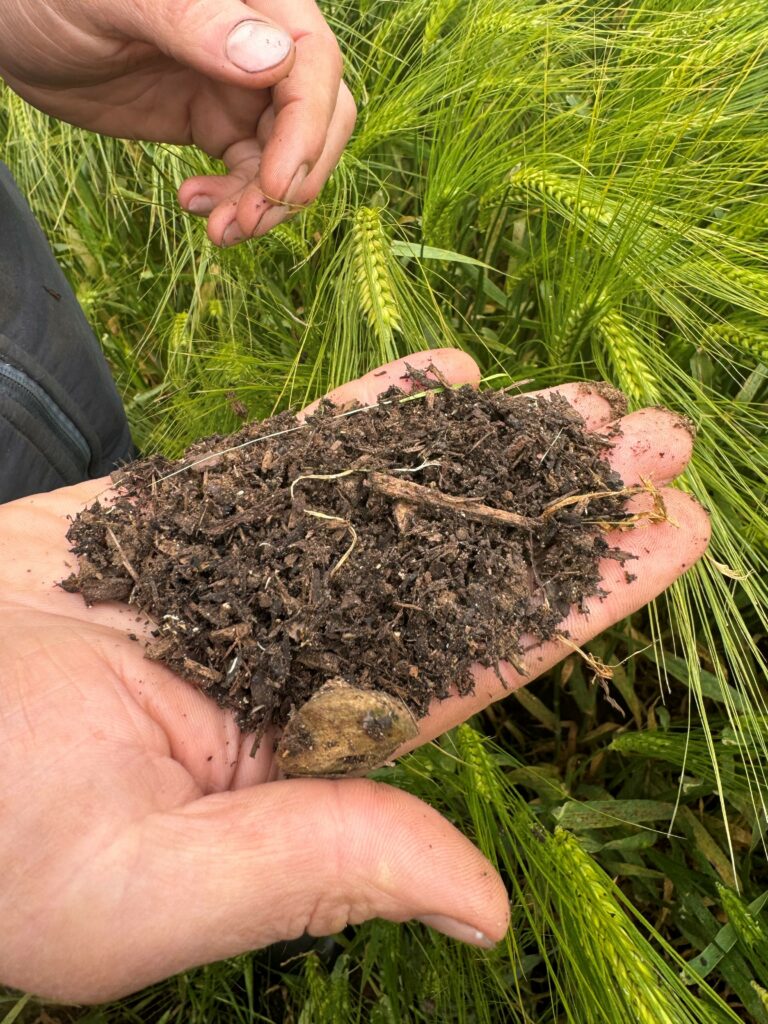
Coming back to Daniel, he had his ‘Aha’ moment when he realized that in a nursery, plants are not being fed by the soil – they are being fed by the synthetic fertilisers that are continuously applied. When the plant is put into the ‘real’ world, where it has to fetch these nutrients for itself, it needs these bacteria, fungi and higher levels organisms to be present and active in the root zones for the plants to access them. There is a nature gap!
The microorganisms don’t grow when the plant has been fed the synthetic fertilisers. The same is true for fields where synthetics have been applied. The soils have lost their ability to cycle nutrients and until the microbiome is rebuilt, the land can no longer optimally feed the crops naturally. This is where we start to see foliar deficiencies, where the plant will draw nutrients from its own tissues to maximise the survivability of the seed.
After years of trials, Woodland Grow now has a technique to encourage the growth of these soil communities while still supporting the nutritional needs of the crops, having grown various plants from lettuce to Giant Sequoia, and everything in between.
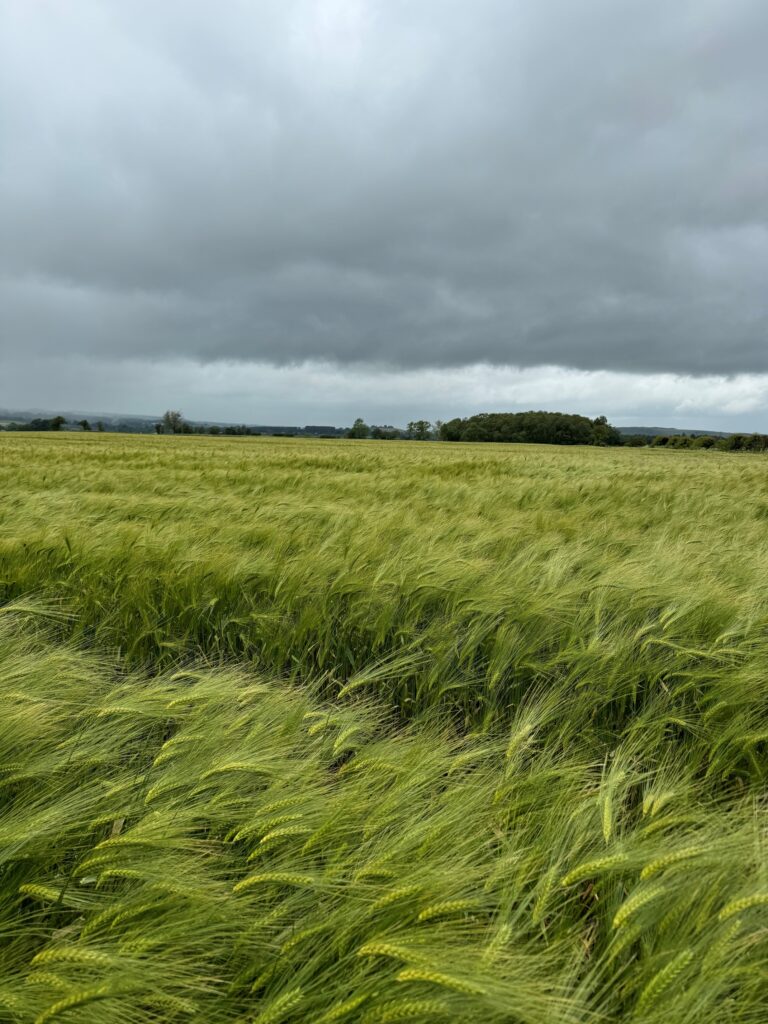
When we feed plants synthetic fertilisers, and use pesticides and herbicides, we inadvertently kill the microbiology. Plants have to grow their own microbiomes. Normal seeds (not GMO which are sterilized) come with the microbiome of the parent plants: millions of microbes adapted to the local growing conditions are held within and on the seed. These microorganisms grow around the roots as the seed germinates and consume both the minerals in the substrate, and the sugars fed to it by plants in exchange for the minerals. Plants have been shown to give between 40-70% of these sugars as root exudates. It goes to show how vital this is to the plant’s health. This symbiosis is how plants grow in nature and how the microbiome develops.
Each community will have different players and different numbers of certain organisms depending on the plant’s needs. When we have an early succession plant, such as a tomato or cabbage, it’s needs, and therefore its microbiome, will be quite different than those of a cereal or a tree-crop. Generally, we find that the fungal to bacteria ratios follow a standard pattern, even if the individual players are quite different. This makes planting a tree in the middle of a field a difficult proposition even if the tree seems healthy when planted, and the soil in the field produces a healthy cereal crop: the microbiomes don’t speak the same language – they have a nature gap – and unless the tree is capable of growing its own microbiome quickly enough, it risks dying.
Feeding synthetic fertilisers results in the plants limiting or stopping entirely the sugar exchange with the microbes for nutrients, because the nutrients are provided in the feed for free. It costs the plant a great deal of energy to produce these sugars through photosynthesis, so it will hold onto them where it can. This strategy works only for as long as the fertiliser is present – which often is a very limited time. As we know, some nutrients, like N, are highly soluble and will wash away with the slightest rain unless they are held in place by the biology. If the microbes starve because the plant withholds the sugars, they are no longer present to exchange with the plant when the plants needs them.
Sometimes we apply glyphosate to the soils. Glyphosate is a patented and effective antibiotic, even though it isn’t sold as such. Killing the bacteria and the fungi results in less capacity for the soil to support life. Tillage does the same thing: it slices and dices the fungi and microorganisms, so they die and are no longer present to function as intended. This results in compaction even though it seems like we’re opening up the soils when the plough passes: the mycelium provide that special soil structure and without them, the soil collapses and the nutrient/water “highway” provided by them is reduced.
How can we ensure that there are enough microorganisms and that they can communicate with the soils beyond the seed? This is our specialty at Woodland Grow. We look at soil samples and measure the numbers of soil microbes that are in proximity to the roots to ensure there are enough different types and numbers of individuals to be able to support the needs of plants. It isn’t enough to sprinkle one type of microbe – like nitrogen fixing bacteria or a particular fungus – to solve the problem. That is simply pushing the system out of kilter to fix one issue, but not actually addressing the underlying cause which is a dysfunction in the microbiome of the soil.

Woodland Grow decided it was time to take action and find a permanent solution to the damage of synthetic fertiliser applications. We have managed to grow living soils with high microbial numbers that we match with nutrition in order to support farmers who are trying to decrease fertiliser application but whose soils are not quite cycling nutrients on their own. Our results show healthier, more nutrient dense crops and lands that have a higher carbon content after even one season.
We travel from farm to farm and forest to forest around the country taking samples of the soils for our clients which we analyse under the microscope or with eDNA. Most of the soils that we see are deficient in fungi and the higher order microbes, meaning there is no natural cycling of nutrients available to the plants. This results in lower crop yields, less nutrition, and pest and disease problems. We can often see this by the weed pressures, compaction and water runoff as well.
Woodland Grow’s mission is to help farmers repair their soils, and in doing so, to improve the environment, the nutritional value of food and keep more money in their pockets: all these things are related. Our products were made to be applied in the easiest manner possible. We trialed drilling the fertiliser pellets with Weaving at the Groundswell 2024 with great success. Farmers now have the choice of applying an additional microbiome coating on the seed, drilling our fertiliser pellets directly with the seed, or spreading it on the surface with a muck spreader – or all three. Whichever option is chosen, we know the plants, and the soils, will be healthier for it!
If you are looking for a way to reduce your synthetic fertiliser inputs, and are interested in a discussion, please get in touch with us. Soil is our favourite subject.
Erin Wiedmer is a holistic soil scientist and permaculture designer who focuses on soil microbiology with a particular interest in land restoration. She has taught permaculture for Elaine Ingham’s SoilFoodWeb school, lectured and worked on projects in UK, Costa Rica, Spain, France, Hungary, Jordan and Canada.




-
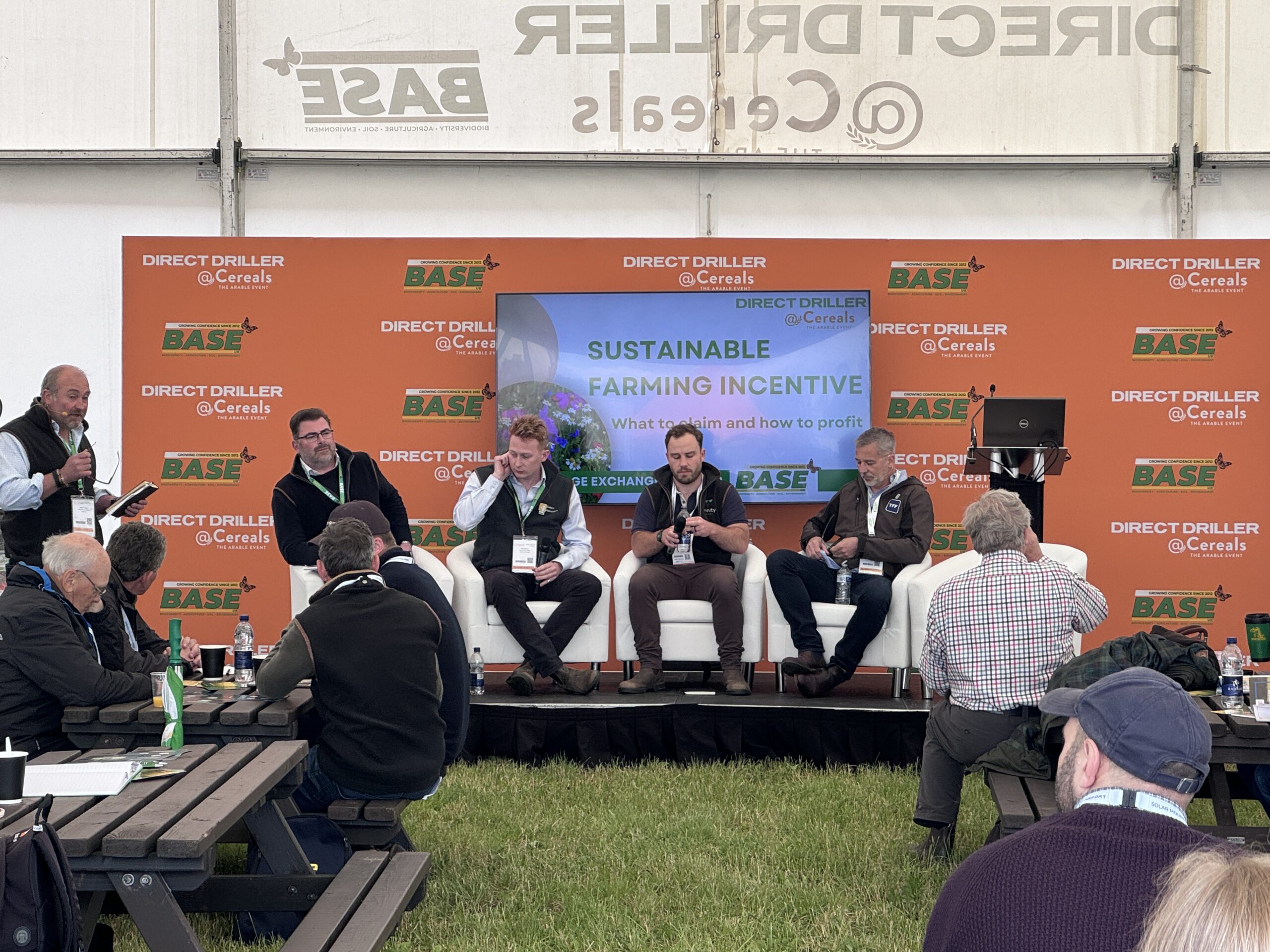
Your SFI questions answered at Cereals
The new regen agriculture section at Cereals provided growers the chance to receive advice from well-known regenerative farmers and industry experts. We pick out some of the best tips from a session about the Sustainable Farming Incentive
Written by Mike Abram
How to maximise the benefits from the Sustainable Farming Incentive and make it work for your farm situation were understandably key topics at the regenerative conference arena at Cereals.
While some detail about the new SFI2024 offer was still lacking at the time of the event thanks to the then forthcoming General Election, speakers on each day discussed how to profit from SFI through implementing regenerative farming practices, as well as other stewardship measures.
Here are some of their tips.
- Do your homework
Look for options that could help your farm de-risk, and those that improved and benefited the farm’s most important asset: the soil, suggested Elliot Taylor, a farm business consultant for George F White.
“There are lots of options available – over 100 in SFI24. So is it straightforward? No, the scheme can be complicated, not least because you can have multiple schemes with different timings,” he said.
“It is important to do your homework, and how will it affect you farm business moving forward.”
Think through the impact of options, agreed Cambridgeshire farmer Martin Lines. “For example, the direct drilling payments will lock you into three years of direct drilling a field. Some of our fields will need some tillage on the headlands this year where we’ve made a bit of a mess.
“It’s important to understand where you want to take your business because while you can add more options every season, you can’t remove them [completely] once you’ve signed an agreement.”
Post-Cereals Defra clarified that options can only be added by taking out a new agreement, rather than as an addition to an existing agreement.
On Hope Farm, the farm Georgie Bray manages for RSPB, the direct drilling option wouldn’t necessarily fit because of the need to cultivate in organic matter to fit with Farming Rules for Water.
Keeping nutrients in fields and lose as little into watercourses as possible, as well as looking after the soil were key aims on the farm, she said. “Thinking about what you want to achieve and seeing what options are available to deliver that means we can be more strategic in our approach.”
2. Look at options as fixed or movable assets
Martin is using SFI and other schemes to make the farm’s whole landscape more productive and profitable. Less productive areas have been taken out of production, while fields have been squared by GPS to maintain full combine header widths.
“I’ve looked it as fixed assets and movable assets. Shaded corners, buffering water courses, wet holes and awkward field corners are my fixed assets – they’re going to stay in stewardship, so which options can I use to provide long-term delivery?” he said.
“And then the rotational options – cover crops, herbal leys and legume fallows – are the movable assets.
“Don’t be overly ambitious in the way you use them. If the wheat price goes through the roof, you won’t be able to react if you’ve committed too much to these schemes, as you can only reduce areas by 50% from one year to the next.”
On his farm around 10% is in habitat options, between 10-20% in rotational options, with the rest of the land cropped.
That 10% was a good number, Georgie suggested, with research suggesting that was what was required to help nature recover on farm.
“If you had 2% down of your land down to a winter bird food mix, which is paid well through SFI that’s enough for farmland birds to get through winter and help populations recover, and it’s about 4% for wildflower margins.”
Putting too much of the landscape into wild bird food would provide too much seed and encourage rodents, and in the medium term likely create weed problems, she warned.
“That’s why putting some of these options into rotations and following advice on what percentage you need is the best way to go about this.”
3. Talk to your landlord
Landlords are seeing SFI money as part of their income stream, so discussing what’s involved with them is vital, Martin stresses. “This isn’t free money. BPS was free money, basically – fill a form in, do some cross-compliance. While cross-compliance is staying, there are costs to doing a scheme, which are important to communicate to your landlord.”
It could require a shift in contract types, he suggests. “Where we have contract farming agreements, we’re moving those to share farming agreements because as a contractor I want to be part of the decision-making of how we make profit out of all the farmed landscape.
“I see myself as an asset manager of natural capital. What can we grow crops on? What can we grow bees and butterflies on? Can those bees and butterflies increase my yield, so I don’t need insecticides? We need to stack those options into the business plan, even if it makes things more complicated.”
4. Draw a map for different options and schemes
With the potential for lots of different schemes, agreements and start dates, possibly with different rules and standards to comply with, effective management will be crucial.
One of Martin’s solutions to help his staff and others involved on the farm with the complexity is to draw a map with the options clearly marked so everyone knows what and where each one is happening. “There are some apps that are helpful too.”
One example was an app developed by Hedgelink, Georgie suggested. “In terms of mapping software, there’s the Land App, but I think Google Earth is brilliant. It’s free for everybody to use, easily shareable from your phone.”
She also uses a spreadsheet with a list of what needs doing in which month, which can be used to create task lists for contractors or farm employees.
5. Consider collecting baseline data
Both Martin and Georgie were collecting baseline environmental data, which would help demonstrate improvements over time.
RSPB had set up monitoring programmes for butterflies, bumblebees, and birds which were helping to understand what made most difference, Georgie explained.
Martin had used volunteers doing surveys to obtain similar sorts of data, plus more recently using electronic devices to monitor bird songs. “It’s about understanding what you have on farm. We’re going to have to show the public the value of their money for public goods, and showing how things are improving.”
Currently Martin funds that work himself. “It helps me communicate to policy makers with evidence.”
Defra currently didn’t have a proper baseline to assess whether the actions were delivering on-farm, he suggested. “It is spending money without a known outcome, which is going to be challenging in the near future for the Treasury,” he predicted.
Georgie also agreed that it would be difficult for the government to know what difference was being made, but stressed it was important farmers did use the money to deliver a benefit.
“If we can show, for example, national bird survey trends are improving as a result of SFI that will tick a box for us and hopefully help secure more money in future.”
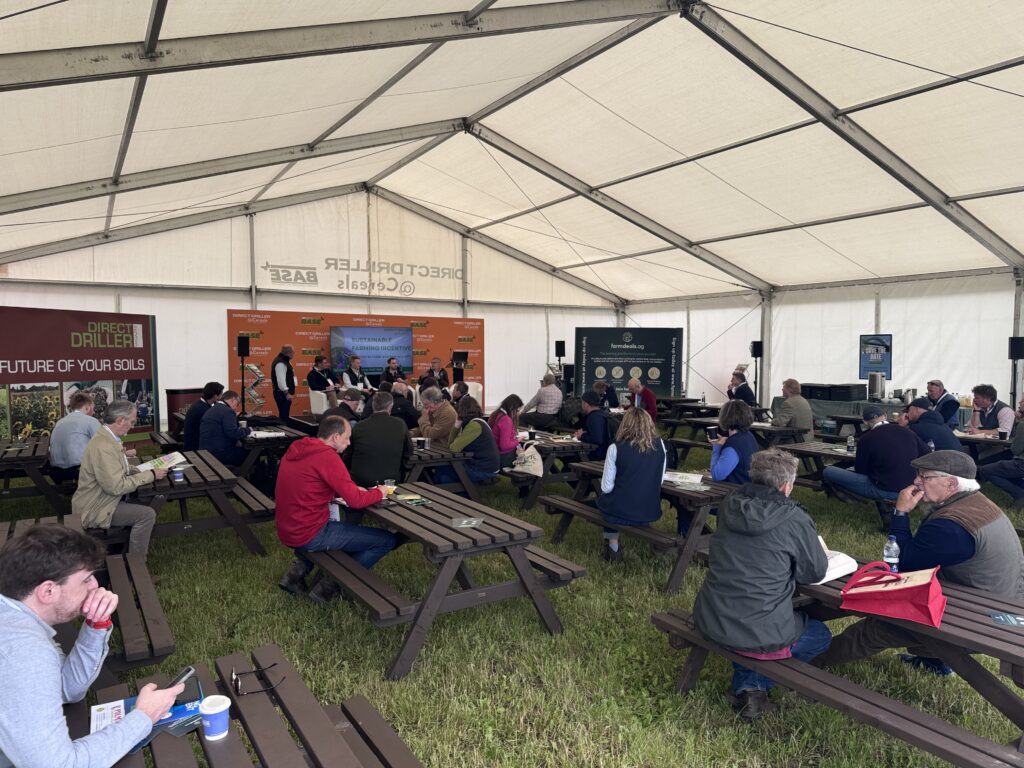
6. Look at the wider benefits
Options can provide much wider and longer-lasting benefits than just the immediate aim, Martin suggested.
For example, an overwintered cover crop, followed by spring and summer fallows or cover crops, while not providing as much income may help deal with weed issues and provide entry into a cheap, low input first wheat.
“Diverse cover crops have provided 80-120 kg/ha of additional nitrogen, grazing with sheep another 20-40 kgN/ha, and where we’ve included manure up to 260 kgN/ha by improving soil health.
“So don’t look at an option and think I’m going to make X out of it; think about how it will fit into your rotation. We are not going to be paid for doing this forever, so use it to get the farm into as resilient a place as possible over the next three to six years.”
7. Join a farmer cluster
SFI was not likely to be the only opportunity for funding for natural capital, with biodiversity net gain, nutrient neutrality and carbon schemes all at various stages of development.
Before entering into SFI schemes it was worth assessing the farm for areas that could be suitable for those other schemes, Elliot suggested. “It is important to think about those areas and the advantages there potentially could be from those opportunities.”
Keeping in touch with those opportunities was easiest through local farm clusters, Georgie suggested. “The opportunity for bigger funding pots is going to come through farmers working together. Farmer clusters are on the front line for that kind of information, so it is worth getting involved if you have one nearby, not least because it’s hard to keep up to date on your own.”
Realistically, however, there would be relatively little money available for BNG, Martin pointed out. “It will go to unique sites near to a development, so you need to have a watercourse or some other feature in your landscape you can improve through BNG. That money is not coming to all farmers, but you can get SFI funds. Take the money while it is there,” he advised.


-
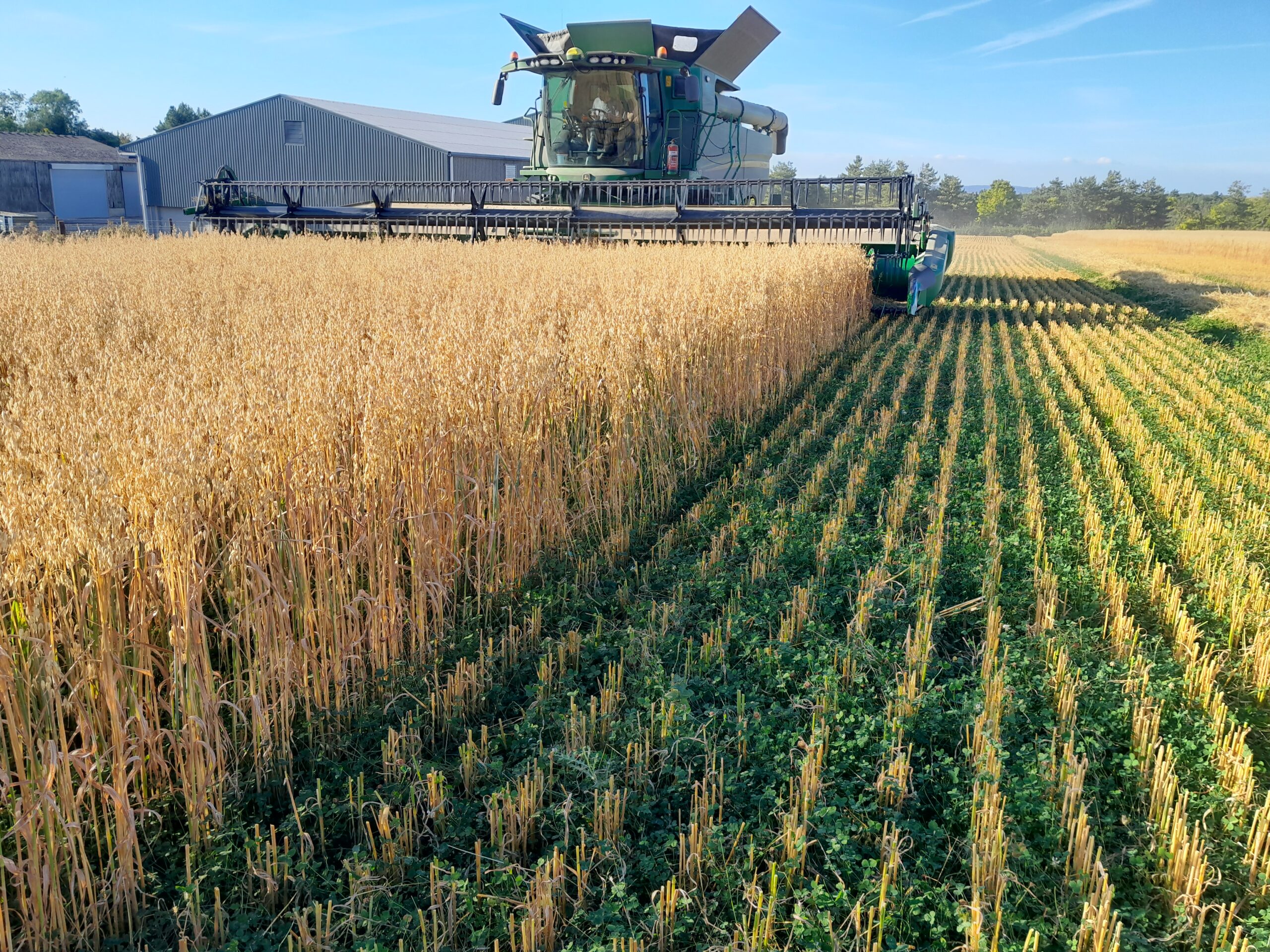
Farmer Focus – Julian Gold
September 2024
Harvest 24 has been surprisingly good. We were blessed with fairly good weather conditions for cutting most crops and yields have been respectable ( Mostly around our 5 yr rolling average yields) Most pleasing crop was the Oilseed Rape; The whole 134 Ha was really even from day one and ripened so evenly that none of it was desiccated. Average yield across the whole area should be comfortably above 4 t/ha ,all in all, probably the most successful crop of OSR I have ever grown ( Have been growing it for 42 years )
This years crop got away well but we are now losing areas to slugs and flea beetles so the OSR roller coaster continues………
Other take home messages from harvest are that drilling late in spring is not necessarily catastrophic as both our Spring Barley and Spring beans yielded respectably from mid April planting ( Approx. 7t/Ha and approx. . 5 T/Ha respectively ) We also found that our wheat variety blends have tended to yield better than straight varieties. ( Main blend for Harvest 24 was Graham/Gleam/Champion )
We continued with lots of tramline trials again this year. NUE trials in Wheat looked at R leaf, SR3 ,Blue N and QLF Boost.
R Leaf , SR3 and Blue N all seemed to give very slight yield increases compared with control strips when used individually but when I layered them all together there was no additive effect which was disappointing.
For the second year running QLF Boost gave a yield increase with the best result from a single application of 60 L/Ha around GS 31.
A growth regulator trial in OSR gave positive results for a second year with yield and Harvestability both improved by use of a specific growth regulator during flowering.
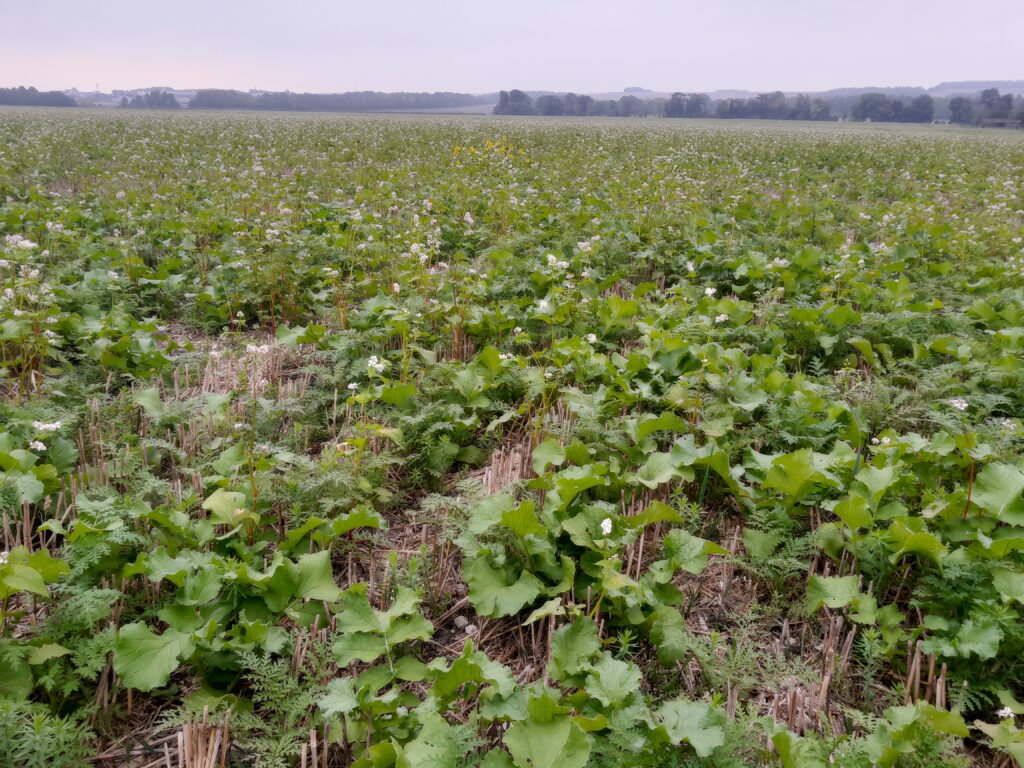
The clover understorey trial field was a success with the spring oats yielding just over 6t/ha with minimal inputs. Clover will be grazed with weaned lambs and then further knocked back by low rate glyphosate before being direct drilled with Wheat.
The area of cover crops has been reduced this year as we have dropped Spring Beans in favour of NUM 3 Legume fallows put in for two years. This should give us a comparable or better margin than Spring Beans and at the same time should give us improvements in soil health through the rotation ( Am concerned that mediocre overwinter cover crops are not in the ground long enough to give real benefits to soil health )
Our only cover crops are now in front of Spring Barley. The two blocks of cover crops we planted this year were planted a week apart on 5th and 12th of August and it has reminded me what a massive difference a few days in early August makes to establishment and growth ( See photo ) A good reminder to be always chasing the combine out of the field when planting cover crops!
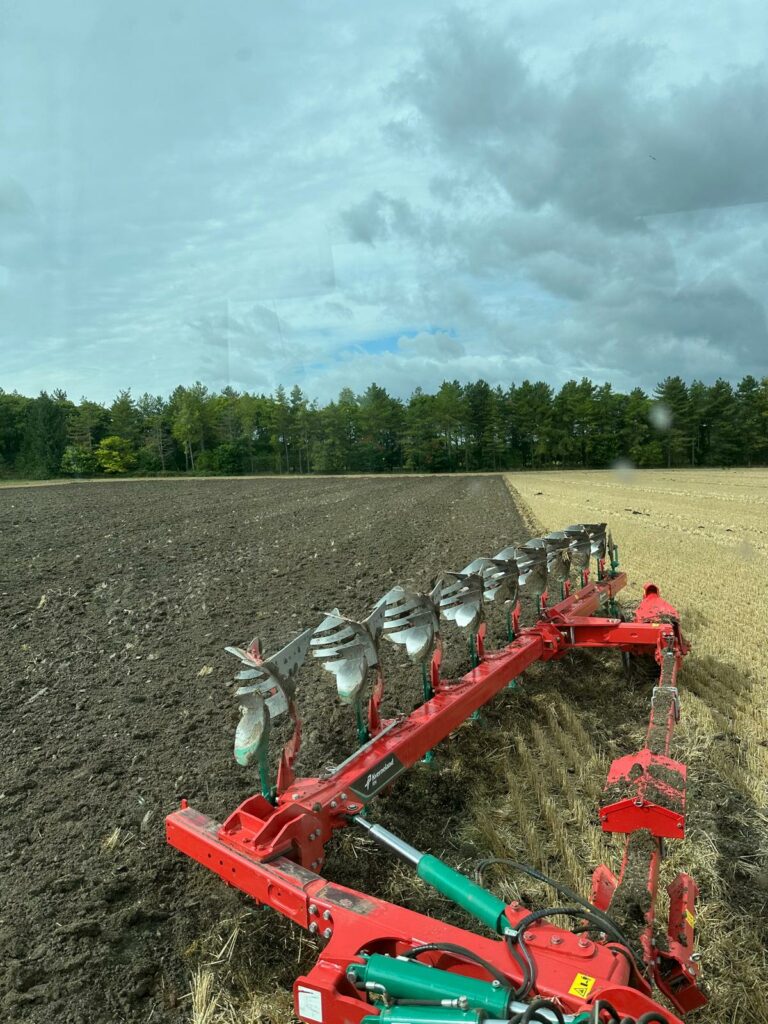
The latest SFI roll out is soaking up a lot of management thinking time. The original SFI intermediate level scheme we entered in 2022 was very straightforward . We then started a 2023 scheme in early ‘24 and am trying to put together a 2024 scheme which may start in 2025 ! ( At the same time we are running a countryside stewardship mid tier scheme )
Maybe I am stupid but quite frankly I am getting more and more confused with all the schemes and rules and unfair discrimination caused by the RPA not being able to cope fairly with multiple features in fields encompassing countryside stewardship and SFI schemes. The flexibility of the scheme rules and the ability to start schemes at any time of the year is also causing me a lot of head scratching as to how to enter options in the application ( e.g. Depending on agreement start date do you enter overwinter cover crops that are in the ground or ones that you are going to plant in next 12 months etc )
I am starting to see SFI as a combination of “ The tail wagging the dog” and “ trying to chase the elusive pot of gold at the end of the Rainbow “
It’s a shame , particularly because the RPA have tried to make the environmental schemes more accessible for farmers.
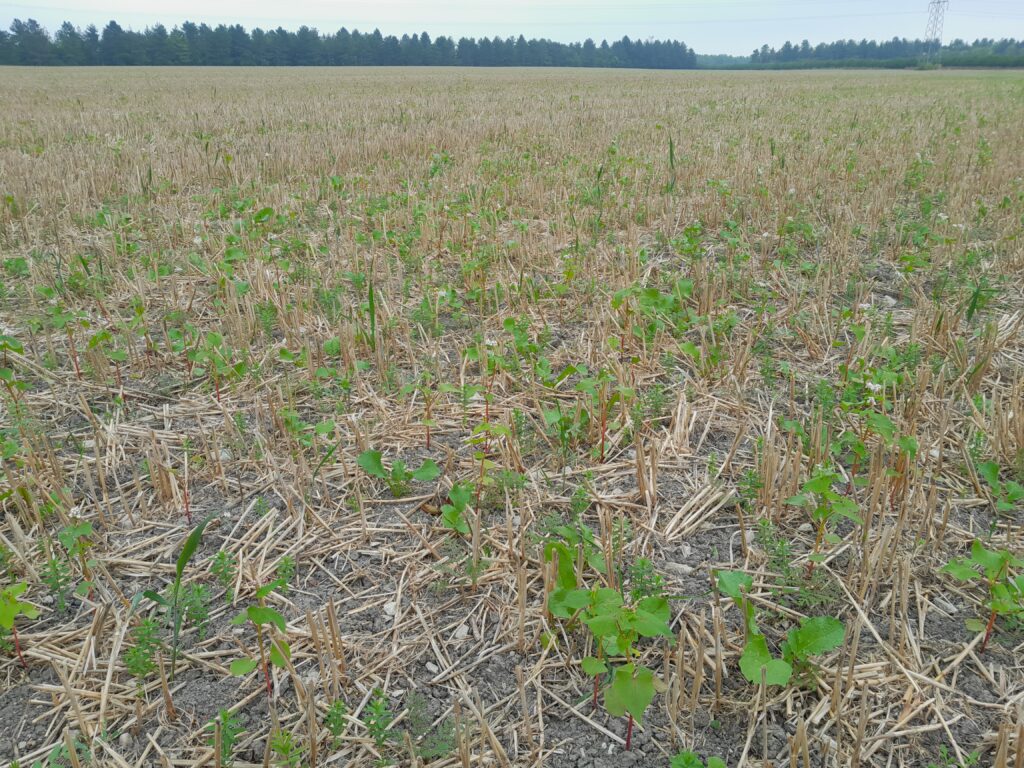
Another problem with SFI is that the flexible and “ wishy washy” rules enable Farmers to play the system for financial gain against the spirit of the scheme. For example, where farmers are planting NUM3 in spring and taking it out in September to plant wheat, or where companion cropping consists of sprinkling a few winter beans in a winter wheat crop and removing them at the earliest opportunity in spring , clearly not what the RPA intended with the options.
Off the soapbox and back to practical farming ; We organised a demo plough this year and ploughed a field for probably the first time in about 20 years. It is a field with a little patch of stubborn blackgrass and it will be interesting to see if the plough “ Reset Button” will fix the problem .
I know the die hard Regen Aggers will throw their hands up in horror but I can seriously see a return to rotational ploughing as a useful tool to re-instate in our farming system. I cannot see that occasional ploughing in a farm system that is concentrating on soil health and building OM is much worse than using multiple Glyphosate applications and spending around £100/Ha on herbicides to just kill blackgrass.
For the last 4 or 5 years we have been running a trial trying to compare a lower N and lower fungicide approach against our farm standard, i.e. looking to see what would happen if we moved the slider even further down the scale from industrial agriculture to organic farming than we are currently. ( Trial is 15Ha in the middle of a 46Ha field and stays in the same place to analyse all crops in the rotation )
Results have been very interesting and it is apparent that crops can be grown with much lower fungicide inputs and remain clean if attention is paid to nutrition (+/- Biological amendments. ) and Nitrogen applications are not excessive. Every year the trial area has a lower spend on Nitrogen and fungicides and a higher spend on trace elements and biological treatments than the farm standard but yields are always lower. Unfortunately every year the farm standard has performed better financially because Nitrogen and Fungicides are very cost effective inputs.
Where does that leave us?
Philosophically I want to farm in a sustainable way and minimise the impact of my farming on the natural environment I am working in, but I am employed as a Farm Manager to try to maximise profit. ( if I was a farm owner I could take a view that a lower profit and minimal environmental damage was an acceptable business objective )
From my experience , It is hard to see how mainstream agriculture can move en masse to a regenerative system unless the dice is loaded more in favour of sustainable farming.
This needs to be multi pronged : We need carrots and sticks from Government ( For example, better SFI schemes as carrots, Nitrogen and Pesticide taxes to reflect the carbon footprint and negative environmental profiles of these inputs as sticks ) I realise that legislation to reduce inputs is a bit naive as we are not in control of third country legislation and would put ourselves on an unlevel playing field but it is nice to dream…….
We also need a concerted effort to educate consumers so that they may be willing to pay a premium for “ half way house “ produce which is not organic but better than Industrial ag products. It is great to see Schemes such as Wildfarmed and the Green Farm Collective starting to reward regen ag farmers so that we are better able to stomach the slightly lower yields.


-
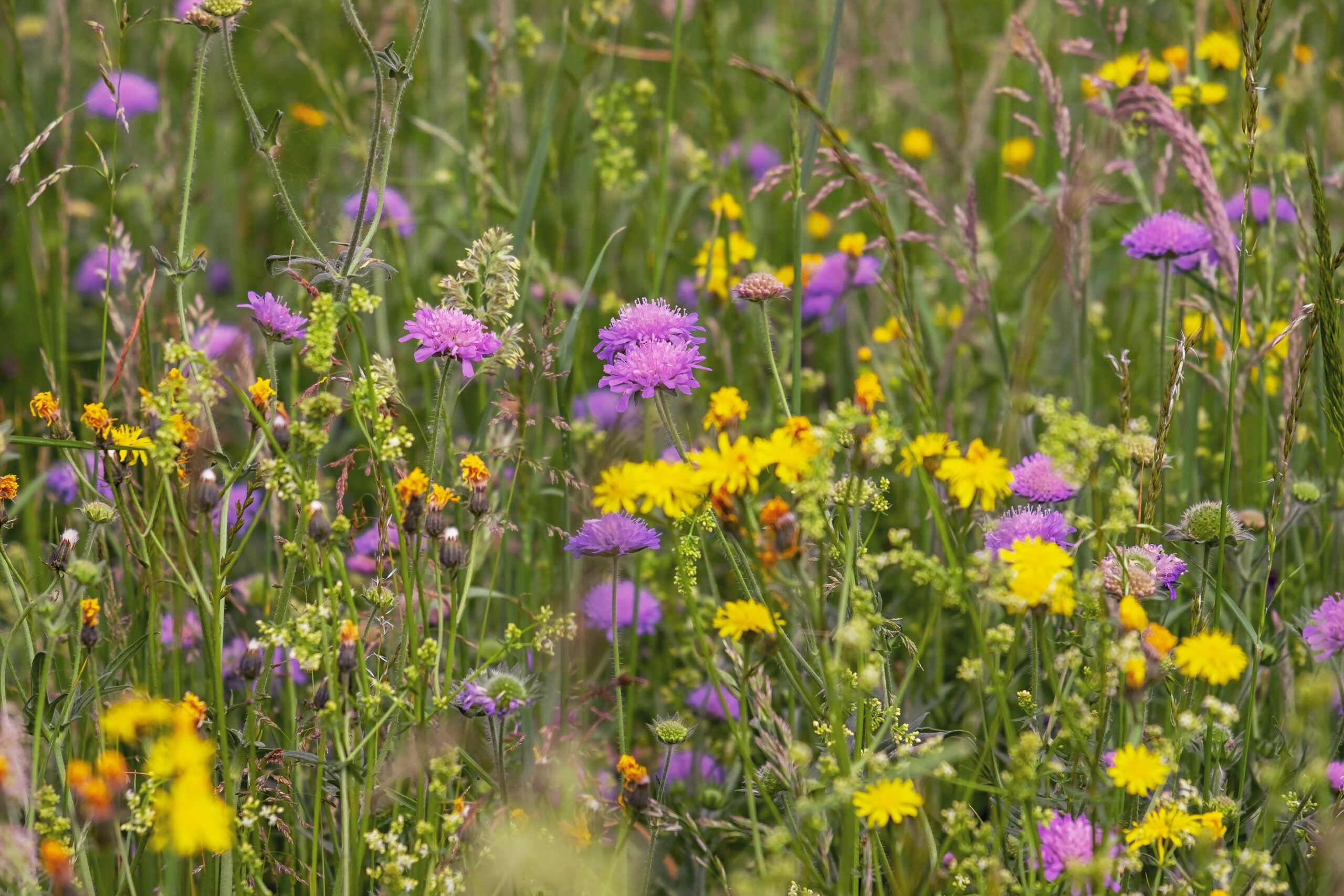
Agent in Focus – Peter Roberts
Integrating Sustainable Farming Incentive (SFI) actions into Arable Contract Farming Agreements provides a number of challenges for agreements moving forward.
Peter Roberts, Associate Partner in the Agribusiness team at leading property consultancy Fisher German, discusses the considerations ahead for farmers deciding on their best options now that Defra has launched SFI 24.
With the decline in Basic Payment Scheme (BPS) payments, many growers are now looking at the Sustainable Farming Incentive (SFI) as a way to ‘claw back’ subsidies in a different form and also to make improvements where possible to help improve soil organic matter and reduce inputs.

Contract Farming Agreements (CFA) structures have differed with BPS either in or out of the agreement, meaning in most cases farmers’ prior charge has altered usually with a larger first charge, where BPS income has been included in the agreement.
With the BPS de-linked payment continuing its staged decline to zero by 2028, this has – and will continue to – prompt a review of the CFA structure, particularly surrounding the level of prior charge and the split of the divisible surplus.
Bubbling away in the background, contractors’ costs have also risen in recent years, particularly on fuel. Many agreements are now structured with a fuel multiplier as an addition to the contract fee to support the contractors’ remuneration.
SFI income in the form of the expanded SFI 24 offer that was released this August by the Department for Environment, Food & Rural Affairs (Defra), provides a number of options that support various actions, and these need to be considered carefully to weigh up the positives and negatives.
The challenges and discussions now surround whether the SFI options should be included within the CFA, or, if they are included, whether the CFA terms need to be amended.

farmer checking his cattle It is really important that farmers give this careful consideration and don’t make a swift decision without considering various factors.
That is crucial because we are likely to see more CFA agreements in years to come. With the backdrop of a poor harvest in 2023 and similar predictions this year due to the weather we have experienced, profit and particularly cashflow are both impacted. Machinery inflation continues and with asset finance now more expensive, economies of scale are now more important than ever in arable farming.
Those businesses with no solution or those who haven’t considered future succession, particularly where this is looming, may look more favourably towards CFAs since it will offer reduced risk but they will still have the ability to retain their farming status and the tax benefits that this brings.
It is important to reflect on SFI CFA integration. A good approach is to breakdown the SFI actions (in this case those which are eligible for arable land) into the following categories:
- Management plan options
- Boundary options & smaller in field options
- Whole field options – Used as Break Crop Replacements
- Static Whole Field Options
The management plan options such as CIPM1 (integrated pest management plan) will most likely already be done annually by the contractor or by the agronomist and should be included within the CFA and any costs associated with it

Boundary options and small plots of environmental crops need to be reviewed, especially where they have little impact on cropped areas, and it might be wise to remove the more marginal bits from cropping anyway, it would be better if they are excluded from the agreement.
The farmer will then take the income for these in the N01 account and pay the contractor or another party separately for operations required to manage the options, which will be similar to the management of hedgerows which is typically outside the CFA.
Then there are whole field options which may affect yields, such as not applying insecticide or those that support the growing of a crop, such as a companion crop – typically impacting the contractor – potentially leading to an extra operation. The income and costs for these would go into the CFA.
For farmers with whole field options – break crop replacements, there are a number of factors to consider.
There are options such as CNUM3 – Legume fallow, which now looks favourable again since the latest Defra announcement has now made it rotational once more.
Options such as this can provide benefits over other break crops like Oil Seed Rape (OSR). At current OSR prices we are seeing break-even yields around the 1.3 t/ac mark over CNUM3 legume fallow. That means if farmers can’t grow OSR above 1.3 t/ac and the rotation limits greater inclusion of other more profitable break crops, CNUM3 could be considered as a lower risk alternative.
With the option being rotational and supporting entry to first wheats, the income should be included within the CFA.
But consideration should also be given to what level of the contract fee should be charged compared to other crops. A reduced rate fee and separate fuel multiplier to take account of no combining and less spraying should be considered.
Then there are the whole field options – Static Options (three years) where the existing rules allow for 25% area limit for some options – such as the CAHL2 – Winter Bird food option, which can be used as a static option, at £900/ha plus income with the inclusion of stacking options. This does offer a good margin without the yield risk versus the farmers’ return out of CFA and could be looked at being treated differently to a break crop option.
Taking land out in this way will not be popular with contractors, and consideration should be given depending on how big the 25% is and how it would affect the contractors’ business because many of their costs will still continue to be incurred.
There will be more weighting where a CFA is being retendered and the farmer opts to take out up to 25% with plenty of notice, rather than part way through the term and many agreements will have a permanent withdrawal limit, which will need cross checking.
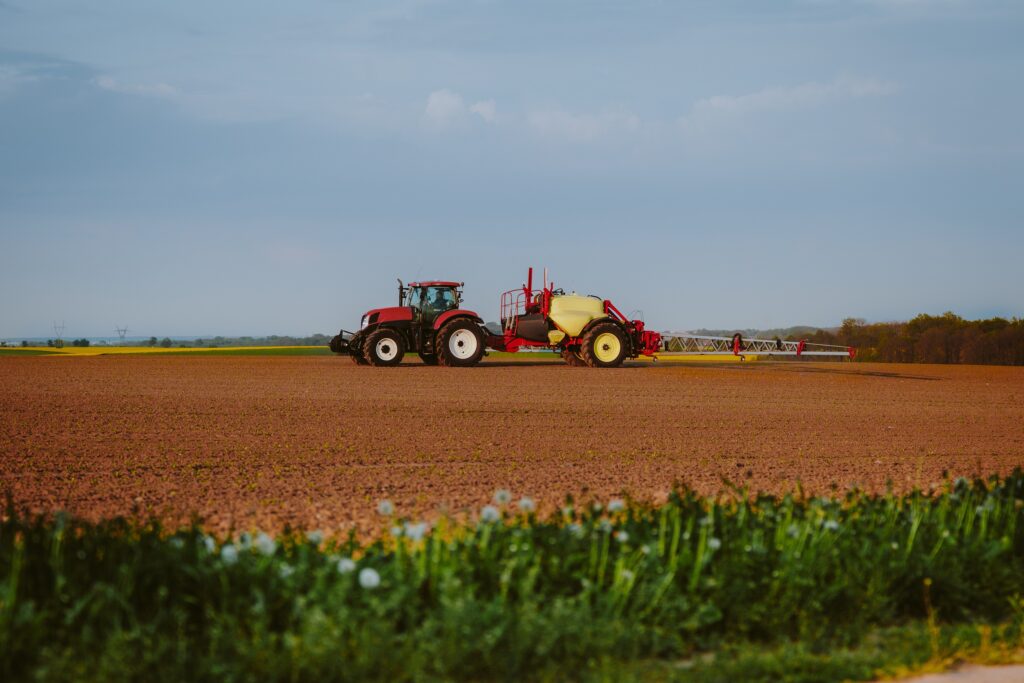
Farmer working in field with tractor agriculture So, in summary, historically the BPS, with values back in 2020 at £93/ac has helped prop up farmers’ returns in poorer farming years, whether the BPS is in or out of a CFA agreement.
With this now going, many more farmers in CFAs should look at:
- Firstly, entering into an SFI agreement to generate income, in most cases for activities that are already being done.
- Many of the actions require the contractor’s input and, in most cases, bar boundary features, the income should go into the agreement.
- If the farmer is offering such income, it will support their level of prior charge.
- Larger removal of land into whole field static options out of the CFA needs assessing carefully, particularly if a farmer is part way through an agreement.
- But with the existing working capital required to fund combinable crops, and the difficulty of the last two seasons, larger scale static SFIs on the more marginal land could be considered if it is appropriate with the farmer’s relationship with the contractor.
All of this may seem complicated and with Government advice being updated, it is important for farmers to gain expert advice to make sure they are making the right decision for the short and long-term future of their businesses.



-
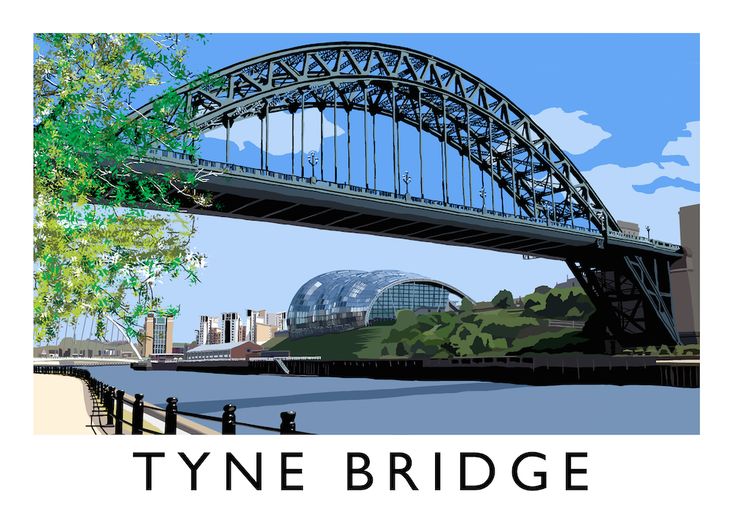
BASE UK
We are the premier organisation, dedicated to promoting independent, farmer led, regenerative agricultural knowledge across the UK.
Our mission is to enhance soil health, increase biodiversity, and support businesses by embracing sustainable farming practices that benefit both farmers and the environment.

BASE-UK are pleased to announce the sponsorship of Joe Collins and the Harper Adams Conservation Agriculture Systems Experiment. Sponsorship of this experiment ensures the continuation of this Farmer-led on-farm project, therefore building on the existing dataset, which is useful to farmers in aiding and advising on the transition to conservation (regenerative) agriculture.

Joe is a final-year PhD candidate funded by the Midlands Integrative Biosciences Training Partnership (MIBTP) and a Senior Research Associate at the Earth Rover Program. He has an MSc in Sustainable Crop Production from the University of Warwick and a BSc (Hons) in Agriculture with Crop Management from Harper Adams University. He has over ten years of experience working in the agricultural industry in the UK and abroad.
Joe’s PhD research is titled “A Systems-Level Evaluation of Conservation Agriculture in the UK” which involves multi-disciplinary research on agronomy, soil science, economics, and greenhouse gas emissions.
Traditionally, many scientific studies in this area only use data from a single site collected over one or two years but evidence suggests that to identify the true effects of transition to a CA system, these need to run for a longer period in order to provide better economic and physical data to assist farmers.
To find out more about Joe’s project and his recent presentation at the World Congress of Conservation Agriculture held in Cape Town, South Africa, visit our website – www.base-uk.co.uk. Joe will be presenting his latest data at our Annual Conference.
Annual Conference 2025
“Robust Farming in a Changing Climate”.
Wednesday 12th and Thursday 13th February 2025 at the Crowne Plaza Hotel, Stephenson Quarter, Newcastle. Speakers include Dr Kris Nichols, Frederik Larson, Prof Wendy Russell, John Sansome, Roger Davis and more speakers still to be confirmed. Members will receive booking information via email, and details are available on the website. Tickets start from £99. Student and Under 25’s subsidised ticket offer also available.
Look out for our newsletter! We have just launched our first quarterly edition, sent to all our members and available to anyone interested in learning more about what we do. To subscribe, contact rebecca@base-uk.co.uk
Upcoming events: from October to March, we endeavour to run webinars and weather permitting, farm walks and visits. To find out more about our program check out our website calendar.
- 17th October – Alix Ritchie, Farmstrong, Scotland – webinar.
- 22nd and 23rd November – LandAlive Conference, Bath & West Showground – Join us at this inaugural event to connect with our members, some of whom will be speaking at the conference.
- 27th and 28th November – Croptec, NAEC, Stoneleigh.
- 15th and 16th January 2025 – LAMMA, NEC, Birmingham.
- 12th and 13th February 2025 – Annual Conference.
Become a member:
BASE-UK is a welcoming and dynamic network where you can continuously learn from both peers and industry specialists whilst enjoying the camaraderie of a supportive community.
As a BASE-UK member, you will enjoy a range of benefits, including:
- Access to exclusive meetings, webinars, events, and farm walks.
- Networking opportunities with like-minded people.
- Our Annual Conference – our premier event to learn and network.
- Educational resources.
- Research – connections with Rothamsted Research, James Hutton Institute, Harper Adams University and several other research groups and universities latest research and updates on conservation and regenerative agriculture.
- Ongoing sponsorship for research undertaken by Joe Collins, PhD student at Harper Adams University.
- Forum – a private forum for discussions available only to members.
- Earn BASIS and NRoSO points annually just by being a member as well as from some of the events organised by us.
For more information about how to join visit our website www.base-uk.co.uk

-

Adapting nitrogen at Strategic Cereal Farms
Senior Knowledge Transfer Manager Henny Lowth introduces the nitrogen trials at AHDB Strategic Cereal Farms, ahead of the release of this year’s results in November.
How nitrogen behaves in farming systems is often variable and hard to pin down. With nitrogen prices stuck above pre-Ukraine-war and pre-energy-crisis levels, there is an emphasis on the nutrient in trials at our Strategic Cereal Farms.
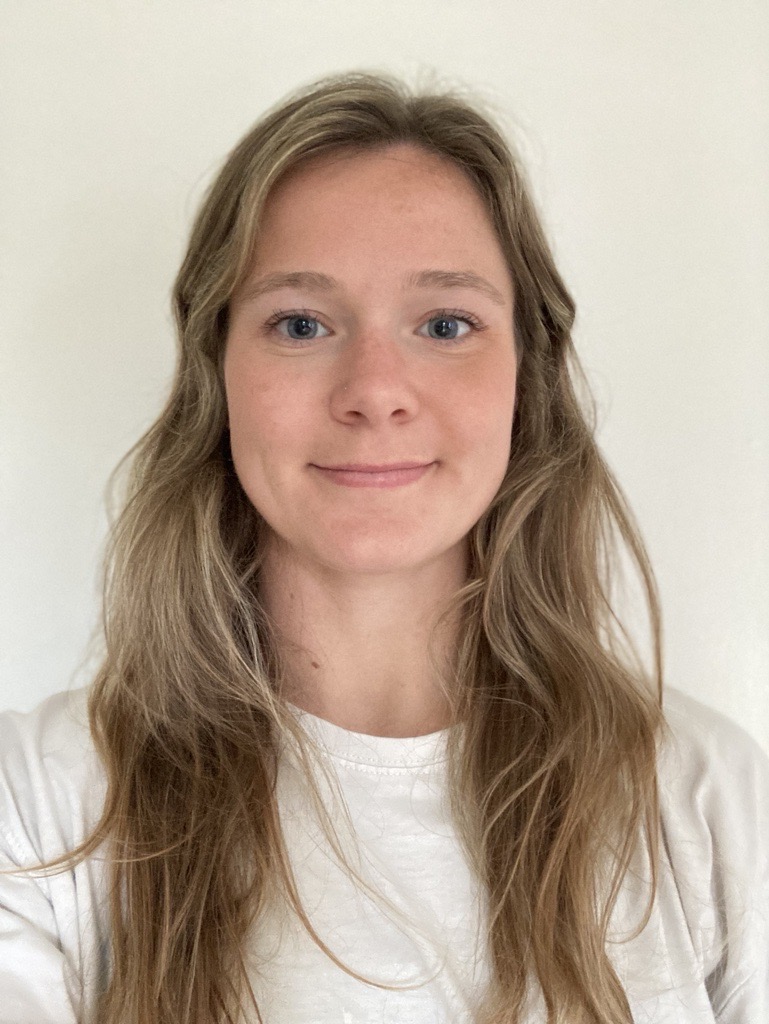
Strategic Cereal Farm North
David Blacker, who hosts Strategic Cereal Farm North (Shipton, York), had clear ideas about what he wanted to get out of his harvest 2024 crops. But, as they say, man plans, God laughs. The UK went on to experience one of the wettest growing seasons since records began. Not good news for David’s winter wheat, which was earmarked for nitrogen use efficiency (NUE) trials.
David wants to optimise nitrogen use without unacceptable yield/quality penalties or generating lush biomass that could encourage foliar disease. The initial plan was to test the efficiency of foliar-applied liquid nitrogen compared to soil-applied nitrogen and study the impact on disease pressure.
With crop condition and growth patchy and very high soil moisture levels in the spring, the replicated tramline trials were deemed unlikely to provide a fair test of the treatments. Additionally, the crop failed to show signs of a response to the 70 kg of nitrogen applied at the first split. Even after three weeks, the crop stayed yellow and was losing tillers. A soil mineral nitrogen (SMN) test suggested that most of this nitrogen was probably lost to the atmosphere by denitrification or in drainage water.
To help “rescue” the crop, we shifted the trial approach to help the remaining nitrogen applications hit the mark. We put more focus on a slow-release foliar product, which has potential to reduce the total nitrogen dose. With roots compromised after sitting wet, the season provided a fantastic opportunity to assess the merit of foliar applications.
The farm standard nitrogen treatment was 200 kg/ha, applied to soil across three splits (adjusted for expected yield, as per RB209 guidance). Two foliar treatments were also tested. Both received 70 kg of soil-applied nitrogen at the first split, with a further 50 kg/ha applied at either the second or third split. When a split had no soil-applied nitrogen, the equivalent of 40 kg/ha of foliar-applied nitrogen was applied instead. The total applied nitrogen in the foliar approach was equivalent to 160 kg/ha. The approach was reviewed throughout the season, taking crop demand and nitrogen limits (N-max) into account.

Strategic Cereal Farm East
Our latest Strategic Cereal Farm in the East is at Morley Farms in Norfolk. The Morley Agricultural Foundation (tmaf.co.uk), which owns the land, invests in agricultural research and educational initiatives for farmers and students. The farm has hosted trials since 1965.
Host David Jones now wants to dive even deeper into trialling, with the reduction of inputs a top priority. In addition to targeting herbicides (especially to manage the farm’s rye-grass populations) and pesticides (to fine-tune the aphid/BYDV management plan), he wants to reduce nitrogen use.
Like many farms, economic optimal nitrogen application rates, NUE and yields are highly variable at Morley. David wants to pinpoint the causes of variation. Thankfully, the farm has Morley Soil and Agronomic Monitoring Study (SAMS) sites to hand. Each site is about 150 m2, with the network covering areas with high, low and variable yields (and headland sites). They are a treasure trove of data, providing long-term (2018–23) information on soil assessment results, grain nutrients, yield and management records for 29 arable sites.
NUE is already assessed at eight sites, with Old Hall Piece Field particularly interesting. It was the only SAMS field (with five SAMS sites) in winter wheat for harvest 2024 and has historically variable yields and soil electrical conductivity (EC). EC is a useful measure because it can help estimate soil texture, which is linked with NUE and yield variation. The field is hosting replicated nitrogen response trials in three contrasting management zones.
The farm will also compare variable-rate approaches (against the farm standard). Many farmers now use N-sensors, which often apply more nitrogen to areas associated with lower biomass. The theory is that this will boost growth and level the playing field. As this may not be the best universal approach, the trial will examine the best way to exploit such technologies.
Like our farm in the North, comparisons of foliar-applied, controlled-release nitrogen with a traditional soil-applied nitrogen dose at the final split have also been made. A replicated tramline trial is building on this work to unpick nitrogen responses and deliver the greatest NUE. The research will investigate all elements of NUE and consider other major nutrients (phosphorus and potassium).
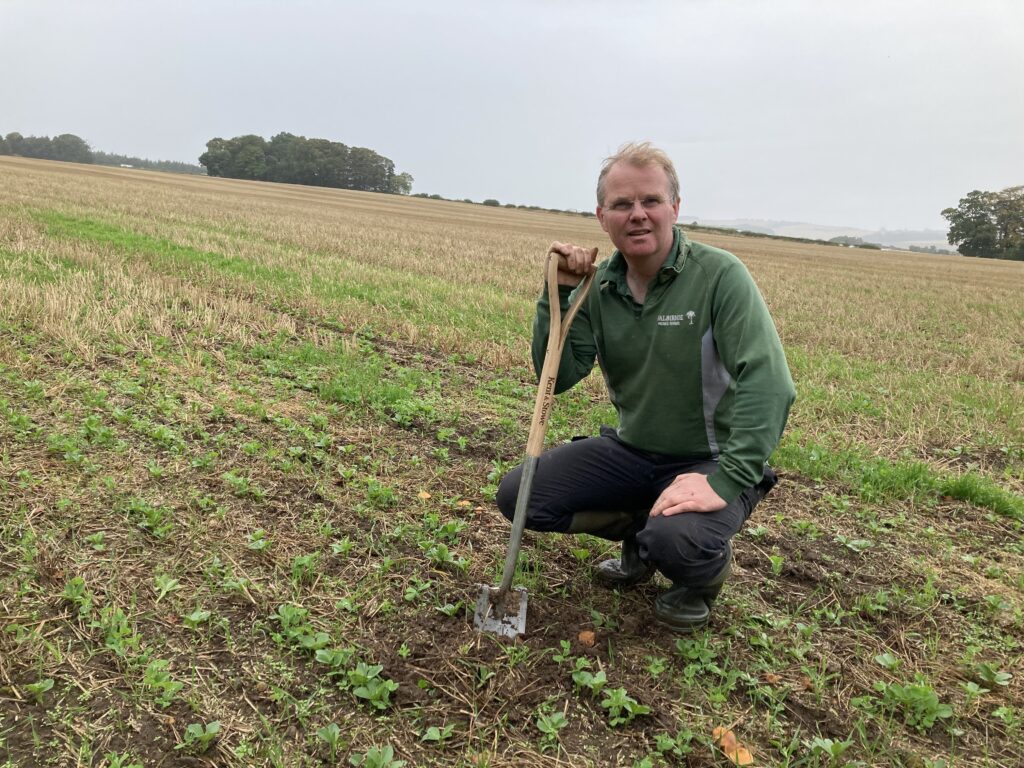
Strategic Cereal Farm Scotland
In its fourth year of a six-year tenure, Strategic Cereal Farm Scotland (located near Fife) is currently the longest-running farm on our books. Host farmer David Aglen also uses multi-season trials to compare foliar nutrition with ammonium nitrate applications. Additionally, he uses in-crop measurements – derived from a Brix meter (measures plant sugar status) and SPAD (measures leaf nitrogen status) – to tailor nitrogen. A no-fungicide treatment has been successfully overlayed in these trials, which will provide valuable data on the impact of tailored nutrition on disease levels.
Releasing results
Each autumn, we release the latest results from the farm network. This year, the findings will be launched at the inaugural Strategic Cereal Farm Conference (near York on 7 November 2024). We will discuss 14 trials from across the network, including those at Strategic Cereal Farm South, which leaves the network this year. On-farm experience will be used to answer many key questions, including:
- How can nitrogen be reduced without unacceptable yield/quality penalties?
- How useful is the mechanical weed control of grass weeds?
- What is the best way to establish and destroy cover crops?
If you are unable to join us, don’t worry – our website and social channels will provide the main takeaway messages.
The 16-strong Monitor Farm network also features several NUE trials – from adapting RB209 recommendations to using foliar nitrogen, micronutrients, ‘miracle’ products and grain nutrient data. We are also currently looking at how best to exploit sensor technologies, from soil sensors to hyperspectral satellites. There will be lot to debate during this winter’s meetings.
Our new cover crops champion network is also on a NUE journey. Supported by AHDB, the champions will follow on-farm trial design principles to assess the impact of the various cover crop approaches. We will share their journeys, from establishment to termination (and beyond) online. We have also commissioned a review to help update cover crop guidance, which will consider the longer-term impacts of cover crops on soil health, including nutrient availability.
Finally, we have conducted a strategic review of RB209 in 2024, with several hundred people suggesting how to improve the guide’s format and content. NUE is a key theme (as it was in the recent review of the Recommended Lists). There is a hunger for information to help tailor nitrogen recommendations to specific systems, farms and fields. Perceived information gaps identified include nutrient availability (from soils and organic materials), optimum application strategies, as well as the use and interpretation of in-season nutrient tests and analyses.
There was also interest in broadening the scope of RB209 to include more crops, more detailed nutrient data (beyond the high-profile N, P and K, such as micronutrients) and to help calculate the carbon footprint of fertilisers. Options on how to improve the guidance will be considered by the RB209 review committee at the end of the year.
Nutrient management is one of the most important areas for AHDB investment. This is clear from farmer responses to our new research process, which receives ideas from levy-payers and turns them into projects. In fact, it has been one of the most frequently cited topics.
Our investment will continue to evolve RB209 and on-farm practice. With more projects around the corner, it is an exciting time for nutrient management.
Further information
ahdb.org.uk/strategic-cereal-farms
ahdb.org.uk/monitor-farms
ahdb.org.uk/cover-crop-champions
ahdb.org.uk/rb209-review
ahdb.org.uk/research-ideas

